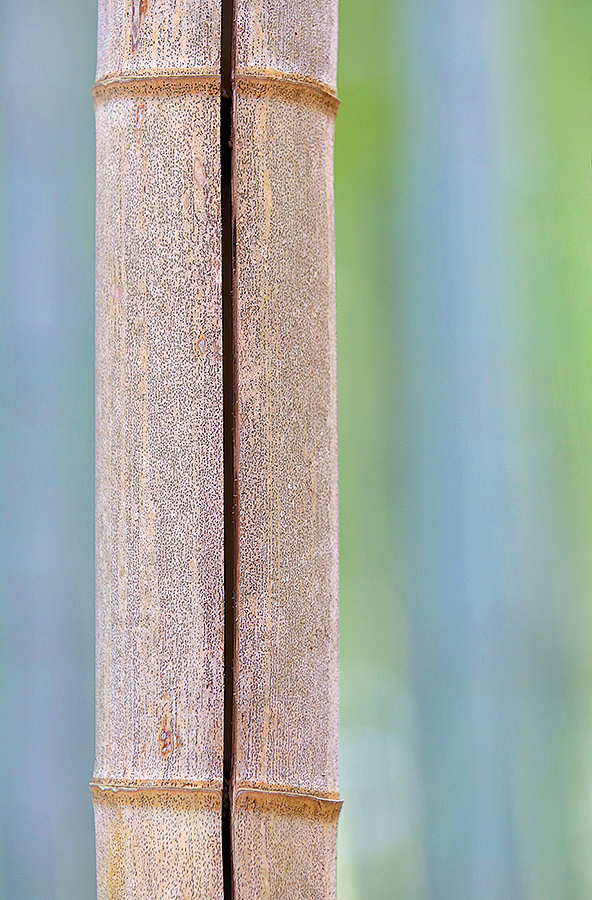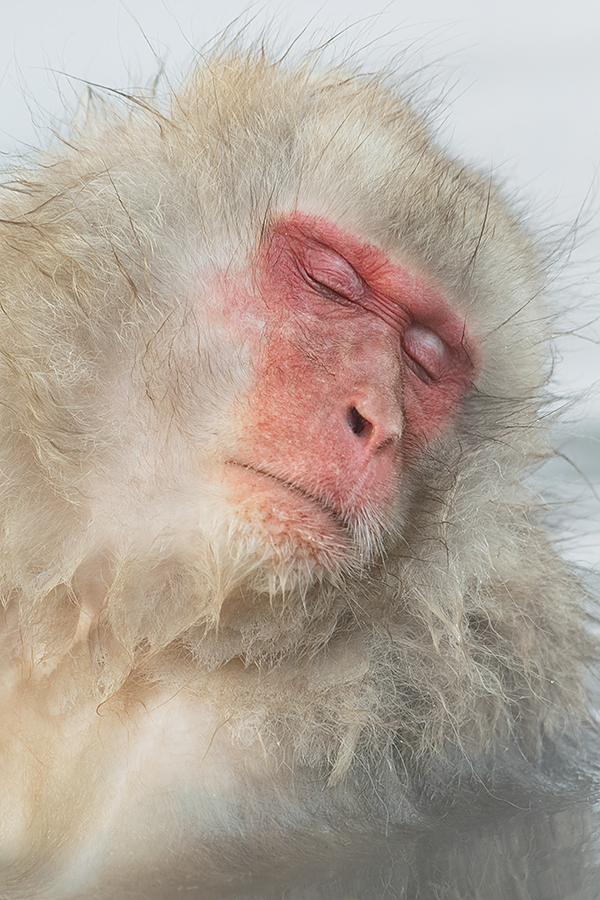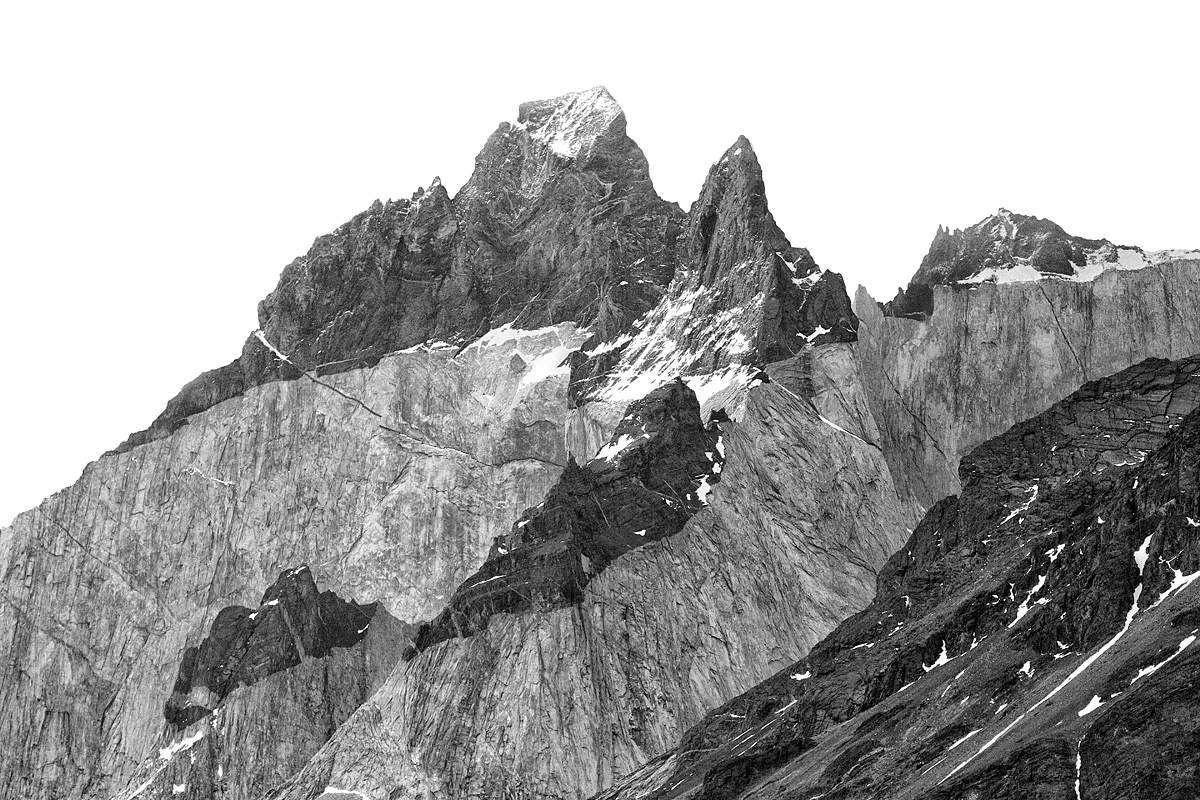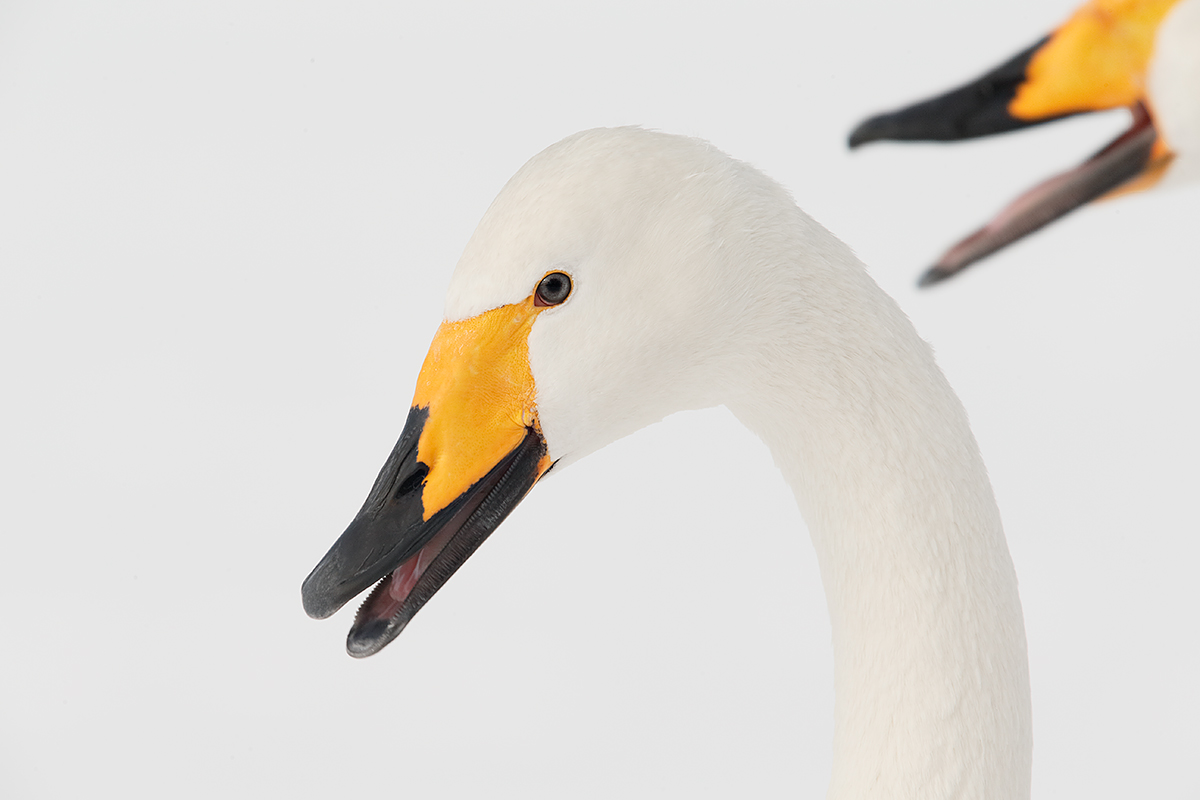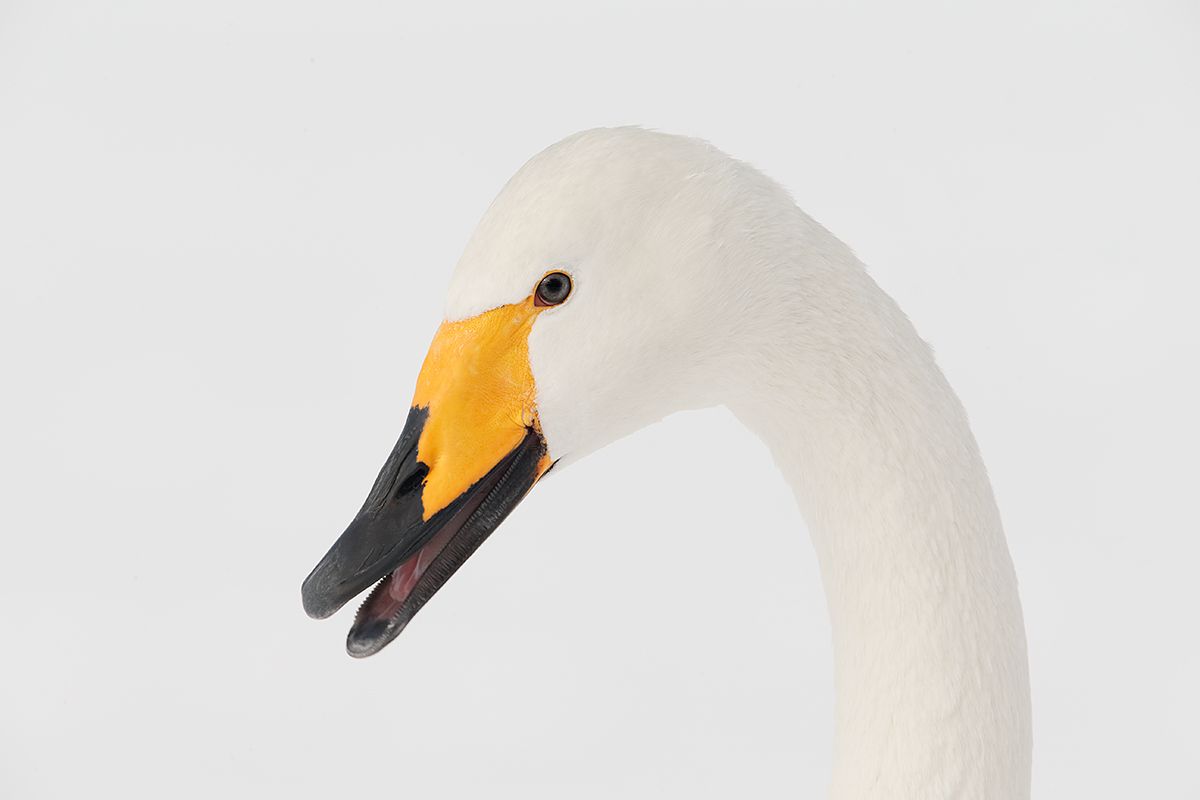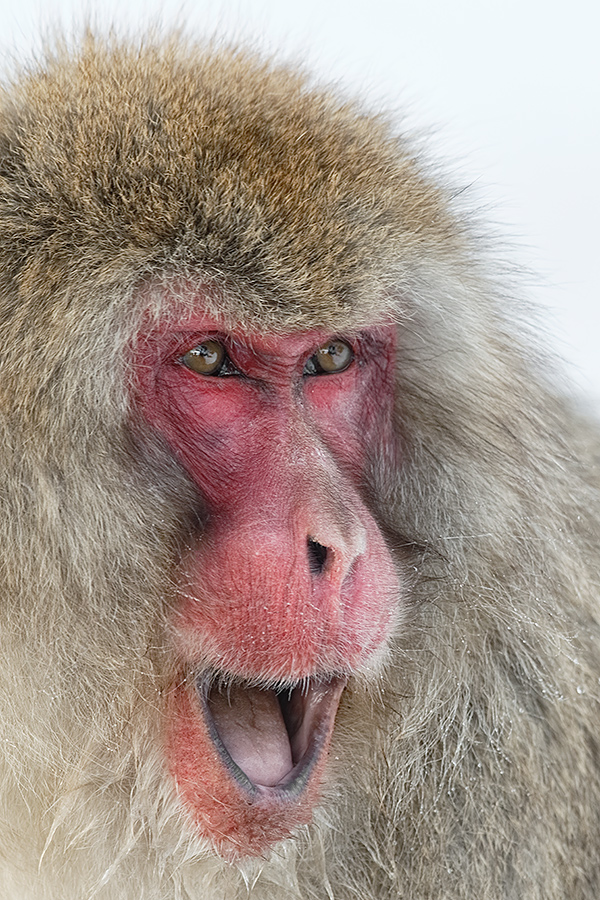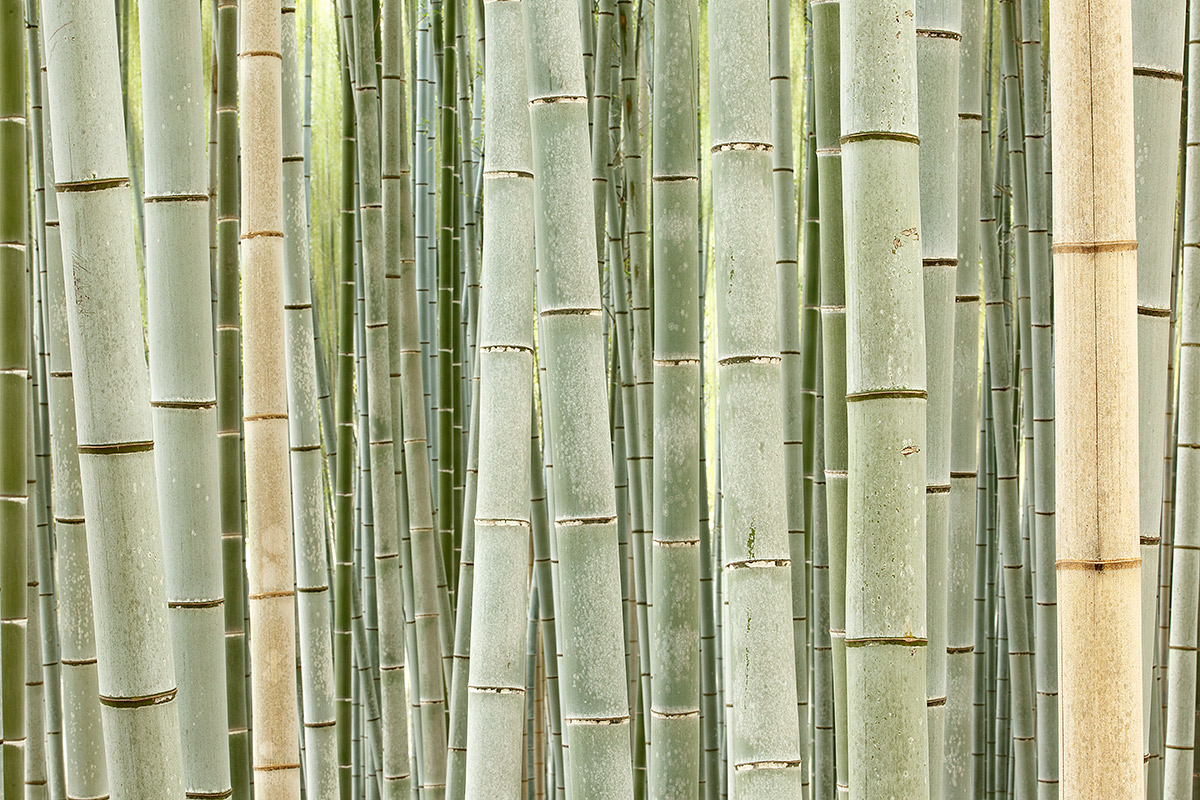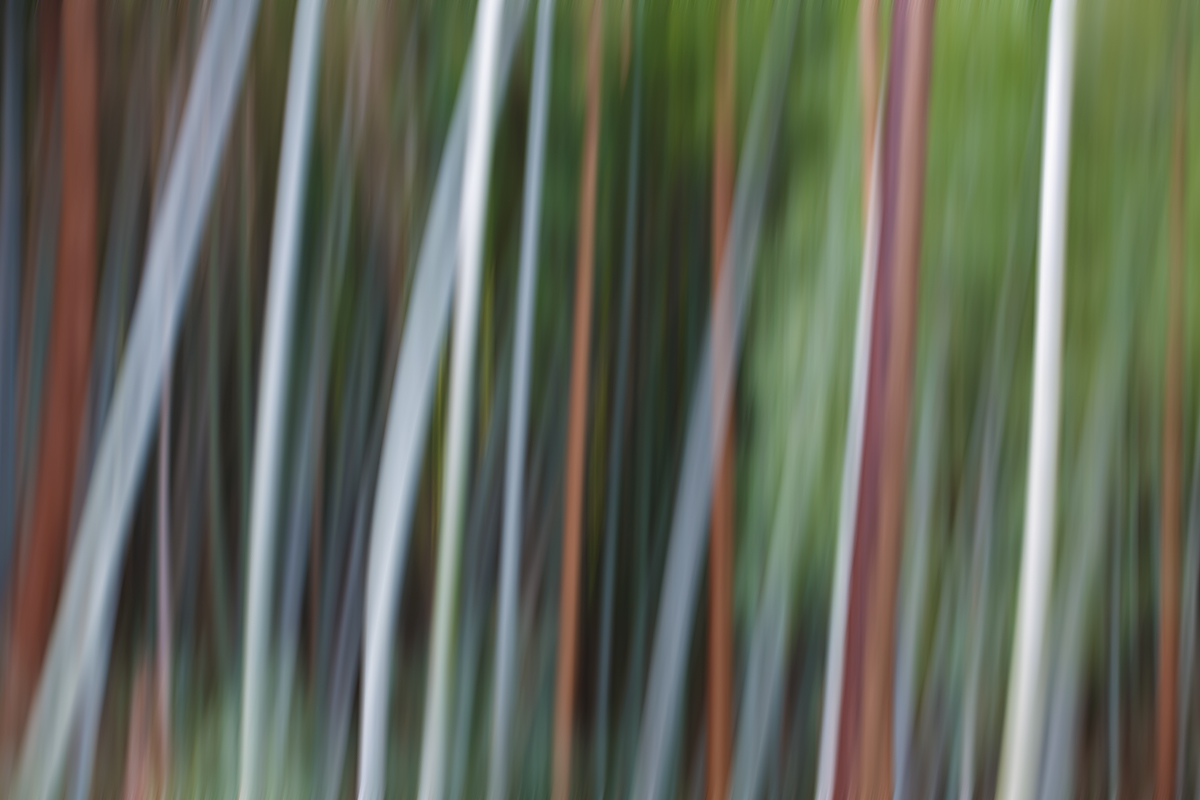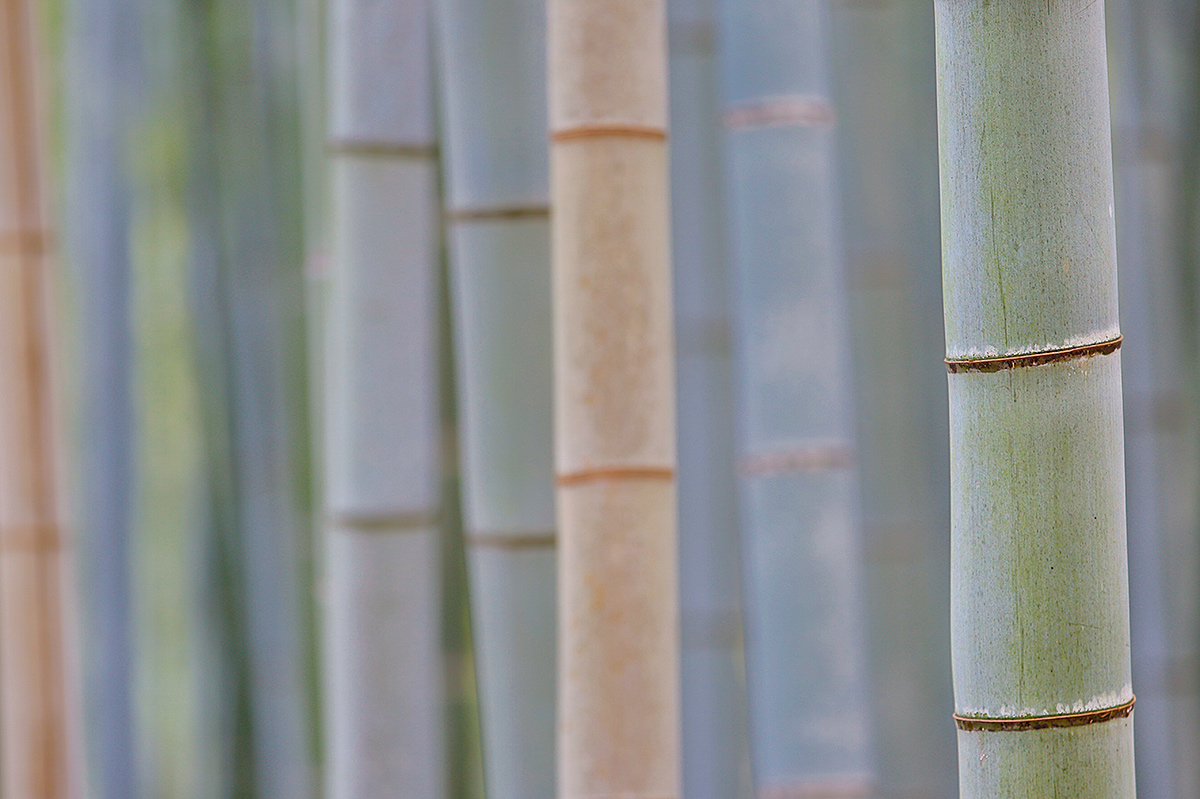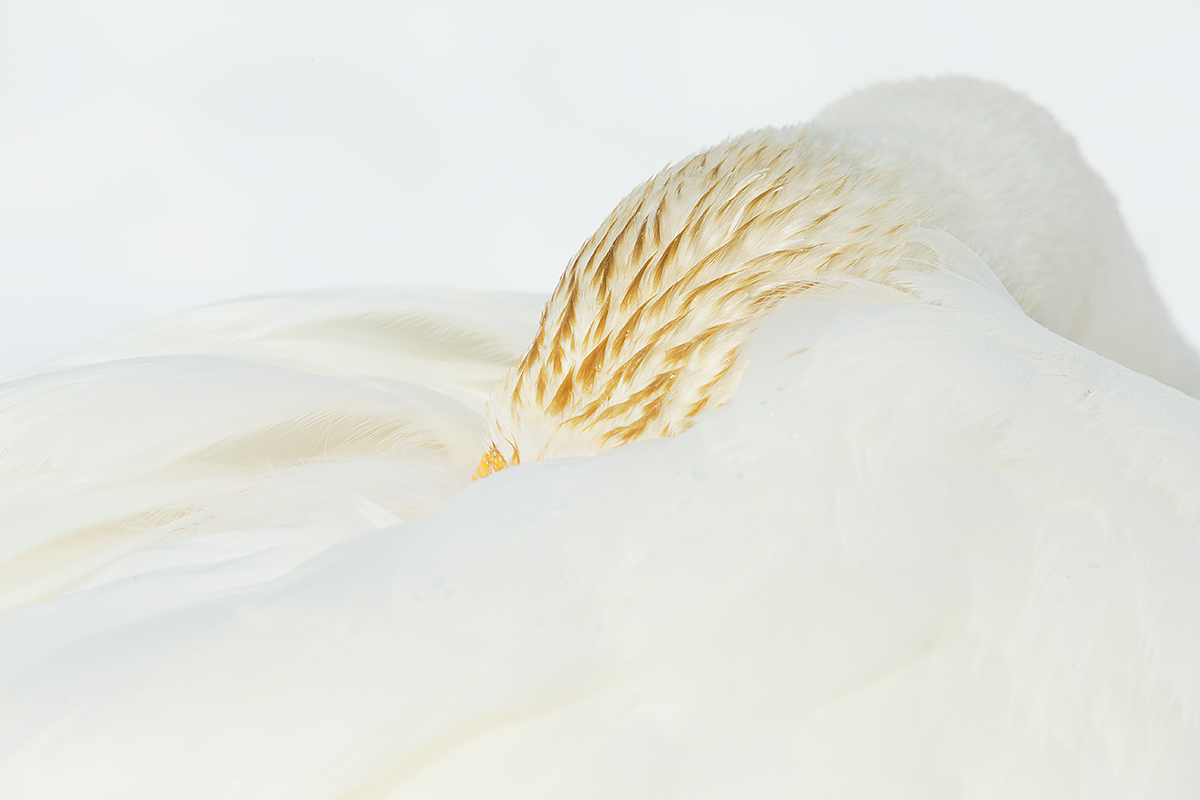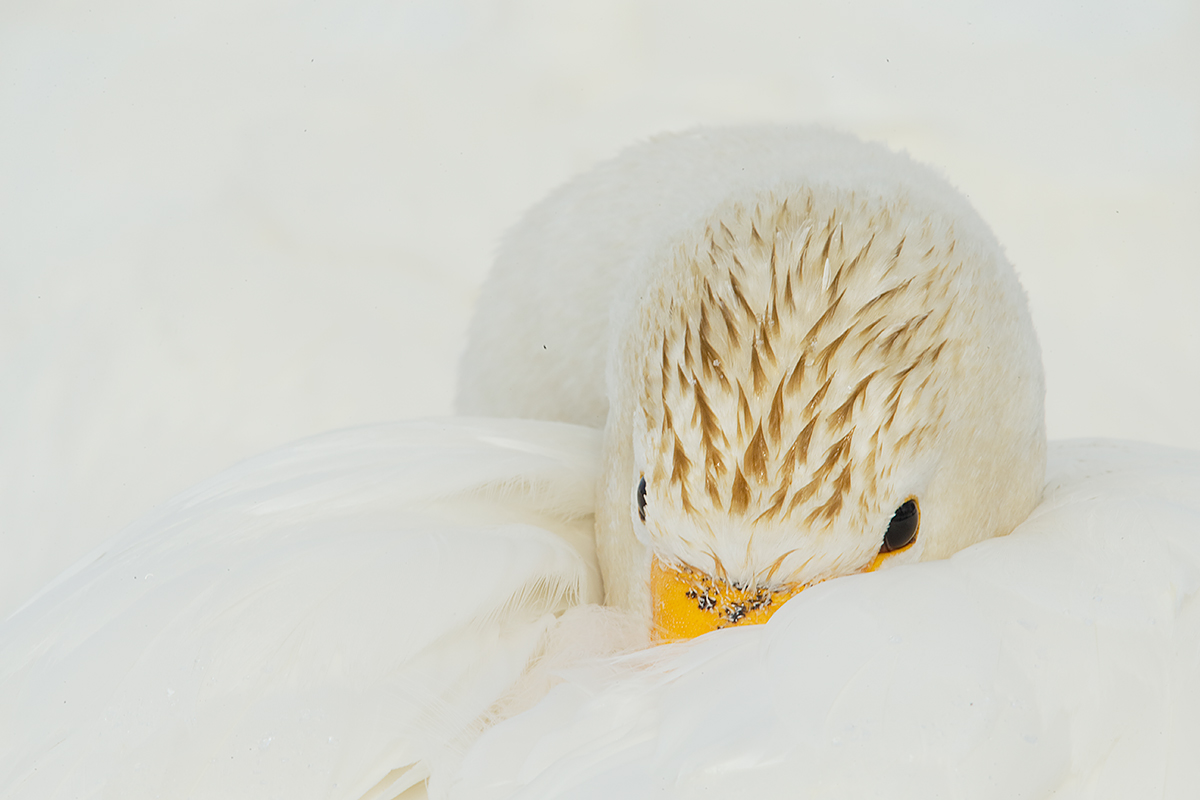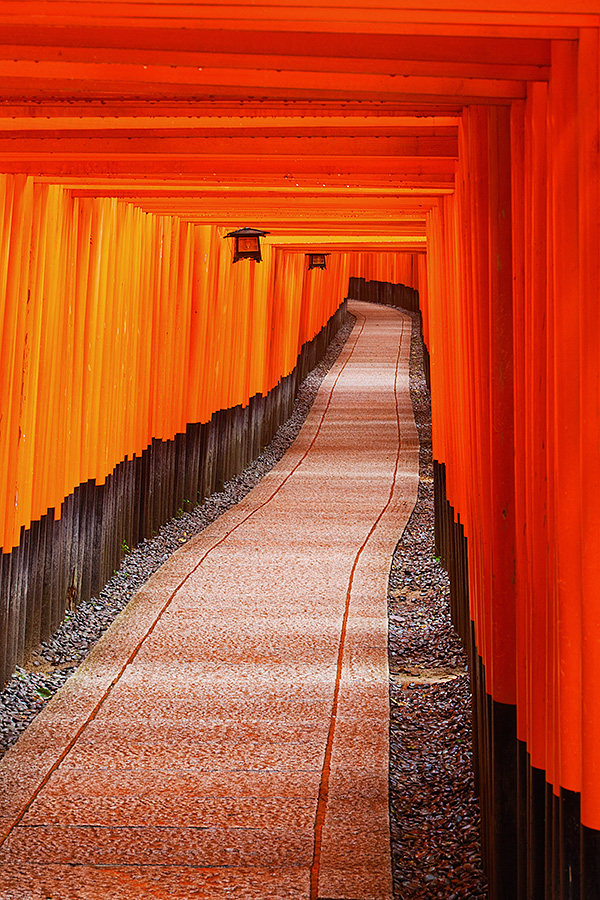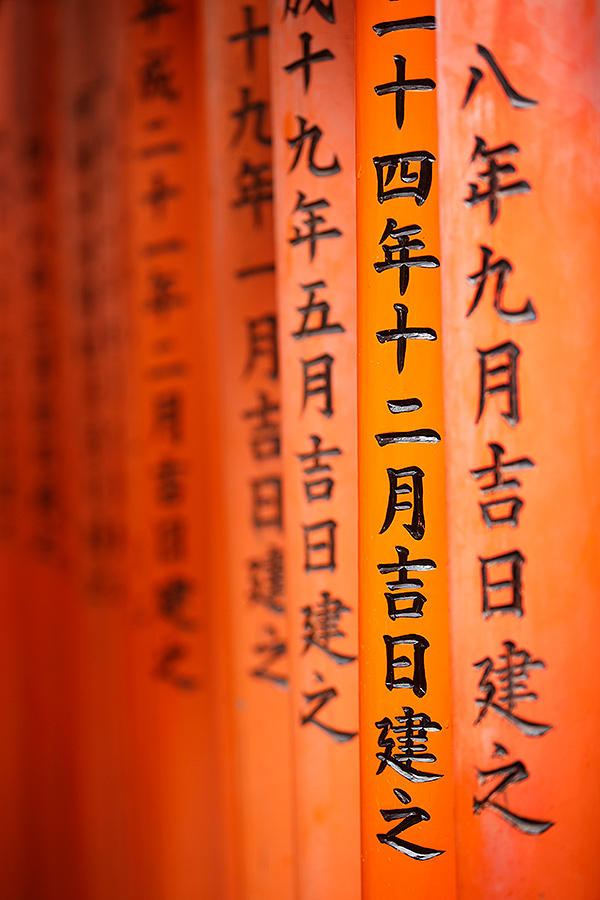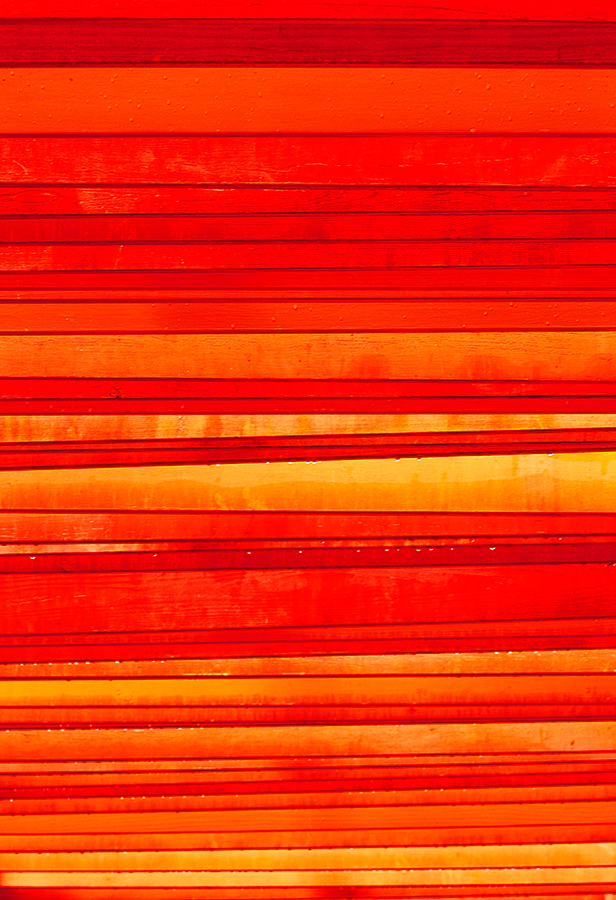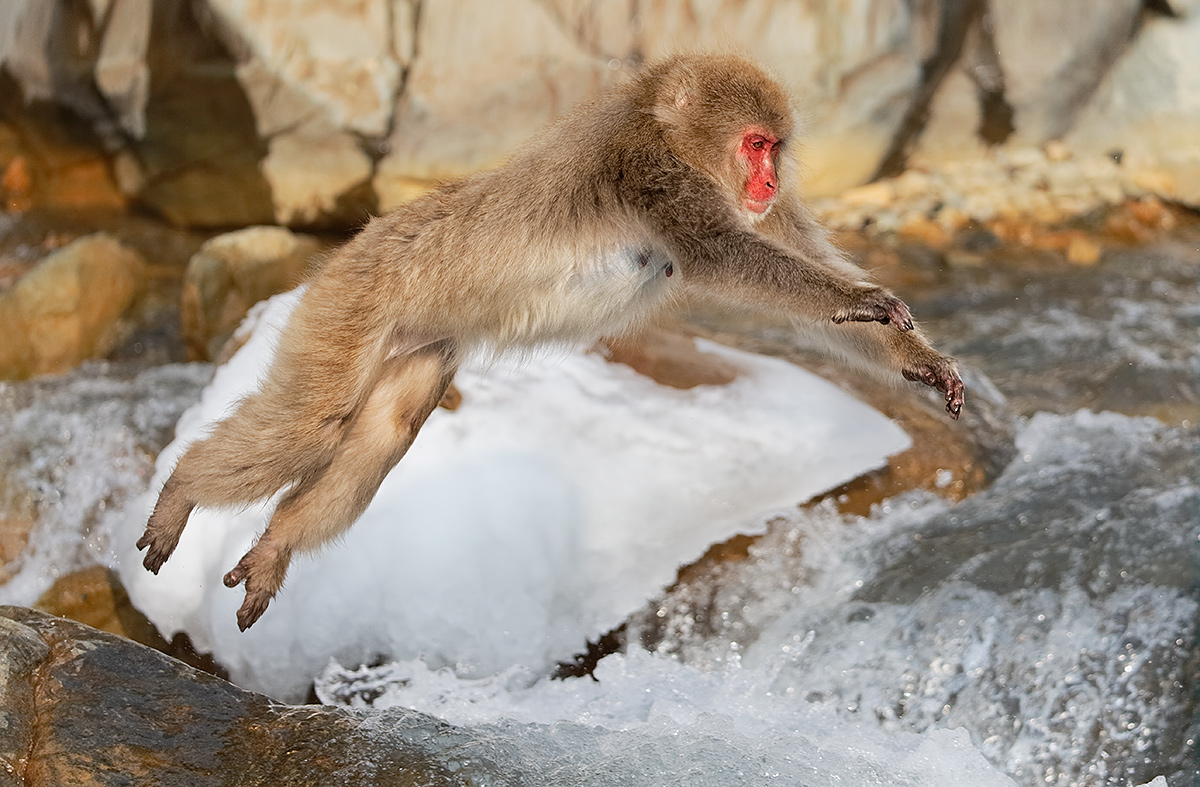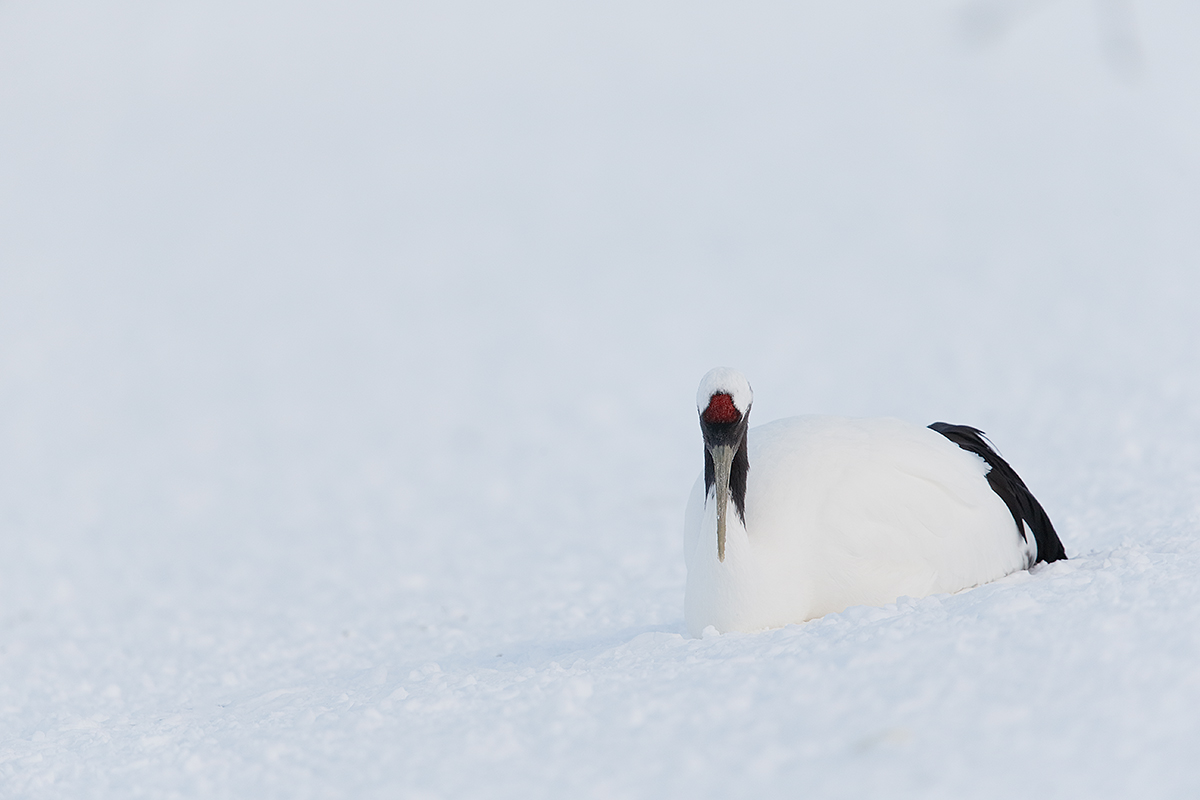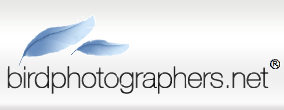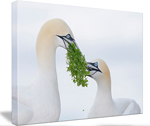March 12th, 2014 103
This post marks 103 straight days with a new educational blog post. With so many folks getting in the habit of using our B&H and Amazon links why quit now? To show your appreciation for my efforts here, we do ask that use our B&H and Amazon affiliate links for all of your B&H and Amazon purchases. Please check the availability of all photographic accessories in the BIRDS AS ART Online Store. We sell only what I use and depend on. We will not sell you junk. We know what you need to make creating great images easy and fun. And we are always glad to answer your gear questions via e-mail.
You can find the following items in the store: Gitzo tripods, Mongoose M3.6 and Wimberley heads, plates, low feet, and accessories, flash brackets, , Delkin e-film Pro Compact Flash Cards, LensCoat products, and our unique line-up of educational materials including ABP I & II, Digital Basics, Site and Set-up e-Guides, Canon and Nikon Camera Users and AF e-Guides, and MP-4 Photoshop video tutorials among others.
Note: we almost never have Mongoose M3.6 heads in stock. We sell them as fast as we get them. The best way to ensure getting one of these great heads for your intermediate or super-telephoto lens is to call Jim and place your order. You are then ensured of getting one from our next shipment. We will not of course bill your credit card until the item ships or drop-ships.
We would of course appreciate you using our B&H and Amazon affiliate links for all of your B&H and Amazon major gear, video, electronic, household, and personal purchases. For the photographic stuff mentioned in the paragraph above we would of course greatly appreciate your business. Here is a huge thank you to the many who have been using our links on a regular basis and visiting the BAA Online store as well.
This blog post took about 2 1/2 hours to prepare. Enjoy.
|

|
|
This Great Egret head portrait was created at Gatorland, Kissimmee, FL with the Gitzo 3532 LS carbon fiber tripod, the Mongoose M3.6 head, the Canon EF 800mm f/5.6L IS USM lens, and the EOS-1D Mark IV now replaced by the Canon EOS-1D X. ISO 400. Evaluative metering as framed: 1/320 sec. at f/9 in soft light in Manual mode.
Central Sensor/Rear Focus AI Servo-Expand as framed active at the moment of exposure. Click here to see the latest version of the Rear Focus Tutorial. Click on the image to see a larger version.
|
Gatorland Short Notice Saturday Full-Day In-the-Field Workshop
Saturday March 15, 2014. 7:15am till 10:15am & 3:30pm till dusk. Lunch, image review, and Photoshop session included. Limit 6/Openings: 4. A very small group is likely: $399.
The cost of your Gatorland Photographer’s Pass is not included.
For the past few years the Great Egrets have been nesting earlier and earlier. Head portraits of this species in full breeding plumage are very likely. Nest building and flight likely. In the field you will learn to spot good situations, to choose the best perspective, to see and understand the light, to get the right exposure every time after making a single test exposure, and to design pleasing images by mastering your camera’s AF system.
At lunch we will review my images, take a look at five of your best images from the morning session (for those who opt to bring their laptops), and process a few of my images in Photoshop after converting them in DPP. That followed by Instructor Nap Time.
Payment in full via credit card is due upon registering. Please call Jim or Jennifer at 863-692-0906 to register. Ask for me if you have any questions.
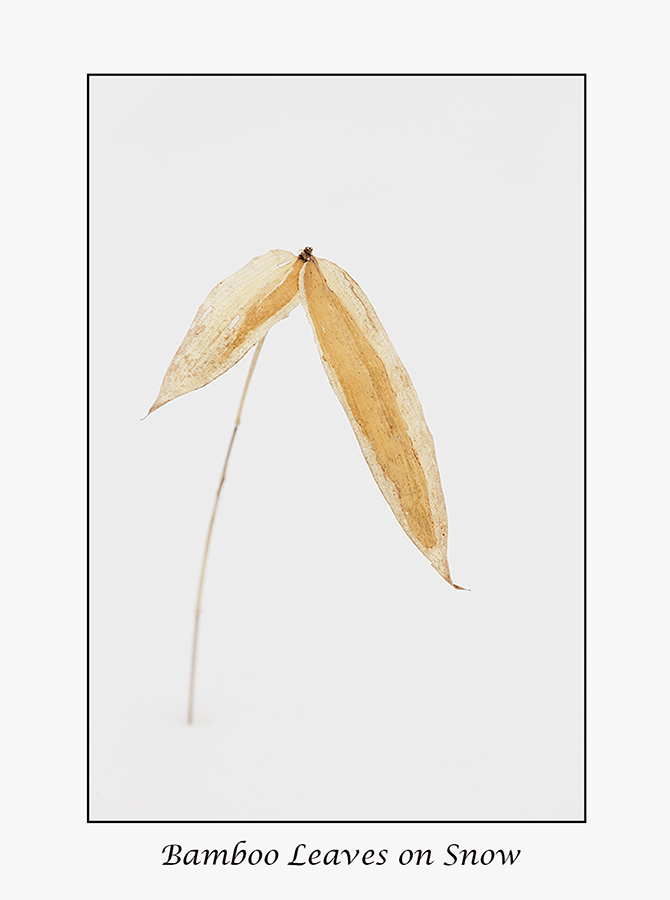
|
|
These new bamboo shoots were photographed on the Japan in Winter IPT with the Canon EF 200-400mm f/4L IS USM lens with Internal 1.4x Extender (hand held with the internal TC engaged at 506mm) and the Canon EOS-1D X. ISO 400. Evaluative metering +1 2/3 stops as framed: 1/640 sec. at f/8 in Manual mode. Color temperature: AWB. Click White Balance during the RAW conversion in DPP yielded pretty much perfectly WHITE snow with the three RGB values within a single digit of each other.
Five sensors up from the Central Sensor/AI Servo-Surround/Rear Focus AF as framed was active at the moment of exposure. Click here to see the latest version of the Rear Focus Tutorial. Click on the image to see a larger version.
The technique for creating the framed flower print look was taught to me by Denise Ippolito.
|
Remiss
I have been somewhat remiss on the blog in not following up on questions from previous posts (as I do here today). Do note that I will often comment on your answers (or questions) by leaving a comment at the post so be sure to check back often.
Best-Ever Hand Holding AF Tip
I have been stressing this super-important point both here on the blog and in seminars and on IPTs for years. In the recent Not Done Yet: Special Hokkaido Treats blog post I asked why it was important for me to be in AI Servo AF with AF active at the moment of exposure while creating the sublime bamboo leaves image. Though some folks eventually got to the point with their comments, it seems that most folks simply do not yet have the concept down pat:
When you are hand holding while standing and photographing a static subject it is pretty much mandatory that you be in AI Servo AF and have autofocus active at the moment of exposure. Why? Most folks cannot stay still enough to create razor sharp images if AF is not active. Our bodies move as we breathe and many folks including and especially me sway constantly.
If you are seated or otherwise able to brace your left forearm on something (like your left knee while seated for example), you can work set the (rear) focus or use One Shot AF and re-compose. Otherwise you need to be in AI Servo AF with AF active in order to in ensure accurate focus.
For years George Lepp has been able to stay relatively still enough to create sharp images without having AF active, and Denise Ippolito is incredibly skilled at doing the same. But in both instances they are working with relatively short macro lenses. It was Denise who taught me at Swan Island to press the shutter
button when the subject comes into sharp focus as I sway back and forth. Scroll down here for info on Denise’s September 2014 Swan Island Dahlia Farm Workshop.
My Favorite?
Like Michelle T, I liked both images a lot. The Ural Owl for the lovely bird and image design and the bamboo leaves image for the soft light and its simple yet powerful composition.
|
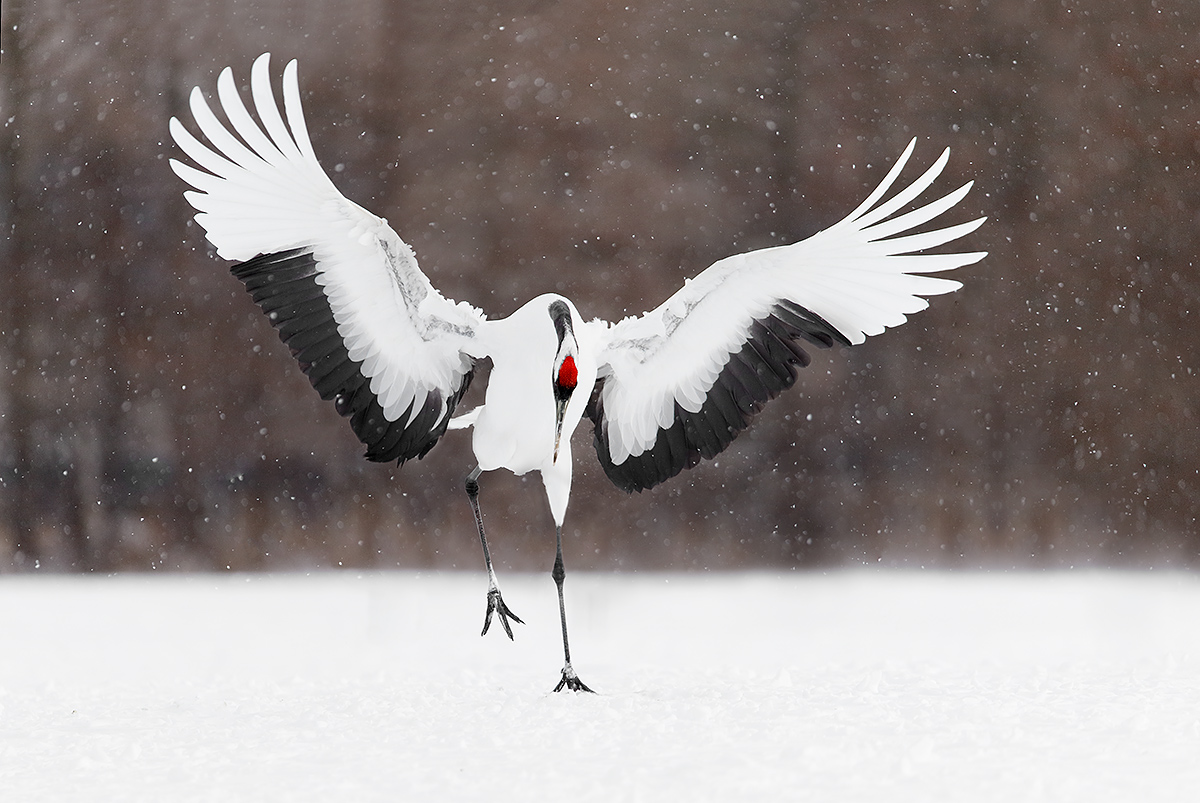
|
|
For me, the one hour that I spent on this image was indeed well worth it. You can see the original here.
|
What to Do?
In the What to Do? blog post, I asked, was it worth it? For me the answer of course was an obvious yes. Why? See the image immediately above…. The truth is that even though the Photoshop work there was exemplary pretty much anyone can learn to improve their post processing skills with a bit of study and practice. Best advice? Get yourself a copy of Digital Basics, an instructional PDF that is sent via e-mail. It includes my complete digital workflow, dozens of great Photoshop tips, the use of Contrast Masks, several different ways of expanding canvas, all of my time-saving Keyboard Shortcuts, Quick Masking, Layer Masking, and NIK Color Efex Pro basics, my killer image clean-up techniques, Digital Eye Doctor, creating time-saving actions, and lots more.
One Yakety Yakker Too Many?
In One Yakety Yakker Too Many? I actually liked the image with the two heads in the frame better than the image with the second yakking bird removed. Why? The original version coneys in part the fact that when one bird began calling that the others joined in and became part of a raucous chorus.
My Favorite?
I was alone in preferring the image of the young swan yakking. Why? The soft light, the sharpness, and the whimsical mood.
The Faces of ???
In the very popular The Faces of ??? post, I asked,
a-what do you think the monkey was thinking and feeling at the moment the image was created?
b-what do you think it was doing at the time the image was made?
c-can you think of a great title for the image?
Only a few folks opted to join in the fun.
Here you go:
Image 1.
a-Oh, Lord, does that feel good.
b-The monkey was being groomed by another in the onsen (the man made hot springs pool).
c-“Tranquility”
Image 2.
a-Ho, ho, that was a good one!
b-Hooting at a monkey that came too close.
c-:Too Funny!”
Image 3.
a-Whoa, this is a tough decision.
b-Staring straight ahead.
c-“Serious.”
Exposure Questions
In the same post I asked,” Why was the EC (exposure compensation) for the first image +1 2/3 stops while the EC for the second image was only +1 stop?”
The first image needed more + compensation in the soft light because the image as framed was much lighter in overall tonality than the 2nd image. Had the sun been out for both images I would have gone with +1/3 stop for the first image and zero for the second image. Please leave a comment if you think that you know why.
Bamboo-zled
In Bamboo-zled, my favorite images were #4 (above) and #6, the bamboo forest fish eye. Nobody but me chose #4? Why did I? It was created in the BAA style, tight, clean, and graphic. I loved the fish eye image for its unique perspective and because I worked so hard at creating it. (Yeah, I know, that is not supposed to matter….)
IPT Info
Many of our great trips are filling up. With 5 Canadians and another couple signing up for our 4-DAY Bosque IPT; that workshop is filling up quickly. See especially info on the Holland, and Nickerson Beach IPTs. Two great leaders on most trips ensure that you will receive individual attention, have all of your questions answered, and learn a ton including how to think like a pro, see the situation, and get the right exposure every time. In addition you will have fun, and make lots of great images. Click here for IPT details and general information.
|
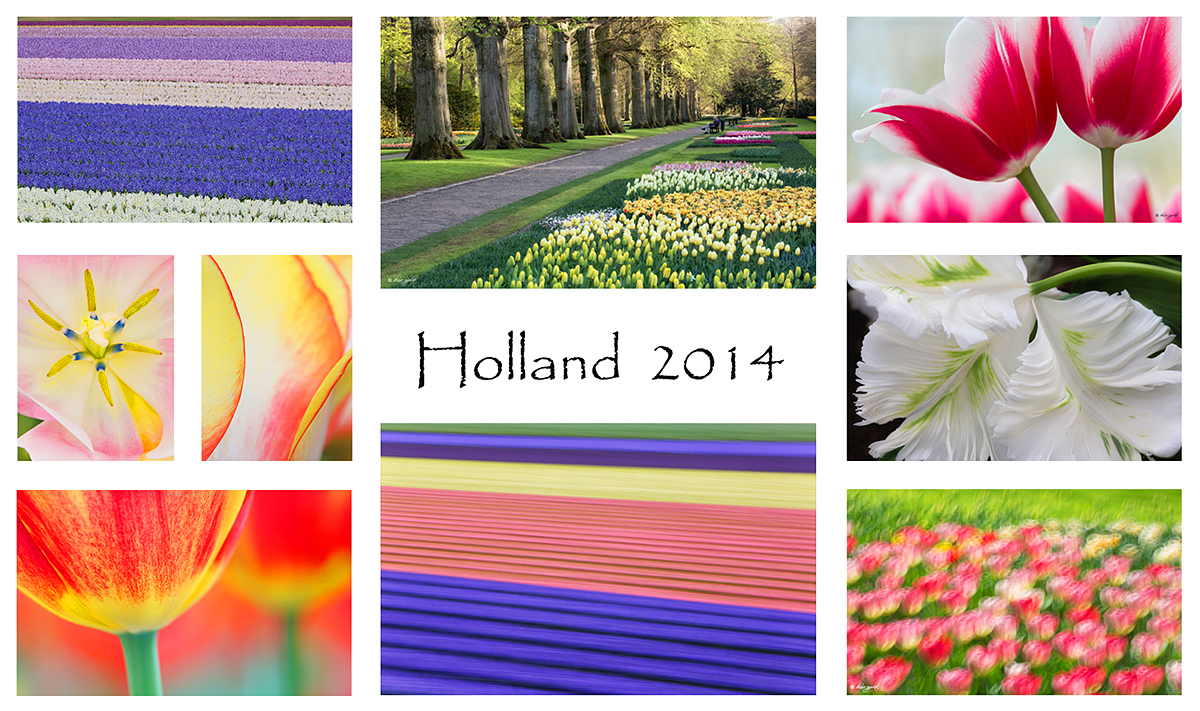
|
|
Images copyright 2012: Denise Ippolito & Arthur Morris. Card design by Denise Ippolito. Click on the image to enjoy a spectacular larger version.
|
Holland 2014 7 1/2-Day/8-Night: A Creative Adventure/BIRDS AS ART/Tulips & A Touch of Holland IPT. April 17-April 24, 2014: $4995 Limit: 12/Openings: 5
We still have room for 5 more flower photographers on this great trip.
Join Denise Ippolito, Flower Queen and the author of “Bloomin’ Ideas,” and Arthur Morris, Canon Explorer of Light Emeritus and one of the planet’s premier photographic educators for a great trip to Holland in mid-April 2014. Day 1 of the IPT will be April 17, 2014. We will have a short afternoon get-together and then our first photographic session at the justly-famed Keukenhof. Most days we will return to the hotel for lunch, image sharing and a break. On Day 8, April 24, we will enjoy both morning and afternoon photography sessions.
The primary subjects will be tulips and orchids at Keukenhof and the spectacularly amazing tulip, hyacinth, and daffodil bulb fields around Lisse. In addition we will spend one full day in Amsterdam. There will be optional visits the Van Gogh Museum in the morning and the Anne Frank House in the afternoon; there will be plenty of time for street photography as well. And some great food. On another day we will have a wonderful early dinner at Kinderdijk and then head out with our gear to photograph the windmills and possibly some birds for those who bring their longs lenses. We will spend an afternoon in the lovely Dutch town of Edam where we will do some street photography and enjoy a superb dinner. All lodging, ground transportation, entry fees, and meals (from dinner on Day 1 through dinner on Day 8) are included. For those who will be bringing a big lens we will likely have an optional bird photography afternoon or two.
Click here for additional info or to register.
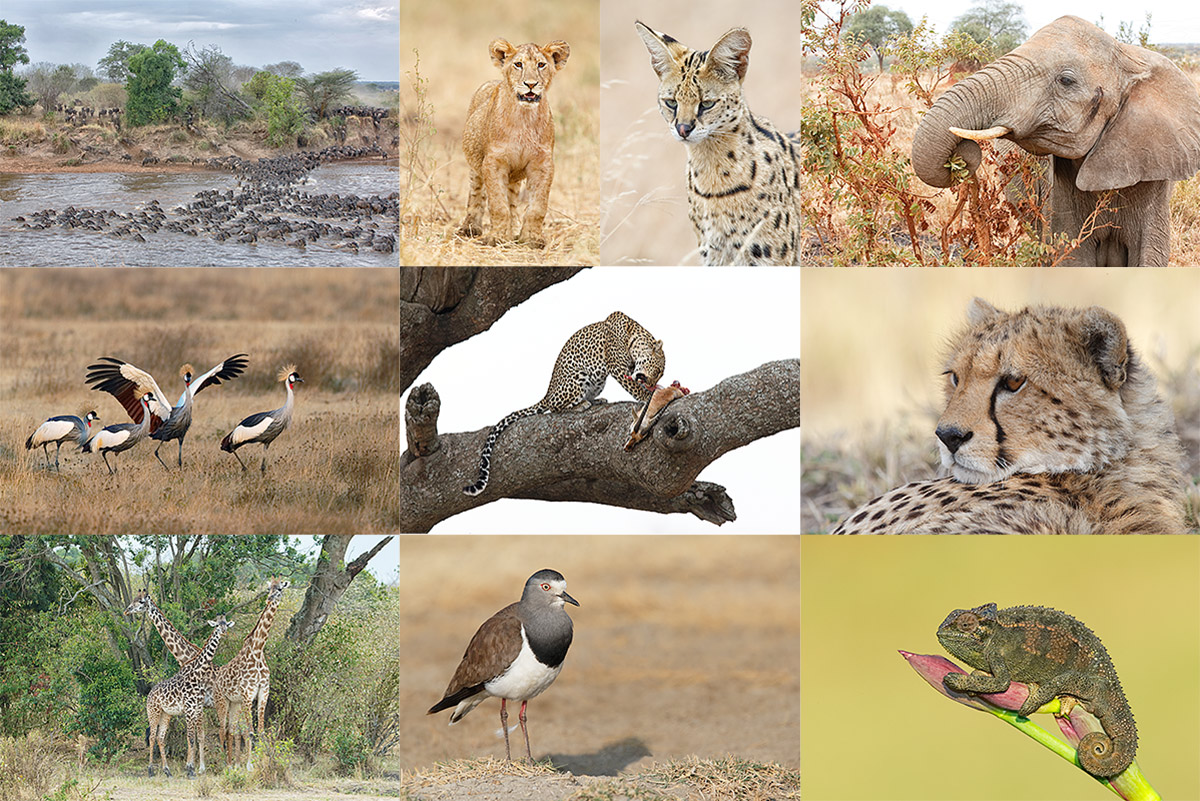
|
|
Join me for the 2014 Tanzania Summer Safari!
|
2014 Tanzania Summer Safari, 14-day African Adventure/leave the US on August 9. Fly home on August 24: $12,999.
Co-leaders Todd Gustafson & Arthur Morris. The limit is 12. Three photographers/van; you get your own row of seats. Our trip is a bit more expensive than the average safari for good reason. It is the best. We have the best driver guides with a total of decades of experience. They have been trained over the years by Todd and by me to drive with photography in mind. We have the best and most knowledgeable leaders. We stay in the best lodges and camps. We hope that you will join us for what will be Todd’s 35th African safari, and my 8th.
If you are seriously interested please e-mail me; I will be glad to send you the illustrated PDF with the complete itinerary and deposit info.
What else makes this expedition unique?
•Pre-trip consultation and camera equipment advice
•Award-winning photographers as your guides
•A seamless itinerary visiting the right locations at the best time of year
•Hands-on photography instruction in the field
•Specially designed three roof-hatch photo safari vehicles
•Proprietary materials for preparation, including free copy of “A Photographer’s Guide to Photographing in East Africa.”
•Post-safari image critiques
All-inclusive (double-occupancy) except for your flights to and from Kilamajaro Airport, bar drinks, soda & water (except at the Intimate Tented Camp where everything is free for our entire stay), tips for drivers and camp staff, personal items, and trip insurance.
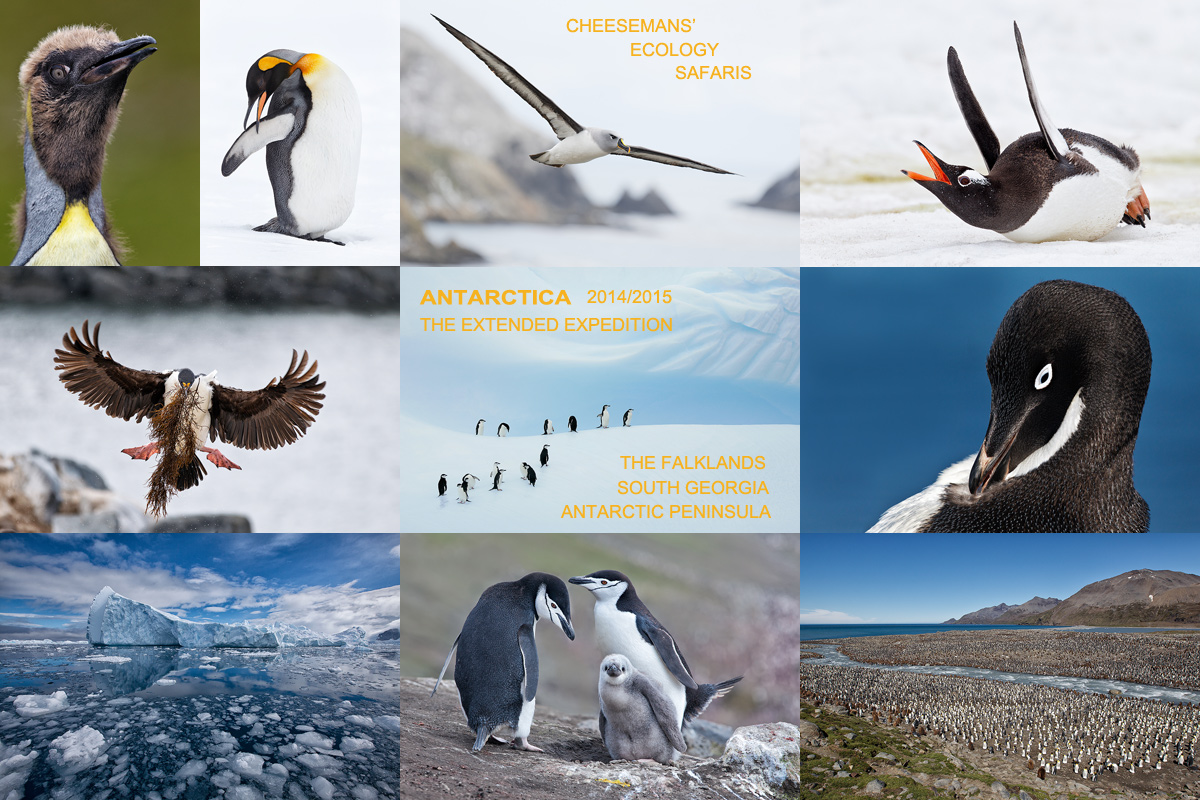
|
|
Breathe deeply, bite the bullet, and live life to its fullest; we all get only one ride on the merry-go-round… Join me on this great trip.
Click on the image to enjoy a larger version.
|
The Southern Ocean…
If you would like to explore the possibility of joining me on the Cheesemans’ Ecology Safaris Antarctica/The Extended Expedition Voyage< trip: Antarctic Peninsula, South Georgia and Falkland Islands: December 13, 2014 to January 10, 2015, click here for additional information and then shoot me an e-mail.
The DPP RAW Conversion Guide
To learn why I use Canon’s Digital Photo Professional (DPP) to convert every image that I work on, click here.
Support the BAA Blog. Support the BAA Bulletins: Shop B&H here!
We want and need to keep providing you with the latest free information, photography and Photoshop lessons, and all manner of related information. Show your appreciation by making your purchases immediately after clicking on any of our B&H or Amazon Affiliate links in this blog post. Remember, B&H ain’t just photography!




 


Amazon
Everyone buys something from Amazon, be it a big lens or deodorant. Support the blog by starting your search by clicking on the logo-link below. No purchase is too small to be appreciated; they all add up. Why make it a habit? Because I make it a habit of bringing you new images and information on an almost daily basis.
Typos
In all blog posts and Bulletins, feel free to e-mail or to leave a comment regarding any typos, wrong words, misspellings, omissions, or grammatical errors. Just be right. 🙂
March 11th, 2014 102
This post marks 102 straight days with a new educational blog post. With so many folks getting in the habit of using our B&H and Amazon links why quit now? To show your appreciation for my efforts here, we do ask that use our B&H and Amazon affiliate links for all of your B&H and Amazon purchases. Please check the availability of all photographic accessories in the BIRDS AS ART Online Store. We sell only what I use and depend on. We will not sell you junk. We know what you need to make creating great images easy and fun. And we are always glad to answer your gear questions via e-mail.
You can find the following items in the store: Gitzo tripods, Mongoose M3.6 and Wimberley heads, plates, low feet, and accessories, flash brackets, , Delkin e-film Pro Compact Flash Cards, LensCoat products, and our unique line-up of educational materials including ABP I & II, Digital Basics, Site and Set-up e-Guides, Canon and Nikon Camera Users and AF e-Guides, and MP-4 Photoshop video tutorials among others.
Note: we almost never have Mongoose M3.6 heads in stock. We sell them as fast as we get them. The best way to ensure getting one of these great heads for your intermediate or super-telephoto lens is to call Jim and place your order. You are then ensured of getting one from our next shipment. We will not of course bill your credit card until the item ships or drop-ships.
We would of course appreciate you using our B&H and Amazon affiliate links for all of your B&H and Amazon major gear, video, electronic, household, and personal purchases. For the photographic stuff mentioned in the paragraph above we would of course greatly appreciate your business. Here is a huge thank you to the many who have been using our links on a regular basis and visiting the BAA Online store as well.
This blog post took about 1 1/2 hours to prepare. Enjoy.
|

|
|
This Great Egret head portrait was created at Gatorland, Kissimmee, FL with the Gitzo 3532 LS carbon fiber tripod, the Mongoose M3.6 head, the Canon EF 800mm f/5.6L IS USM lens, and the EOS-1D Mark IV now replaced by the Canon EOS-1D X. ISO 400. Evaluative metering as framed: 1/320 sec. at f/9 in soft light in Manual mode.
Central Sensor/Rear Focus AI Servo-Expand as framed active at the moment of exposure. Click here to see the latest version of the Rear Focus Tutorial. Click on the image to see a larger version.
|
Gatorland Short Notice Saturday Full-Day In-the-Field Workshop
Saturday March 15, 2014. 7:15am till 10:15am & 3:30pm till dusk. Lunch, image review, and Photoshop session included. Limit 6/Openings: 4. A very small group is likely: $399.
The cost of your Gatorland Photographer’s Pass is not included.
For the past few years the Great Egrets have been nesting earlier and earlier. Head portraits of this species in full breeding plumage are very likely. Nest building and flight likely. In the field you will learn to spot good situations, to choose the best perspective, to see and understand the light, to get the right exposure every time after making a single test exposure, and to design pleasing images by mastering your camera’s AF system.
At lunch we will review my images, take a look at five of your best images from the morning session (for those who opt to bring their laptops), and process a few of my images in Photoshop after converting them in DPP. That followed by Instructor Nap Time.
Payment in full via credit card is due upon registering. Call me all day on Sunday at 863-692-0906. If I am in the pool or napping, please shoot me an e-mail with a call back time and number. Weekdays you will get Jim or Jen. Ask for me if you have any questions.
|
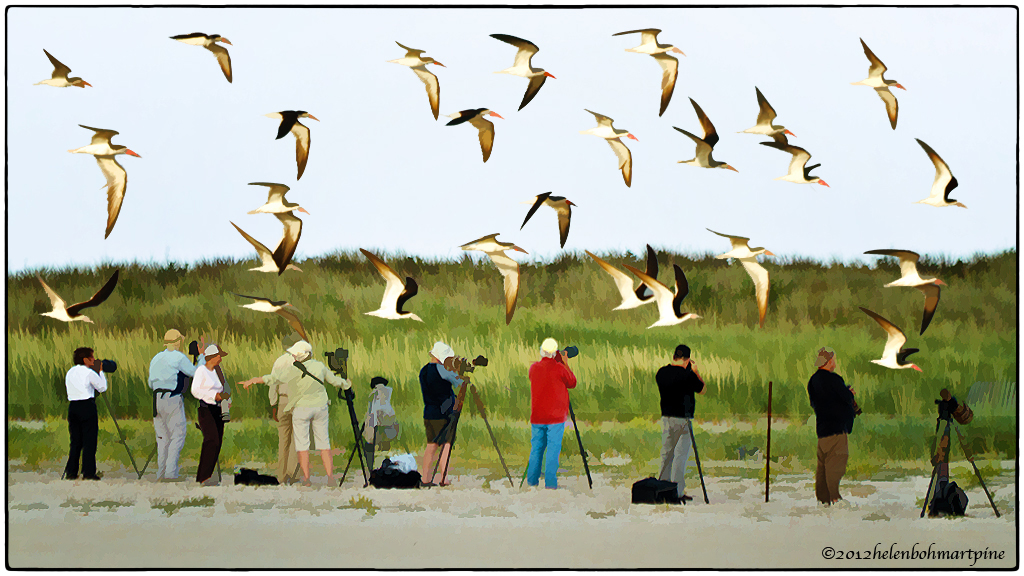
|
|
Artie and Denise & the 2012 Nickerson Beach IPT Crew. Image courtesy of and copyright 2012: Helen Bohmart Pine.
From left to right: Kitty Kono, yours truly, denise, Macolm MacKenzie (I think), Dierdre Sheer Gross (pointing), Michael Goodman, Stanley Goldberg, unknown photographer, & Tim Thompson. My favorite part: Helen made me look tall and thin!
|
BAA’s Economic Survival
In 2001, BAA sold the rights to images for more than $220,000 with VIREO (Visual Resources in Ornithology) as our only stock sales outlet. In other words, we sold lots of images ourselves. In tax year 2011, with images with Corbis and Visuals Unlimited, the total for image sales dropped to under $20,000. No matter how you slice it that represent a decline of more than 90%. Today, it is difficult to sell an image. With the handwriting on the wall I knew that we would need to adapt to survive. We have. We grew the mail order business via the BAA Online Store, we realized that creating income by selling information in digital form (PDFs)and MP4 Video Tutorials) would help save me from becoming a WalMart greeter, and we came to depend on the workshop business in the form of BIRDS AS ART Instructional Photo-Tours to remain more than solvent.
More recently our B&H and Amazon Affiliate link have done well and provided significant income as more and more folks have been using them in appreciation for my somewhat insane efforts here on the blog. As always, my #1 goal is to help folks become better photographers.
|
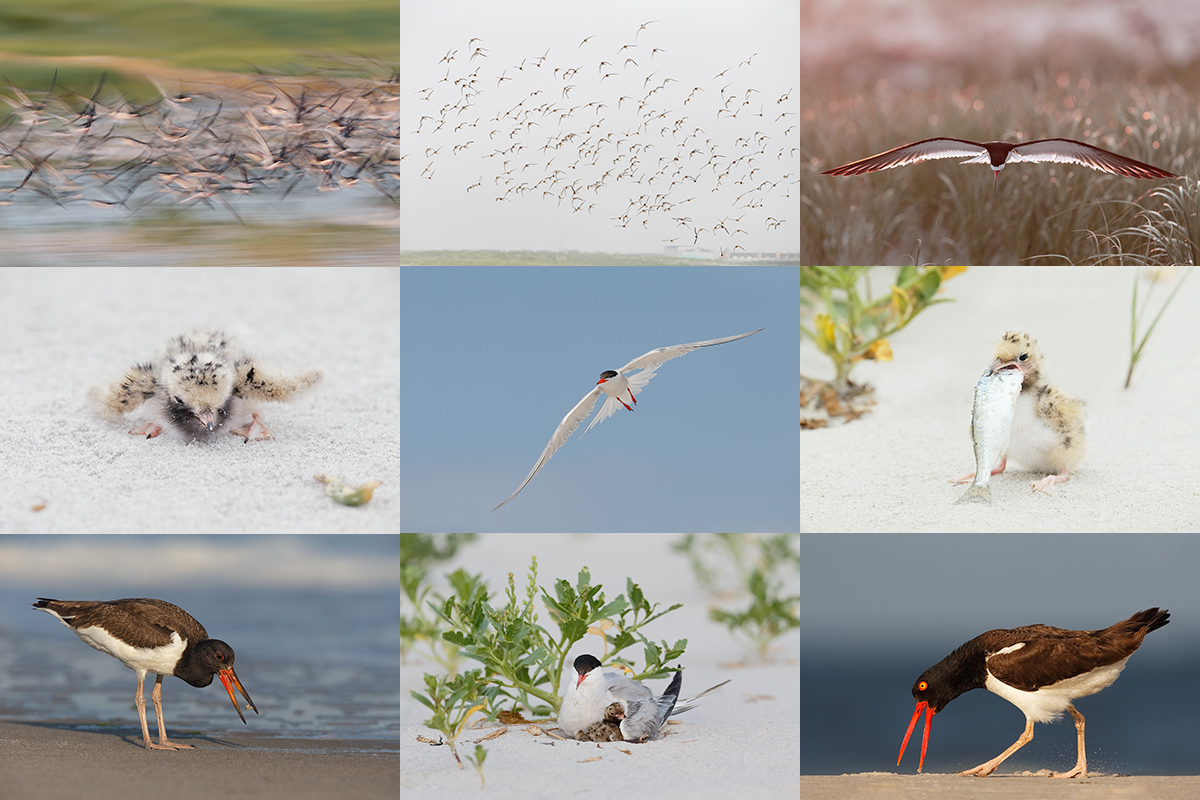
|
|
Nickerson Beach 2013 IPT images and card design copyright 2013: Arthur Morris/BIRDS AS ART. From upper left to right clockwise: skimmer blur, Sanderling flock with ocean and Long Beach, LI, NY in the background, backlit skimmer landing, Common Tern chick eating baby Bluefish, displaying American Oystercatcher, Common Tern brooding chick, young oystercatcher eating sand crab, newborn tern chick, adult Common Tern in flight.
Click on the image to enjoy a larger version.
|
It’s a Strange, Strange Business Indeed
Of late, the tour business has been hard to figure out. Here is a current example. In 2012 denise and I sold out our Nickerson Beach Workshop–see the opening image above. In 2013 it was a sell-out plus one over the limit. We were joined by John Van de Graaff, Doug West, Allan and Pat Lillich, Mike Goldhamer, Harry Hersh, Geri George, Lawrence Tawa, Paul Pinto Jr and his Dad, Brent Bridges, John Haedo, Tim Thompson, and Mark Hardymon. Though the season was late and as nature would have it, Black Skimmers were in short supply, we all had a great time with the Common Terns (especially the small chicks) and the American Oystercatcher families. Everyone went home smarter, more skilled, and very happy.
It is interesting to note that of the 13 folks, there were only 2 newcomers, the talented Paul Pinto Jr. and Larry Tawa from the West Coast. Larry signed up for Bosque last year but had to cancel at the last minute. We began advertising our 2014 Nickerson trip about 6 months ago. One old friend has been threatening to sign up but so far we have no registrants. As I said, things have been strange.
Two years ago I scheduled a San Diego IPT. When nobody signed up, I scrapped it. This year I planned a short-notice trip there and sold it out within one week. Go figure.
International Trips
International trips are just as strange. We sold out Holland with 12 last year, this year we have 7. Interested folks should sign up soon as we need to release the extra hotel rooms. Peter Kes will be joining us for the weekend. I sold out the recent Japan trip by invitation only in one day and am in the process of doing same with my 2016 Japan in Winter IPT. Galapagos 2015 is filling nicely. On the other hand, after doing a Camargue horses trip last year, dozens of folks e-mailed denise expressing interest. We put together a great trip but after several months with nobody signing up we were forced to cancel. Within a week of taking the trip down we received more than a dozen e-mails from folks ready and anxious to leave a deposit. Last year the Tanzania summer safari that I co-led with Todd Gustafson went with a group of 14. We are going again this year, right now with one client. I expect the UK puffins and gannets trip to sell out within days, but in reality, who knows?
As I’ve said, Go figure.
|
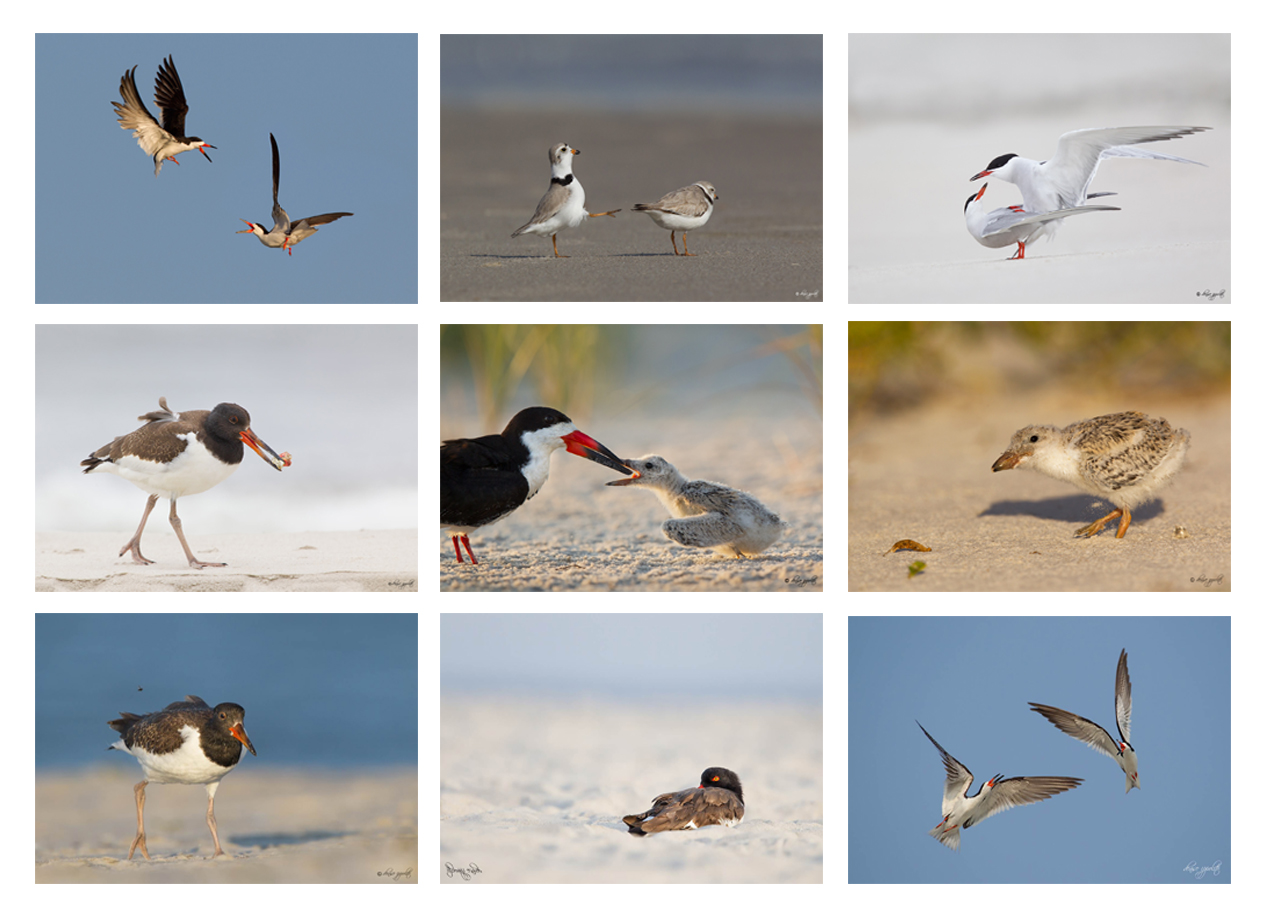
|
|
Nickerson Beach Summer 2013 images and card design copyright 2013: Denise Ippolito/A Creative Adventure. From upper left to right clockwise: Black Skimmers battling, Piping Plover goose-stepping, Common Terns copulating, Black Skimmer chick, skimmer aerial battle, adult oystercatcher sleeping on beach, juvenile oystercatcher striding, juvenile oystercatcher with prey item, backlit skimmer chick being fed at dawn.
Click on the image to enjoy a larger version.
|
Denise’s Card
As I mentioned above, the skimmers were both low in numbers and late nesting last July. Typically there would be lots of nests and more than a few small chicks on those dates. All of Neesie’s images above were made within 2 weeks of the IPT and the skimmer chicks in particular give a much more typical picture of activity in mid-July.
Nickerson Baby Beach-nesting Birds IPT: 3-Full Days/July 15-17, 2014: $1199. Introductory meet and greet: 8pm, Monday, July 14, 2014. Co-leaders Arthur Morris and Denise Ippolito
Join us on Long Island, NY next summer to photograph Black Skimmers, Common Terns with chicks, American Oystercatcher families, and possibly some just-hatched Black Skimmer chicks. The opportunities will include chances to photograph a variety of breeding behaviors including courtship feeding, display flight and combat, and copulations. Car-pooling is recommended; if we opt to return to the beach before 5pm there is a $30/vehicle parking fee that is not included so it is best to share that expense. Parking in the morning is free.
A $499 non-refundable deposit is required to hold your slot for this IPT. Your balance is due 4 months before the date of the IPT and is also non-refundable. If the trip fills, we will be glad to apply a credit applicable to a future IPT for the full amount less a $100 processing fee. If we do not receive your check for the balance on or before the due date we will try to fill your spot from the waiting list. If your spot is filled, you will lose your deposit. If not, you can secure your spot by paying your balance.
Please print, complete, and sign the form that is linked to here and shoot it to us along with your deposit check (made out to “Arthur Morris.”) Though we prefer a check, you can also leave your deposit with a credit card by calling the office at 863-692-0906. If you register by phone, please print, complete and sign the form as noted above and either mail it to us or e-mail the scan.
If you have any questions, please feel free to contact me via e-mail
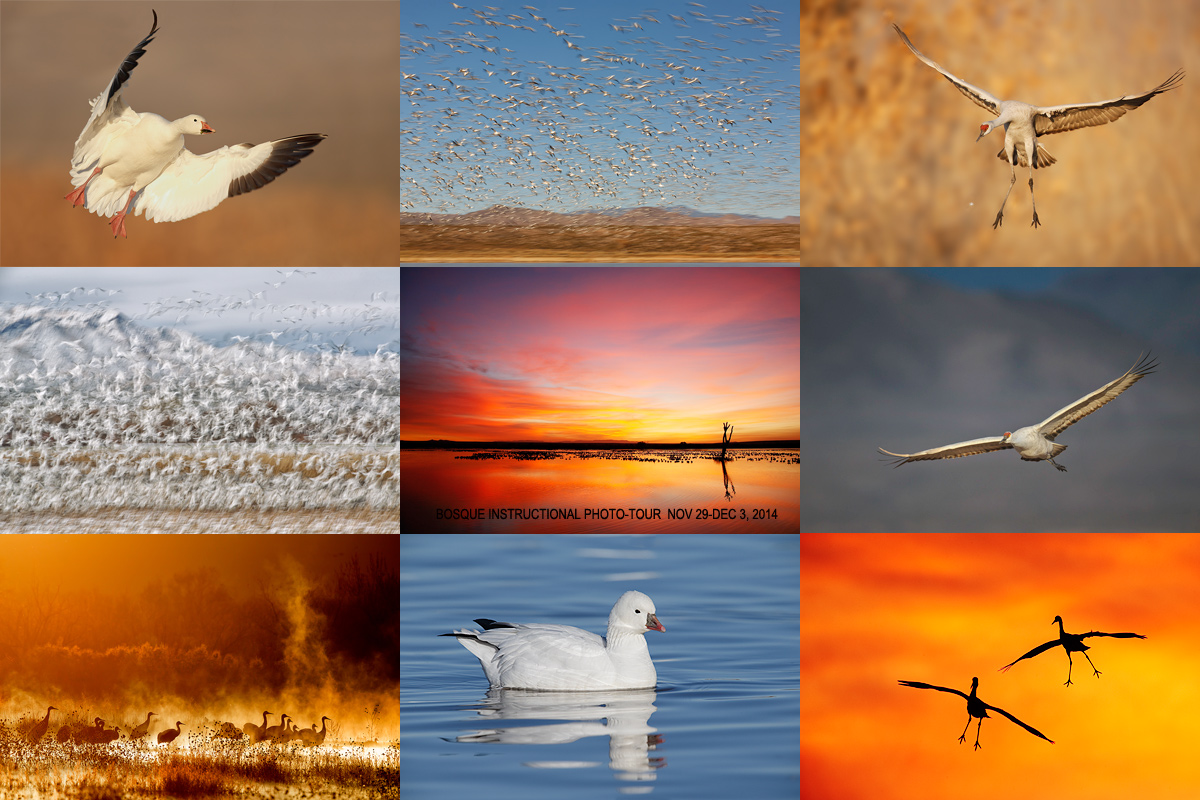
|
|
Join Denise Ippolito and me for four great days of photography and learning at one of our soul places. Please click on the card to enjoy a larger version.
|
The Business of Bosque Workshops
Perhaps a dozen years ago I ran four 3-DAY Bosque IPTs with a limit of 16 photographers. They always sold out well in advance. As the years went by I cut down on the number of Bosque Workshops, made them longer, and reduced the group size. Until last year the plan was working fabulously well with my traditional Thanksgiving dates. Last year I had only a single photographer along for the whole ride with several more signing up for the short version after the holiday. In contrast, the 4-day Bosque 2014 IPT already has 8 folks signed up. Go figure….
As noted here previously, pretty much anyone with a camera is now qualified to lead a photography tour. While some appreciate great leaders with decades of experience, others are not. From where I sit, it is all about value. For now, I am doing just fine. Who knows what the future will bring? I surely don’t but I suspect that I will continue to do just fine. And so will denise.
Click here for the Instructional Photo-Tour schedule and complete IPT details.
Support the BAA Blog. Support the BAA Bulletins: Shop B&H here!
We want and need to keep providing you with the latest free information, photography and Photoshop lessons, and all manner of related information. Show your appreciation by making your purchases immediately after clicking on any of our B&H or Amazon Affiliate links in this blog post. Remember, B&H ain’t just photography!




 


Amazon
Everyone buys something from Amazon, be it a big lens or deodorant. Support the blog by starting your search by clicking on the logo-link below. No purchase is too small to be appreciated; they all add up. Why make it a habit? Because I make it a habit of bringing you new images and information on an almost daily basis.
Typos
In all blog posts and Bulletins, feel free to e-mail or to leave a comment regarding any typos, wrong words, misspellings, omissions, or grammatical errors. Just be right. 🙂
March 10th, 2014 101
This post marks 101 straight days with a new educational blog post. With so many folks getting in the habit of using our B&H and Amazon links why quit now? To show your appreciation for my efforts here, we do ask that use our B&H and Amazon affiliate links for all of your B&H and Amazon purchases. Please check the availability of all photographic accessories in the BIRDS AS ART Online Store. We sell only what I use and depend on. We will not sell you junk. We know what you need to make creating great images easy and fun. And we are always glad to answer your gear questions via e-mail.
You can find the following items in the store: Gitzo tripods, Mongoose M3.6 and Wimberley heads, plates, low feet, and accessories, flash brackets, , Delkin e-film Pro Compact Flash Cards, LensCoat products, and our unique line-up of educational materials including ABP I & II, Digital Basics, Site and Set-up e-Guides, Canon and Nikon Camera Users and AF e-Guides, and MP-4 Photoshop video tutorials among others.
Note: we almost never have Mongoose M3.6 heads in stock. We sell them as fast as we get them. The best way to ensure getting one of these great heads for your intermediate or super-telephoto lens is to call Jim and place your order. You are then ensured of getting one from our next shipment. We will not of course bill your credit card until the item ships or drop-ships.
We would of course appreciate you using our B&H and Amazon affiliate links for all of your B&H and Amazon major gear, video, electronic, household, and personal purchases. For the photographic stuff mentioned in the paragraph above we would of course greatly appreciate your business. Here is a huge thank you to the many who have been using our links on a regular basis and visiting the BAA Online store as well.
This blog post took about 1 1/2 hours to prepare. Enjoy.
|

|
|
This Ural Owl image was created on the 2014 Japan in Winter with the Gitzo 3532 LS carbon fiber tripod, the Mongoose M3.6 head, the Canon EF 600mm f/4L IS II USM lens, the Canon 2x EF Extender III (Teleconverter), and the Canon EOS-1D X Digital SLR camera. ISO 400. Evaluative metering -1/3 stop as framed: 1/125 sec. at f/13 in Manual mode. Color Temperature: AWB.
The exposure here was about 1/2 stop too dark. I wanted to save some shutter speed as we were precariously positioned on a sloped, muddy hillside. ISO 800 would likely have been a better choice….
Central sensor (by necessity) Expand/AI Servo/Rear Focus on the bird’s eye and re-compose. Click here if you missed the Rear Focus Tutorial. Click on the image to see a larger version.
|
Special Hokkaido Treats
Owls are always special photographic subjects. As soon as our guide mentioned Ural Owl, everyone was chomping at the bit. One cloudy morning on the way back from somewhere he said, “We go to Ural Owl.” Because of the sensitivity of the site we split the group in two. We all enjoyed about 30 minutes with this beautiful bird. The owl, by the way, was totally unconcerned with our presence as we stayed very quiet and nobody slid down the hill…
|

|
|
These new bamboo shoots were photographed on the Japan in Winter IPT with the Canon EF 200-400mm f/4L IS USM lens with Internal 1.4x Extender (hand held with the internal TC engaged at 506mm) and the Canon EOS-1D X. ISO 400. Evaluative metering +1 2/3 stops as framed: 1/640 sec. at f/8 in Manual mode. Color temperature: AWB. Click White Balance during the RAW conversion in DPP yielded pretty much perfectly WHITE snow with the three RGB values within a single digit of each other.
Five sensors up from the Central Sensor/AI Servo-Surround/Rear Focus AF as framed was active at the moment of exposure. Click here to see the latest version of the Rear Focus Tutorial. Click on the image to see a larger version.
|
Bamboo Leaves
We saw hillsides of what I assume were new bamboo shoots, just a couple of leaves about 4-6 inches tall in all. Nothing like the fully grown trees that soar towards the heavens. (See Bamboo-zled, especially the fish eye image at the bottom of the blog post.) I was in the first Ural Owl group. As we were waiting for the other van to bring the rest of the group, I noted lots of small bamboo shoots poking out of the snow alongside the road. These two leaves screamed out to me, “See how pretty we are! Please take a picture of us.” The simple arrangement was so beautiful that I grabbed the 200-400 and went to work. I went to f/8 for a bit of extra depth-of field.
Here’s the rub: which is the more beautiful image? The owl, well done and a much desired subject? Or the simple image of the bamboo shoots in the snow? Which image do you like best? Be sure to let us know why.
Image Technique Question
In the bamboo shoot situation noted above, why was it mandatory to have AI Servo AF active at the moment of exposure?
The DPP RAW Conversion Guide
To learn why I use Canon’s Digital Photo Professional (DPP) to convert every image that I work on, click here.
|

|
|
This Great Egret head portrait was created at Gatorland, Kissimmee, FL with the Gitzo 3532 LS carbon fiber tripod, the Mongoose M3.6 head, the Canon EF 800mm f/5.6L IS USM lens, and the EOS-1D Mark IV now replaced by the Canon EOS-1D X. ISO 400. Evaluative metering as framed: 1/320 sec. at f/9 in soft light in Manual mode.
Central Sensor/Rear Focus AI Servo-Expand as framed active at the moment of exposure. Click here to see the latest version of the Rear Focus Tutorial. Click on the image to see a larger version.
|
Gatorland Short Notice Saturday Full-Day In-the-Field Workshop
Saturday March 15, 2014. 7:15am till 10:15am & 3:30pm till dusk. Lunch, image review, and Photoshop session included. Limit 6/Openings: 4. A very small group is likely: $399.
The cost of your Gatorland Photographer’s Pass is not included.
For the past few years the Great Egrets have been nesting earlier and earlier. Head portraits of this species in full breeding plumage are very likely. Nest building and flight likely. In the field you will learn to spot good situations, to choose the best perspective, to see and understand the light, to get the right exposure every time after making a single test exposure, and to design pleasing images by mastering your camera’s AF system.
At lunch we will review my images, take a look at five of your best images from the morning session (for those who opt to bring their laptops), and process a few of my images in Photoshop after converting them in DPP. That followed by Instructor Nap Time.
Payment in full via credit card is due upon registering. Call me all day on Sunday at 863-692-0906. If I am in the pool or napping, please shoot me an e-mail with a call back time and number. Weekdays you will get Jim or Jen. Ask for me if you have any questions.
IPT Info
Many of our great trips are filling up. With 5 Canadians and another couple signing up for our 4-DAY Bosque IPT; that workshop is filling up quickly. See especially info on the Holland, and Nickerson Beach IPTs. Two great leaders on most trips ensure that you will receive individual attention, have all of your questions answered, and learn a ton including how to think like a pro, see the situation, and get the right exposure every time. In addition you will have fun, and make lots of great images. Click here for IPT details and general information.
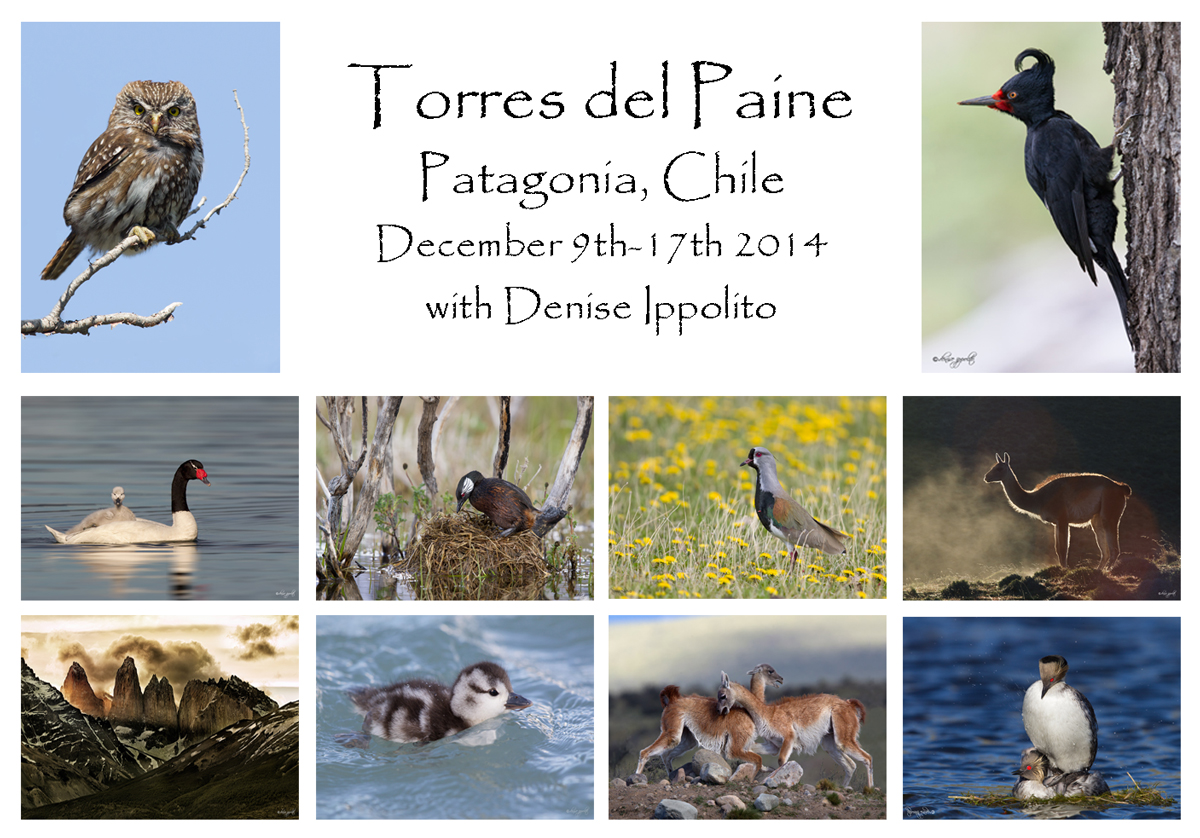
|
|
Image and card design copyright 2103: Denise Ippolito/A Creative Adventure
|
A Rare Photographic Opportunity
Torres del Paine/A Creative Adventure Workshop
Join Denise Ippolito for her first ever Torres del Paine workshop. As many of you know, she presented a program to Avistar Patagonia in November of 2013. We spent our days traveling to the famed Torres del Paine National Park in Chile. After the workshop was over Denise joined David Tipling and me for a few days of photography on our own at Torres del Paine. Once David left Denise and I met up with two professional guides and stayed inside the park for a week scouting and photographing on our own. She fell in love with the place and knew immediately that she would return with clients as this place has something for everyone. We will enjoy landscape photography, wildlife photography, bird photography and creative photography.
Participants will fly to the airport in Santiago, Chile (SCL) and take a connecting flight to Punta Arenas (PUQ). There we will be picked up by hotel van; these transfers are included. It is a four hour drive and most hotels do not include this pricey transfer. Once we reach our hotel we will check in and everything will be included: all meals, open bar, bilingual guides, transfers to and from the park, horseback riding if you want- or simply just photographing the horses. Note: your round trip airfare to and from Punta Arenas, Chile is not included in the trip fee. Denise has arranged for a private photo shoot of the horses running with gauchos. Anyone wishing to bring a spouse may; the price for a spouse or companion is the same. There will be other excursions, treks, and activities available as options. The group will photograph together in the mornings and again in the late afternoons (weather permitting). Free time can be enjoyed relaxing at the award-winning hotel, taking advantage of some of the amazingly plush amenities, downloading and reviewing images. or participating in small group image critique or Photoshop sessions with Denise.
Her goal is to help you create the best images at every stop of the journey. This will be an adventurous photography tour and Denise will be there to help you with your camera settings, lens selection, creative techniques and much more. December is the month that the Guanacos have their young; this may attract the Pumas into photographic range. We will hope to see Puma but our trip will not be based on that quest. December is one of the best times to visit the park for wildlife.
Torres del Paine/A Creative Adventure Photographic Workshop: December 9th- 17th. 2014: $6120 USD double occupancy.
This trip needs a minimum of 12 people to run; six down, six to go. You will need to wait until you hear from Denise before booking your flights. Travel insurance with TSI is recommended. Click here for more information or to register. Please let Denise know that BIRDS AS ART sent you. 🙂
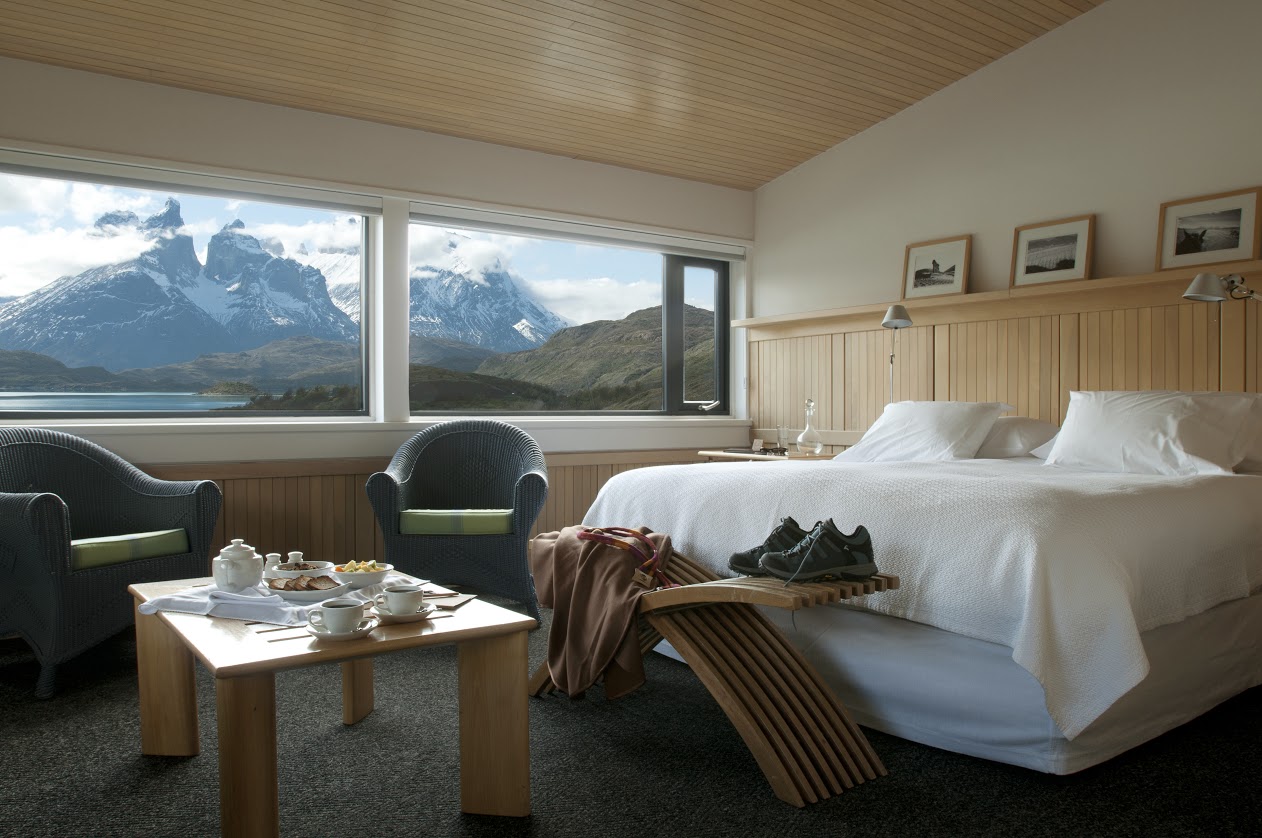
|
|
Image courtesy of and copyright Explora Patagonia.
|
The lodge/hotel, Explora Patagonia/Hotel Salto Chico). is the only hotel located in the heart of the extraordinary Torres del Paine National Park in central Patagonia. It is on the banks of the Salto Chico waterfall where we will have excellent view of the unique Paine Massif and two of the three impressive torres, or towers, that give the park its name. Situated on a 7.4-acre site, Explora Patagonia has 49 comfortable rooms, all with captivating views. The sophisticated design incorporates native lenga wood and cypress brought from the Guaitecas Archipelago, while the floor is made of almond wood. Each room has a small living area, hydromassage bath, and beds designed for deep, pleasurable sleep after a day of exploration.
The hotel is the only lodge in the area with its own horses, horses that have been bred and trained especially to be ridden by gringos. Denise loves being outdoors experiencing nature in its rawest form, however, a clean, comfortable bed in a luxurious hotel with gourmet food is a nice way to end the day! The coffee is great! Denise does not know if that matters to you but it matters to her 🙂
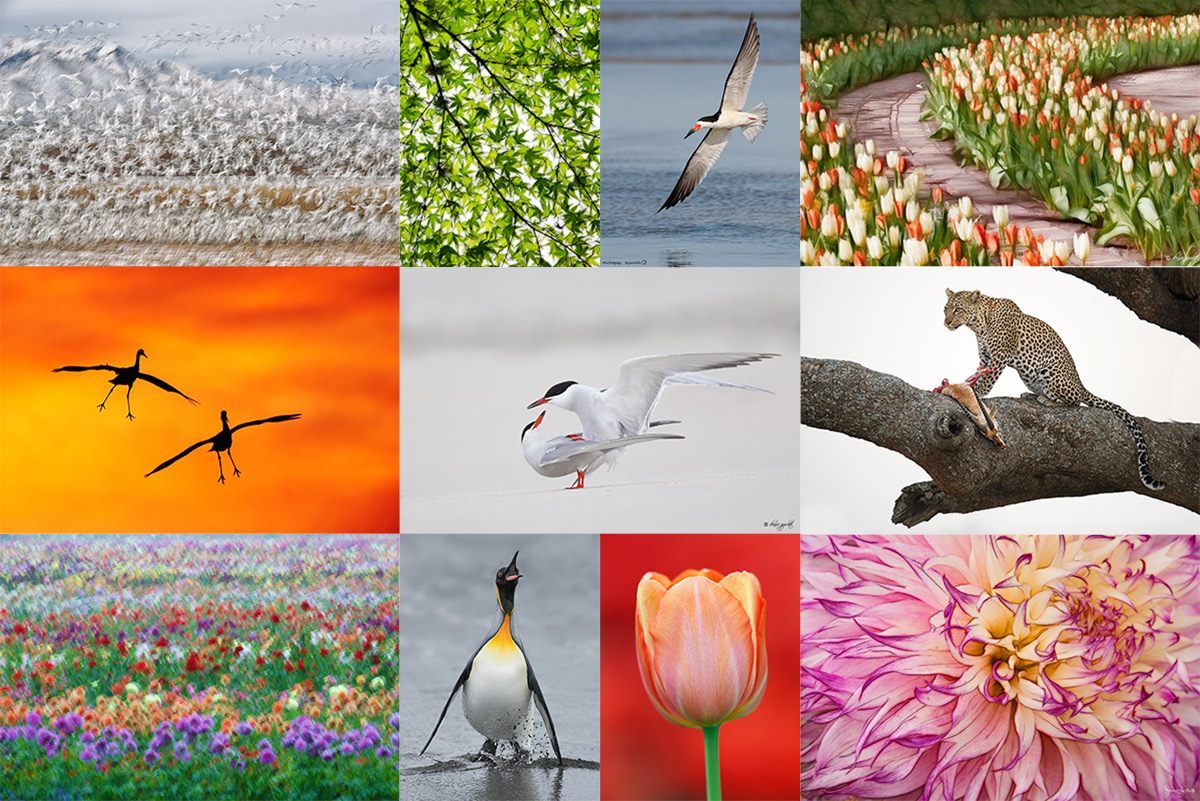
|
|
If you’d like to learn from the two folks who created the images in the composite above do consider one of the trips below. Denise Ippolito’s images: Japanese leaf painting, skimmer in flight, curved Keukenhof paths with tulips, copulating terns, & pink dahlia. Artie’s images: Snow Geese snowstorm blur, crane landing silhouettes, Leopard with prey in tree, King Penguin, & vertical tulip. Note: Denise alone will be leading the Torres del Paine workshop.
|
A Creative Adventure/BIRDS AS ART Instructional Photo-Tours (IPTs)/Two great leaders: Arthur Morris & Denise Ippolito.
Arthur Morris/BIRDS AS ART www.BIRDSASART-blog.com for the latest images, info, & education
Denise Ippolito/A Creative Adventure www.deniseippolito.com: get yourself out of the box!
Denise’s e-books: Bloomin’ Ideas, A Guide to Filters & Effects, The Softer Side of Macro, & more. Free Monthly Creative MiniMag: www.deniseippolito.com/magazine
Nickerson Baby Beach-nesting Birds IPT, Long Island, NY: 3-Full Days/July 22-24, 2014: $1199.
Black Skimmers, Common Terns with chicks, American Oystercatcher & Piping Plover families; breeding behaviors including courtship feeding, display flight and combat, and copulations. Gulls and shorebirds.
UK Puffins IPT. Early July, 2014.
Details TBA. Please e-mail to be placed on the interested list.
Tanzania Serengeti Summer Safari: Leave US: August 9—return: August 24, 2014: $12,999.
Co-leaders: Arthur Morris & Todd Gustafson. Wildebeest/The Great Migration, cats, elephant, giraffe, zebra, birds & more. Please e-mail for brochure.
Swan Island Dahlia Farm IPT, Canby, OR, September 8-12, 2014: 5 FULL DAYS: $1699.
Leader: Denise Ippolito. 40 acres with 350+dazzling varieties of dahlias in a plethora of colors, shapes and sizes. Sharpen your technical skills and boost your creative juices. Daily assignments, image sharing, and Photoshop sessions.
Bosque del Apache 2014 A Creative Adventure/BIRDS AS ART “Creative Photography Instructional Photo-Tour.” (IPT). NOV 24-25, 2014. 2-FULL DAYS: $729.
Leaders: Denise Ippolito & Arthur Morris. Introductory Slide program: 7:00pm on Sunday 11/23. This IPT is perfect for folks who want to learn to think outside the box, to create new and different images. Learn to unleash your creative juices at the wondrous Bosque del Apache, NWR in San Antonio, NM.
Bosque del Apache 2014 BIRDS AS ART/A Creative Adventure Instructional Photo-Tour (IPT). NOV 29-DEC 3, 2014. Totaling 4 FULL-DAYS: $1449
Leaders: Arthur Morris and Denise Ippolito. Introductory Slide program: 7:00pm on Sunday 11/29. Tens of thousand of Snow Geese, 10,000 Sandhill Cranes, ducks, amazing sunrises, sunsets, and blast-offs. Live, eat, and breathe photography with two of the world’s premier photographic educators at one of their very favorite photography locations on the planet.
Antarctica/The Extended Expedition Voyage: Antarctic Peninsula, South Georgia and Falkland Islands: December 13, 2014 to January 10, 2015.
Please e-mail for details.
BAA offers a wide range of books, e-Guides, and educational materials and photographic accessories at the lowest prices around—25+ years of experience, and the best advice you can get. We will not sell you junk. Access the BAA Store here or call us at 1-863-692-0906.
Questions? Please e-mail us at birdsasart@verizon.net or photographybydenise221@gmail.com.
Support the BAA Blog. Support the BAA Bulletins: Shop B&H here!
We want and need to keep providing you with the latest free information, photography and Photoshop lessons, and all manner of related information. Show your appreciation by making your purchases immediately after clicking on any of our B&H or Amazon Affiliate links in this blog post. Remember, B&H ain’t just photography!


 


Amazon
Everyone buys something from Amazon, be it a big lens or deodorant. Support the blog by starting your search by clicking on the logo-link below. No purchase is too small to be appreciated; they all add up. Why make it a habit? Because I make it a habit of bringing you new images and information on an almost daily basis.
Typos
In all blog posts and Bulletins, feel free to e-mail or to leave a comment regarding any typos, wrong words, misspellings, omissions, or grammatical errors. Just be right. 🙂
March 9th, 2014 The Streak Gets to 100
This post marks 100 straight days with a new blog post. Who’d of thunk it? Not me for sure. The streak may be extended for at least another day or so, or not. Or more…. To show your appreciation for my efforts here, we ask that use our B&H and Amazon affiliate links for all of your B&H and Amazon purchases. Please check the availability of all photographic accessories in the BIRDS AS ART Online Store. We sell only what I use and depend on. We will not sell you junk. We know what you need to make creating great images easy and fun. And we are always glad to answer your gear questions via e-mail.
You can find the following items in the store: Gitzo tripods, Mongoose M3.6 and Wimberley heads, plates, low feet, and accessories, flash brackets, , Delkin e-film Pro Compact Flash Cards, LensCoat products, and our unique line-up of educational materials including ABP I & II, Digital Basics, Site and Set-up e-Guides, Canon and Nikon Camera Users and AF e-Guides, and MP-4 Photoshop video tutorials among others.
Note: we almost never have Mongoose M3.6 heads in stock. We sell them as fast as we get them. The best way to ensure getting one of these great heads for your intermediate or super-telephoto lens is to call Jim and place your order. You are then ensured of getting one from our next shipment. We will not of course bill your credit card until the item ships or drop-ships.
We would of course appreciate you using our B&H and Amazon affiliate links for all of your B&H and Amazon major gear, video, electronic, household, and personal purchases. For the photographic stuff mentioned in the paragraph above we would of course greatly appreciate your business. Here is a huge thank you to the many who have been using our links on a regular basis and visiting the BAA Online store as well.
This blog post took about 1 1/2 hours to prepare. Enjoy.
Floored!
A decade ago I spend a good deal of my waking time engaged in online piss-fights. Many of them got quite ugly. I remember an Italian guy posting something to the effect that it was simply not possible to create a sharp image with a telephoto lens and a teleconverter. What I had to say was not pretty. And it went on back and forth for days. I was doing my best at the time, but….
That in mind I was absolutely floored to receive the following BPN Private Message from John Haig:
I wanted to take a moment to thank you, for all the lessons over the years. They started way back, reading your articles and with the purchase of “The Art of Bird Photography”. They have continued through your newsletter/blog and forum posts. I have learned a lot of great technical details from you. More importantly, I learned to really think about the images I make.
But that’s not why I want to thank you…or at least not the main reason. The most valuable lesson I have learned from you is from your truly exemplary debating skills, both in these forums, and on your blog. You state your points eloquently and with clarity. More importantly, you respond to challenges with dignity and a singular focus on points and facts that is truly masterful.
I know I’ve been engaged in debates and found myself asking “what would Arthur Morris do?” Thank you for always speaking your mind and being true to yourself. You’re the kind of person I think best exemplifies why I love Americans…because as similar in many aspects as we Canadians are, we are not nearly as good at free speech, and I believe that’s our great loss.
Be well, and I will continue to enjoy your work, both as a photographer and a teacher.
Best Regards, John
The Work
When I read John’s PM I had to read it again to make sure that he was talking about me. He was. And yes, I was floored. At times we continue to see our old selves being unable to note or acknowledge personal growth. It was great to receive John’s PM. In retrospect, my growth began after I started doing The Work of Byron Katie: Who would you be without your story?. I learned of Byron Katie from my good friend, my health and personal adviser, Dr. Cliff Oliver of San Diego, CA. Simply put, The Work helps you learn to love what is by asking four simple questions and turning them around. It was not until I began doing The Work on my late-wife Elaine’s death–breast cancer in 1994–that I came to be completely at peace with it. But doing The Work spun off to other areas of my daily life; most especially, it helped me learn to stay out of those energy-sapping, time consuming, totally worthless online confrontations. I still slip every once in a while, but I pretty much avoid them. You will never convince the nay-sayers, especially the very few bitter unhappy folks who derive pleasure from spreading their poison.
Loving what is is a great way to be. I hope that before they put me in a box that I have the opportunity to attend a Byron Katie event and to give her a hug. Two of her can’t miss works are “Loving What Is: Four Questions That Can Change Your Life” and “I Need Your Love – Is That True?: How to Stop Seeking Love, Approval, and Appreciation and Start Finding Them Instead.” I am still working on the latter :). In any case I am much more at peace than I was six years ago. And it’s nice to have someone notice it so thanks John!
Do The Work For Free
Learn more about the work here. You can get started doing the work for free by downloading the “Judge Your Neighbor” worksheet here. Answer the four questions at the bottom of the sheet and do the turn-arounds. You will be well on your way to finding peace.
|

|
|
This Great Egret head portrait was created at Gatorland, Kissimmee, FL with the Gitzo 3532 LS carbon fiber tripod, the Mongoose M3.6 head, the Canon EF 800mm f/5.6L IS USM lens, and the EOS-1D Mark IV now replaced by the Canon EOS-1D X. ISO 400. Evaluative metering as framed: 1/320 sec. at f/9 in soft light in Manual mode.
Central Sensor/Rear Focus AI Servo-Expand as framed active at the moment of exposure. Click here to see the latest version of the Rear Focus Tutorial. Click on the image to see a larger version.
|
Gatorland Short Notice Saturday Full-Day In-the-Field Workshop
Saturday March 15, 2014. 7:15am till 10:15am & 3:30pm till dusk. Lunch, image review, and Photoshop session included. Limit 6. A very small group is likely: $399.
The cost of your Gatorland Photographer’s Pass is not included.
For the past few years the Great Egrets have been nesting earlier and earlier. Head portraits of this species in full breeding plumage are very likely. Nest building and flight likely. In the field you will learn to spot good situations, to choose the best perspective, to see and understand the light, to get the right exposure every time after making a single test exposure, and to design pleasing images by mastering your camera’s AF system.
At lunch we will review my images, take a look at five of your best images from the morning session (for those who opt to bring their laptops), and process a few of my images in Photoshop after converting them in DPP. That followed by Instructor Nap Time.
Payment in full via credit card is due upon registering. Call me all day on Sunday at 863-692-0906. If I am in the pool or napping, please shoot me an e-mail with a call back time and number. Weekdays you will get Jim or Jen. Ask for me if you have any questions.
IPT Info
Many of our great trips are filling up. With 5 Canadians and another couple signing up for our 4-DAY Bosque IPT; that workshop is filling up quickly. See especially info on the Holland, and Nickerson Beach IPTs. Two great leaders on most trips ensure that you will receive individual attention, have all of your questions answered, and learn a ton including how to think like a pro, see the situation, and get the right exposure every time. In addition you will have fun, and make lots of great images. Click here for IPT details and general information.
|

|
|
Images copyright 2012: Denise Ippolito & Arthur Morris. Card design by Denise Ippolito. Click on the image to enjoy a spectacular larger version.
|
Holland 2014 7 1/2-Day/8-Night: A Creative Adventure/BIRDS AS ART/Tulips & A Touch of Holland IPT. April 17-April 24, 2014: $4995 Limit: 12/Openings: 5
We still have room for 5 more flower photographers on this great trip.
Join Denise Ippolito, Flower Queen and the author of “Bloomin’ Ideas,” and Arthur Morris, Canon Explorer of Light Emeritus and one of the planet’s premier photographic educators for a great trip to Holland in mid-April 2014. Day 1 of the IPT will be April 17, 2014. We will have a short afternoon get-together and then our first photographic session at the justly-famed Keukenhof. Most days we will return to the hotel for lunch, image sharing and a break. On Day 8, April 24, we will enjoy both morning and afternoon photography sessions.
The primary subjects will be tulips and orchids at Keukenhof and the spectacularly amazing tulip, hyacinth, and daffodil bulb fields around Lisse. In addition we will spend one full day in Amsterdam. There will be optional visits the Van Gogh Museum in the morning and the Anne Frank House in the afternoon; there will be plenty of time for street photography as well. And some great food. On another day we will have a wonderful early dinner at Kinderdijk and then head out with our gear to photograph the windmills and possibly some birds for those who bring their longs lenses. We will spend an afternoon in the lovely Dutch town of Edam where we will do some street photography and enjoy a superb dinner. All lodging, ground transportation, entry fees, and meals (from dinner on Day 1 through dinner on Day 8) are included. For those who will be bringing a big lens we will likely have an optional bird photography afternoon or two.
Click here for additional info or to register.

|
|
Join me for the 2014 Tanzania Summer Safari!
|
2014 Tanzania Summer Safari, 14-day African Adventure/leave the US on August 9. Fly home on August 24: $12,999.
Co-leaders Todd Gustafson & Arthur Morris. The limit is 12. Three photographers/van; you get your own row of seats. Our trip is a bit more expensive than the average safari for good reason. It is the best. We have the best driver guides with a total of decades of experience. They have been trained over the years by Todd and by me to drive with photography in mind. We have the best and most knowledgeable leaders. We stay in the best lodges and camps. We hope that you will join us for what will be Todd’s 35th African safari, and my 8th.
If you are seriously interested please e-mail me; I will be glad to send you the illustrated PDF with the complete itinerary and deposit info.
What else makes this expedition unique?
•Pre-trip consultation and camera equipment advice
•Award-winning photographers as your guides
•A seamless itinerary visiting the right locations at the best time of year
•Hands-on photography instruction in the field
•Specially designed three roof-hatch photo safari vehicles
•Proprietary materials for preparation, including free copy of “A Photographer’s Guide to Photographing in East Africa.”
•Post-safari image critiques
All-inclusive (double-occupancy) except for your flights to and from Kilamajaro Airport, bar drinks, soda & water (except at the Intimate Tented Camp where everything is free for our entire stay), tips for drivers and camp staff, personal items, and trip insurance.

|
|
Breathe deeply, bite the bullet, and live life to its fullest; we all get only one ride on the merry-go-round… Join me on this great trip.
Click on the image to enjoy a larger version.
|
The Southern Ocean…
If you would like to explore the possibility of joining me on the Cheesemans’ Ecology Safaris Antarctica/The Extended Expedition Voyage< trip: Antarctic Peninsula, South Georgia and Falkland Islands: December 13, 2014 to January 10, 2015, click here for additional information and then shoot me an e-mail.
The DPP RAW Conversion Guide
To learn why I use Canon’s Digital Photo Professional (DPP) to convert every image that I work on, click here.
Support the BAA Blog. Support the BAA Bulletins: Shop B&H here!
We want and need to keep providing you with the latest free information, photography and Photoshop lessons, and all manner of related information. Show your appreciation by making your purchases immediately after clicking on any of our B&H or Amazon Affiliate links in this blog post. Remember, B&H ain’t just photography!


 


Amazon
Everyone buys something from Amazon, be it a big lens or deodorant. Support the blog by starting your search by clicking on the logo-link below. No purchase is too small to be appreciated; they all add up. Why make it a habit? Because I make it a habit of bringing you new images and information on an almost daily basis.
Typos
In all blog posts and Bulletins, feel free to e-mail or to leave a comment regarding any typos, wrong words, misspellings, omissions, or grammatical errors. Just be right. 🙂
March 8th, 2014 Jet Lag Update
Again following the melatonin protocol that I described yesterday, I had another 8+ hours of great sleep with only one pit stop. I was remiss in not mentioning that after meeting Cliff Oliver on a Bosque IPT probably 18 years ago he helped me get on a new path and begin taking care of my health. Without his guidance I would surely be resting in a rotting wooden box somewhere. Of that I have no doubt as I had been doing a great job of killing myself with food for more than four decades. Learn more about my San Diego health guru Dr. Cliff Oliver by clicking here. Or like Cliff on Facebook and learn a ton about Wellness here.
The Streak
This post marks 99 straight days with a new blog post, a record by far that should be extended for at least another day or so, or not. Or more…. To show your appreciation for my efforts here, we ask that use our B&H and Amazon affiliate links for all of your B&H and Amazon purchases. Please check the availability of all photographic accessories in the BIRDS AS ART Online Store. We sell only what I use and depend on. We will not sell you junk. We know what you need to make creating great images easy and fun. And we are always glad to answer your gear questions via e-mail.
You can find the following items in the store: Gitzo tripods, Mongoose M3.6 and Wimberley heads, plates, low feet, and accessories, flash brackets, , Delkin e-film Pro Compact Flash Cards, LensCoat products, and our unique line-up of educational materials including ABP I & II, Digital Basics, Site and Set-up e-Guides, Canon and Nikon Camera Users and AF e-Guides, and MP-4 Photoshop video tutorials among others.
We would of course appreciate you using our B&H and Amazon affiliate links for all of your B&H and Amazon major gear, video, electronic, household, and personal purchases. For the photographic stuff mentioned in the paragraph above we would of course greatly appreciate your business. Here is a huge thank you to the many who have been using our links on a regular basis and visiting the BAA Online store as well.
This blog post took about 2 1/2 hours to prepare. Enjoy and learn.
|
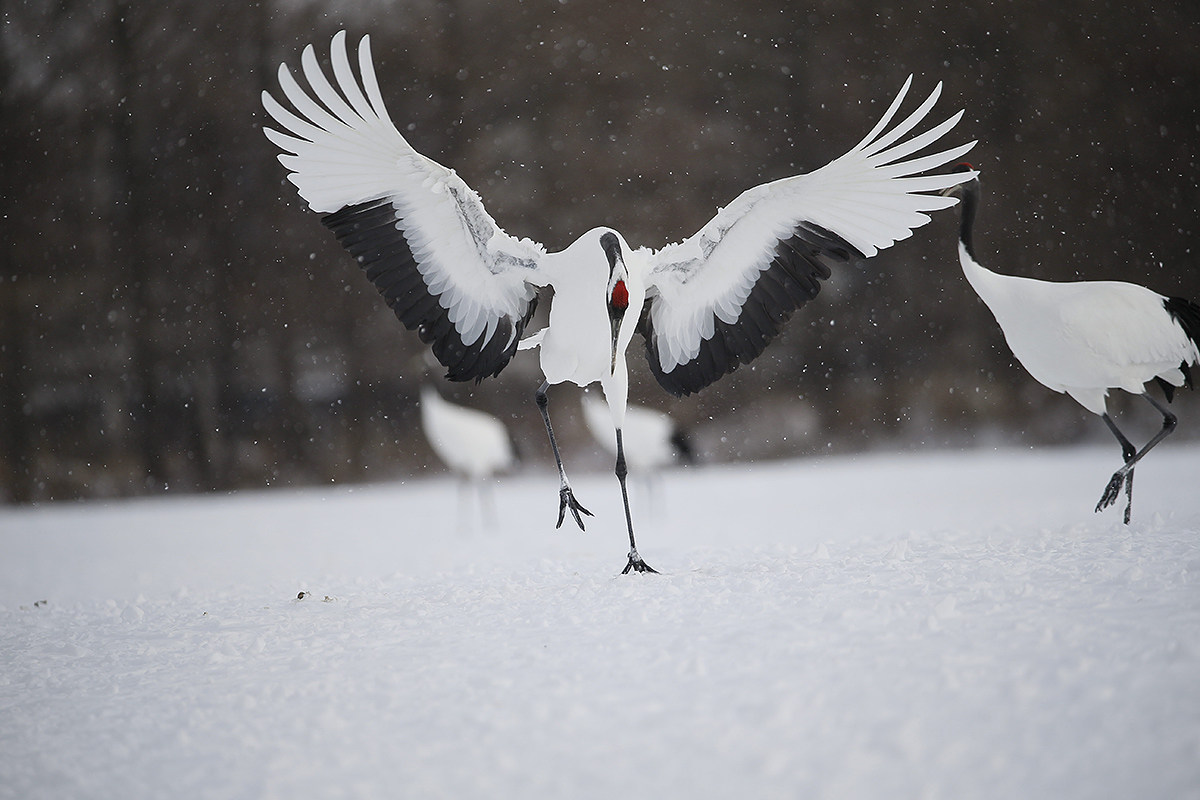
|
|
This image was created at Itoh on the Japan in Winter IPT with the hand held Canon EF 200-400mm f/4L IS USM Lens with Internal 1.4x Extender (at 560mm with the Internal TC in place) and the Canon EOS-1D X. ISO 400. Evaluative metering +2 1/3 stops off the snow: 1/1250 sec. at f/5.6 in Manual mode. Color temperature: AWB.
Central Sensor/AI Servo-Surround/Rear Focus AF on the top of the bird’s right thigh active at the moment of exposure; there is no way to tell whether or not the active sensor above the central sensor caught the end of the bird’s bill, but no worries, the image is very sharp on the head. Click here to see the latest version of the Rear Focus Tutorial. Click on the image to see a larger version.
|
What to Do?
You traveled all the way to Japan. You are in the right place at the right time with the wind behind you, blowing snow, and soft light. You are tracking an incoming crane and as the bird starts to land it beings to display. You are hoping that the bird lands clean, but as you press the shutter button you see that that is not to be. When you view the image on your laptop, you note that the image is not level, that it is slightly underexposed, and that parts of three other cranes are merged with the subject. All in all a pretty much worst case situation…. But, the display is gorgeous and the image is sharp.
What to do? Do you delete the image and move on?
|

|
|
This, the optimized version, was created from the original image above in Photoshop after the RAW conversion was done in DPP.
|
The Image Optimization
What to do? Get to work.
Lighten the image during the RAW conversion in DPP. Open it in Photoshop. Level and crop it. Fill in the long skinny triangle left along the upper right frame edge with the Clone Stamp Tool working small and being careful to avoid obvious repeats. (I tried the John Heado Content Aware Fill method but the filled in area lacked texture so I went to the Clone Stamp.) Eliminate the visible parts of the two cranes directly behind the subject using Denise Ippolito’s great Protect and Defend Cloning with Layers technique that is described on page 92 of Digital Basics. Again, be sure to work small and strive to avoid obvious repeats. Avoiding all snow flake pattern repeats is impossible. Those that are noted can be dealt with with the Spot Healing Brush (J). Get rid of the head of the larger crane on the right by again using Denise Ippolito’s Protect and Defend Cloning with Layers technique Cover the body with several Quick Masks that and fine-tune them with Regular Layer Masks. Clean up the snow/woods demarcation line with a 40% Clone Stamp Tool.
Make the image pop with a Levels Adjustment on its own Layer as described in detail in the “Keep It” blog post here. Sharpen, lighten, and brighten the colors of the head, face, and the black on the neck after selecting those areas carefully with the Quick Selection Tool. (Sharpen with a Contrast Mask, lighten via Control M–Curves on a Layer, and brighten the colors with a Vibrance Adjustment.) Lastly eliminate the slight BLUE cast in the snow with a Hue/Saturation on a layer adjustment (Control U) of the BLUE channel only (by moving the BLUE saturation slider to -100. Save and named. Create your JPEG.
The image optimization probably took close to one hour. Was it worth it?
Truth in Captioning
Whenever I do anything more than minimal clean-up I believe in captioning the images appropriately; here is the caption for this image: Red-crowned Crane landing display–parts of 3 cranes removed _Y5O7632 Hokkaido, Japan.tif. This image could not be entered in the BBC Wildlife Photographer of the Year Competition as they allow only “minor clean-up.” It could, however, be entered in the BIRDS AS ART International Bird Photography Competition. Judging of this year’s contest is currently underway.
Digital Basics
Are you tired of making your images look worse in Photoshop? Do you have no clue as to how I optimized the image above? Everything above plus tons more is detailed in my Digital Basics, an instructional PDF that is sent via e-mail. It includes my complete digital workflow, dozens of great Photoshop tips, the use of Contrast Masks, several different ways of expanding canvas, all of my time-saving Keyboard Shortcuts, Quick Masking, Layer Masking, and NIK Color Efex Pro basics, my killer image clean-up techniques, Digital Eye Doctor, creating time-saving actions, and lots more.
APTATS I & II
Learn the details of advanced Quick Masking techniques in APTATS I. Mention this blog post and apply a $5 discount with phone orders only. Learn advanced Layer Masking Techniques in APTATS II. Mention this blog post and apply a $5 discount with phone orders only. Buy the pair, APTATS I and APTATS II and we will be glad to apply at $15 discount with phone orders only.
The DPP RAW Conversion Guide
After seeing the accurate colors that I get from my DPP RAW conversions, Japan in Winter co-leader Paul McKenzie is switching to DPP conversions and Denise Ippolito is considering doing the same. Now that is amazing…. To learn why I use Canon’s Digital Photo Professional (DPP) to convert every image that I work on, click here.
IPT Info
Many of our great trips are filling up. With 5 Canadians and another couple recently signing up for our 4-DAY Bosque IPT, that workshop is filling up quickly. See also the info on the South Florida and Nickerson Beach IPTs. Two great leaders on most trips ensure that you will receive individual attention, have all of your questions answered, and learn a ton including how to think like a pro, see the situation, read the light and the wind direction, and get the right exposure every time. In addition you will have fun, and make lots of great images. Click here for IPT details and general information.
|

|
|
If you’d like to learn from the two folks who created the images in the composite above do consider one of the trips below. Denise Ippolito’s images: Japanese leaf painting, skimmer in flight, curved Keukenhof paths with tulips, copulating terns, & pink dahlia. Artie’s images: Snow Geese snowstorm blur, crane landing silhouettes, Leopard with prey in tree, King Penguin, & vertical tulip.
|
A Creative Adventure/BIRDS AS ART Instructional Photo-Tours (IPTs)/Two great leaders: Arthur Morris & Denise Ippolito.
Arthur Morris/BIRDS AS ART www.BIRDSASART-blog.com for the latest images, info, & education
Denise Ippolito/A Creative Adventure www.deniseippolito.com: get yourself out of the box!
Denise’s e-books: Bloomin’ Ideas, A Guide to Filters & Effects, The Softer Side of Macro, & more. Free Monthly Creative MiniMag: www.deniseippolito.com/magazine
Holland 2014 7 1/2-Day/8-Night: A Creative Adventure/BIRDS AS ART/Tulips & A Touch of Holland IPT. April 17-April 24, 2014: $4995 Limit: 12/Openings: 5
We still have room for 5 more flower photographers on this great trip.
Join Denise Ippolito, Flower Queen and the author of “Bloomin’ Ideas,” and Arthur Morris, Canon Explorer of Light Emeritus and one of the planet’s premier photographic educators for a great trip to Holland in mid-April 2014. Day 1 of the IPT will be April 17, 2014. We will have a short afternoon get-together and then our first photographic session at the justly-famed Keukenhof. Most days we will return to the hotel for lunch, image sharing and a break. On Day 8, April 24, we will enjoy both morning and afternoon photography sessions.
The primary subjects will be tulips and orchids at Keukenhof and the spectacularly amazing tulip, hyacinth, and daffodil bulb fields around Lisse. In addition we will spend one full day in Amsterdam. There will be optional visits the Van Gogh Museum in the morning and the Anne Frank House in the afternoon; there will be plenty of time for street photography as well. And some great food. On another day we will have a wonderful early dinner at Kinderdijk and then head out with our gear to photograph the windmills and possibly some birds for those who bring their longs lenses. We will spend an afternoon in the lovely Dutch town of Edam where we will do some street photography and enjoy a superb dinner. All lodging, ground transportation, entry fees, and meals (from dinner on Day 1 through dinner on Day 7) are included. For those who will be bringing a big lens we will likely have an optional bird photography afternoon or two.
Click here for additional info or to register.
Nickerson Baby Beach-nesting Birds IPT, Long Island, NY: 3-Full Days/July 22-24, 2014: $1199.
Black Skimmers, Common Terns with chicks, American Oystercatcher & Piping Plover families; breeding behaviors including courtship feeding, display flight and combat, and copulations. Gulls and shorebirds.
UK Puffins IPT. Early July, 2014.
Details TBA. Please e-mail to be placed on the interested list.
Tanzania Serengeti Summer Safari: Leave US: August 9—return: August 24, 2014: $12,999.
Co-leaders: Arthur Morris & Todd Gustafson. Wildebeest/The Great Migration, cats, elephant, giraffe, zebra, birds & more. Please e-mail for brochure.
Swan Island Dahlia Farm IPT, Canby, OR, September 8-12, 2014: 5 FULL DAYS: $1699.
Leader: Denise Ippolito. 40 acres with 350+dazzling varieties of dahlias in a plethora of colors, shapes and sizes. Sharpen your technical skills and boost your creative juices. Daily assignments, image sharing, and Photoshop sessions.
Bosque del Apache 2014 A Creative Adventure/BIRDS AS ART “Creative Photography Instructional Photo-Tour.” (IPT). NOV 24-25, 2014. 2-FULL DAYS: $729.
Leaders: Denise Ippolito & Arthur Morris. Introductory Slide program: 7:00pm on Sunday 11/23. This IPT is perfect for folks who want to learn to think outside the box, to create new and different images. Learn to unleash your creative juices at the wondrous Bosque del Apache, NWR in San Antonio, NM.
Bosque del Apache 2014 BIRDS AS ART/A Creative Adventure Instructional Photo-Tour (IPT). NOV 29-DEC 3, 2014. Totaling 4 FULL-DAYS: $1449
Leaders: Arthur Morris and Denise Ippolito. Introductory Slide program: 7:00pm on Sunday 11/29. Tens of thousand of Snow Geese, 10,000 Sandhill Cranes, ducks, amazing sunrises, sunsets, and blast-offs. Live, eat, and breathe photography with two of the world’s premier photographic educators at one of their very favorite photography locations on the planet.
Antarctica/The Extended Expedition Voyage: Antarctic Peninsula, South Georgia and Falkland Islands: December 13, 2014 to January 10, 2015.
Please e-mail for details.
BAA offers a wide range of books, e-Guides, and educational materials and photographic accessories at the lowest prices around—25+ years of experience, and the best advice you can get. We will not sell you junk. Access the BAA Store here or call us at 1-863-692-0906.
Questions? Please e-mail us at birdsasart@verizon.net or photographybydenise221@gmail.com.
Support the BAA Blog. Support the BAA Bulletins: Shop B&H here!
We want and need to keep providing you with the latest free information, photography and Photoshop lessons, and all manner of related information. Show your appreciation by making your purchases immediately after clicking on any of our B&H or Amazon Affiliate links in this blog post. Remember, B&H ain’t just photography!


 


Amazon
Everyone buys something from Amazon, be it a big lens or deodorant. Support the blog by starting your search by clicking on the logo-link below. No purchase is too small to be appreciated; they all add up. Why make it a habit? Because I make it a habit of bringing you new images and information on an almost daily basis.
Typos
In all blog posts and Bulletins, feel free to e-mail or to leave a comment regarding any typos, wrong words, misspellings, omissions, or grammatical errors. Just be right. 🙂
March 7th, 2014 Jet Lag Update
After reading comments left on the last two blog posts (big time thanks to Jerry Murray and Colin Bradshaw), I consulted my San Diego health guru, Dr. Cliff Oliver. He suggested getting some time-release melatonin and taking a small dose at bed-time. I could not get the time release stuff in Lake Wales so I got the regular in the 3mg dose. I cut one tablet in half, took that just before bedtime–11:00pm, made one pit stop during which I took the remaining 1/2 of the pill, fell quickly back to sleep, and woke up refreshed at 7:30am. It was one of my best night’s sleep in a decade. (My ice baths, which I began when I got back, always help with sleep via fewer pit stops.) Like Cliff on Facebook and learn a ton about Wellness here.
The Streak
This post marks 98 straight days with a new blog post, a record by far that should be extended for at least another day or so, or not. Or more…. To show your appreciation for my efforts here, we ask that use our B&H and Amazon affiliate links for all of your B&H and Amazon purchases. Please check the availability of all photographic accessories in the BIRDS AS ART Online Store. We sell only what I use and depend on. We will not sell you junk. We know what you need to make creating great images easy and fun. And we are always glad to answer your gear questions via e-mail.
You can find the following items in the store: Gitzo tripods, Mongoose M3.6 and Wimberley heads, plates, low feet, and accessories, flash brackets, , Delkin e-film Pro Compact Flash Cards, LensCoat products, and our unique line-up of educational materials including ABP I & II, Digital Basics, Site and Set-up e-Guides, Canon and Nikon Camera Users and AF e-Guides, and MP-4 Photoshop video tutorials among others.
We would of course appreciate you using our B&H and Amazon affiliate links for all of your B&H and Amazon major gear, video, electronic, household, and personal purchases. For the photographic stuff mentioned in the paragraph above we would of course greatly appreciate your business. Here is a huge thank you to the many who have been using our links on a regular basis and visiting the BAA Online store as well.
This blog post took about 1 1/2 hours to prepare. Enjoy.
|

|
|
Images copyright 2012: Denise Ippolito & Arthur Morris. Card design by Denise Ippolito. Click on the image to enjoy a spectacular larger version.
|
Gear Bag for Holland
Now that I am back from Japan, I am looking forward to the Holland IPT. I will be traveling light. For me at least 🙂 Here, is the gear that I will be bringing along with an explanation of why for each item:
Canon EF 100mm f/2.8L Macro IS USM lens. This will likely be my most used lens on the tripod. I will hand hold it using the techniques that Denise Ippolito taught the group on the last Tulip IPT and use it on the tripod with the Canon Tripod Mount Ring D for 100mm f/2.8L IS Macro lens. The lens does not come with a tripod collar. A separate purchase is required. You can save well more than $100 by going with the Vello Tripod Collar D (Black) for Canon EF 100mm f/2.8L IS USM Macro lens. I will surely use the 100 macro lens on a tripod a lot more than denise will even though she uses the older non-IS model that she loves. I did not own this lens at the time of the Holland trip last year; I can’t wait to get back and see what I can do with it.
Canon EF 180mm f/3.5L Macro USM lens. This was my former favorite macro lens. It gives you a bit more reach and a narrower angle of view than the 100 macro lenses. I use it often with a 1.4X III TC.
Canon EF 200-400mm f/4L IS USM lens with Internal 1.4x Extender. Last year I brought my Canon EF 600mm f/4L IS II USM lens into the Willem-Alexander Pavilion at Keukenhof there was lots of staring going on. This year the 2-4 will be my long lens for the tulips. With an external 1.4X III in place it will give me 784mm of reach that will be great for isolating single flowers. In addition, it should be great for our optional afternoon of Purple Heron flight photography and possibly for Great-crested Grebe as well.
Canon EF 70-200mm f/2.8L IS II USM lens. This versatile intermediate telephoto lens is perfect for the tulip fields. Last year I used it often to create both sharp images as well as zoom, pan, and shiver blurs. (Learn more in A Guide to Pleasing Blurs by Denise Ippolito and yours truly.)
Canon EF 24-70mm f/2.8L II USM lens. Never leave home without a short zoom lens. I replaced the older Canon EF 24-105mm f/4L IS USM lens with the 24-70II because the latter is clearly sharper and because it meshes perfectly with my 70-200 f/2.8 L IS II. On this trip I will be hand holding this lens whenever I use it.
Canon Extender EF 1.4X III. I will have two along as I never travel without a back-up for my most valuable accessory. I will one available when I need extra reach either with the 180 macro or the 200-400.
Canon Extension Tube EF 25 II & Canon Extension Tube EF 12 II. I am bringing two of the former and one of the latter to allow for closer focusing. I often use them in combination. Be sure to stop down a bunch whenever using an extension tube to prevent vignetting.
Canon EOS 5D Mark III DSLR camera body. For the superb image quality of the 5D III’s 22.3 megapixel files the lightweight 5D III is my go-to camera body for flowers. And don’t forget the in-camera HDR and in-camera Multiple Exposure features.
Canon EOS-1D X Digital camera body. The 1D X is my primo bird photography body so I will use it for the Purple Herons and have it along as my back-up body. You should never make a big trip without a back-up camera body. Renting a body from BorrowLenses using our affiliate link is a great option.
Gitzo 3532 LS carbon fiber tripod & the Mongoose M3.6 head. This combination works every bit as well with my Macro lenses as it does with my 600 II and will allow me to photograph the Purple Herons in flight off a tripod should my arms get weary.
Did I miss anything?
Questions
If you have any questions on what I am bringing or on any of the gear above, feel free to ask by leaving a comment.
Learning on BPN (BirdPhotographers.net/It Ain’t Just Birds!
I am consistently amazed that in addition to teaching others through honest critiques done gently how much I learn while offering helpful critiques. For a great example, see Iain Barker’s Chaffinch post here. There is a great example of making accurate Curves adjustments and I learned a ton about using Hue/Saturation to attain the right colors.
See the newly designed Home Page here, see all of our great forums here, or visit the Avian Forum here. The Avian Forum alone has had 48,311 images posted for critiquing and 437,372 Replies. That’s a lot of learning!
Holland 2014 7 1/2-Day/8-Night: A Creative Adventure/BIRDS AS ART/Tulips & A Touch of Holland IPT. April 17-April 24, 2014: $4995 Limit: 12/Openings: 5
Act soon: this trip is not far off.
Join Denise Ippolito, Flower Queen and the author of “Bloomin’ Ideas,” and Arthur Morris, Canon Explorer of Light Emeritus and one of the planet’s premier photographic educators for a great trip to Holland in mid-April 2014. Day 1 of the IPT will be April 17, 2014. We will have a short afternoon get-together and then our first photographic session at the justly-famed Keukenhof. Most days we will return to the hotel for lunch, image sharing and a break. On Day 8, April 24, we will enjoy both morning and afternoon photography sessions.
The primary subjects will be tulips and orchids at Keukenhof and the spectacularly amazing tulip, hyacinth, and daffodil bulb fields around Lisse. In addition we will spend one full day in Amsterdam. There will be optional visits the Van Gogh Museum in the morning and the Anne Frank House in the afternoon; there will be plenty of time for street photography as well. And some great food. On another day we will have a wonderful early dinner at Kinderdijk and then head out with our gear to photograph the windmills and possibly some birds for those who bring their longs lenses. We will spend an afternoon in the lovely Dutch town of Edam where we will do some street photography and enjoy a superb dinner. All lodging, ground transportation, entry fees, and meals (from dinner on Day 1 through dinner on Day 7) are included.
For those who will be bringing a big lens we will likely have an optional bird photography afternoon or two. If we get lucky, the big attraction should be gorgeous Purple Herons in flight at a breeding marsh. We would be photographing them from the roadside. And we might be able to find a few Great-crested Grebes at a location near Keukenhof.
You will learn to create tight abstracts, how to best use depth-of-field (or the lack thereof) to improve your flower photography, how to get the right exposure and make sharp images every time, how to see the shot, and how to choose the best perspective for a given situation. And you will of course learn to create a variety of pleasingly blurred flower images. If you bring a long lens, you will learn to use it effectively for flower photography. Denise’s two favorite flower lenses are the Canon 100mm macro and the Canon 24-105mm zoom. Mine are the Canon 180mm macro lens and the Canon 600mm f/4L IS II, both always on a tripod and both often used with extension tubes and/or the 1.4X teleconverters. Denise hand holds a great deal of the time. For flower field blurs denise uses the same lenses mentioned above. My favorite is the 70-200 often with a 1.4X TC but I use both the 24-105 and the 600 II as well. Both of us use and love the Canon EOS-5D Mark III for all of our flower photography. The in-camera HDR and Multiple Exposure features are a blast.
One of the great advantages of our trip is that we will be staying in a single, strategically located hotel that is quite excellent. Do note that all ground transfers to and from Schipol will be via hotel shuttle bus.
What’s included: Eight hotel nights. All ground transportation except for airport transfers as noted above. In-the-field instruction and small group image review and Photoshop sessions. All meals from dinner on Day 1 through dinner on Day 8. The hotel we are staying in often offers both lunch and dinner buffets. The food is excellent. Whenever you order off the menu be it at the hotel or at one of the several fine-dining spots that we will be enjoying at various locations, only the cost of your main course is included. On these occasions the cost of soups, appetizers, salads, sodas and other beverages, alcoholic drinks and wine, bottled water, and desserts are not included. This is done in part in hopes that folks will be less inclined to enjoy an eight course dinner so that we can get to bed early. As with all A Creative Adventure/BIRDS AS ART Instructional Photo-Tours both the photo sessions and the days are long. Nothing that we do however will be demanding. Being able to sit down on the ground with your gear is, however, a huge plus. Anyone in halfway decent shape should be fine.
Snacks, personal items, phone calls, etc. are not included.
Beware of seemingly longer, slightly less expensive tours that include travel days and days sitting in the hotel doing nothing as part of the tour. In addition, other similar trips have you changing hotels needlessly. The cost of this years trip is a bit higher than last years to reflect our increased experience and the extra hotel night that is included. One final note on other similar trips: the instructors on this trip actually instruct. On other similar trips the instructors, though usually eminently qualified, serve for the most part as van drivers….
Happy Campers only please. A non-refundable deposit of $1,000 per person is required to hold your spot. The second payment of $2,000 due by October 30, 2013. The balance is due on January 15, 2014. Payments in full are of course welcome at any time. All payments including the deposit must be made by check made out to “Arthur Morris.” As life has a way of throwing an occasional curve ball our way, you are urged to purchase travel insurance within 15 days of our cashing your check. I use and recommend Travel Insurance Services. All payments are non-refundable unless the trip fills to capacity. In that case, all payments but your deposit will be refunded.
All checks should be made out to “Arthur Morris” and sent to: Arthur Morris, PO Box 7245, Indian Lake Estates, FL 33855. Please fill out the paperwork here and include a signed copy with your deposit check.
IPT Info
Many of our great trips are filling up. With 5 Canadians signing up for our 4-DAY Bosque IPT, that workshop is filling up quickly. See also the info on the South Florida and Nickerson Beach IPTs. Two great leaders on most trips ensure that you will receive individual attention, have all of your questions answered, and learn a ton including how to think like a pro, see the situation, read the light and the wind direction, and get the right exposure every time. In addition you will have fun, and make lots of great images. Click here for IPT details and general information.
For couples or friends signing up at the same time for the tulip trip, a $200/person discount will be applied to the final payment.
Click here for complete details and lots of wonderful images with our legendary educational captions. Click here and see item one for lots more tulip images.
UK Puffins and Gannets in Flight IPT: early July 2014.
Please e-mail if interested. Details TBA very soon.
Support the BAA Blog. Support the BAA Bulletins: Shop B&H here!
We want and need to keep providing you with the latest free information, photography and Photoshop lessons, and all manner of related information. Show your appreciation by making your purchases immediately after clicking on any of our B&H or Amazon Affiliate links in this blog post. Remember, B&H ain’t just photography!


 


Amazon
Everyone buys something from Amazon, be it a big lens or deodorant. Support the blog by starting your search by clicking on the logo-link below. No purchase is too small to be appreciated; they all add up. Why make it a habit? Because I make it a habit of bringing you new images and information on an almost daily basis.
Typos
In all blog posts and Bulletins, feel free to e-mail or to leave a comment regarding any typos, wrong words, misspellings, omissions, or grammatical errors. Just be right. 🙂
March 6th, 2014
|
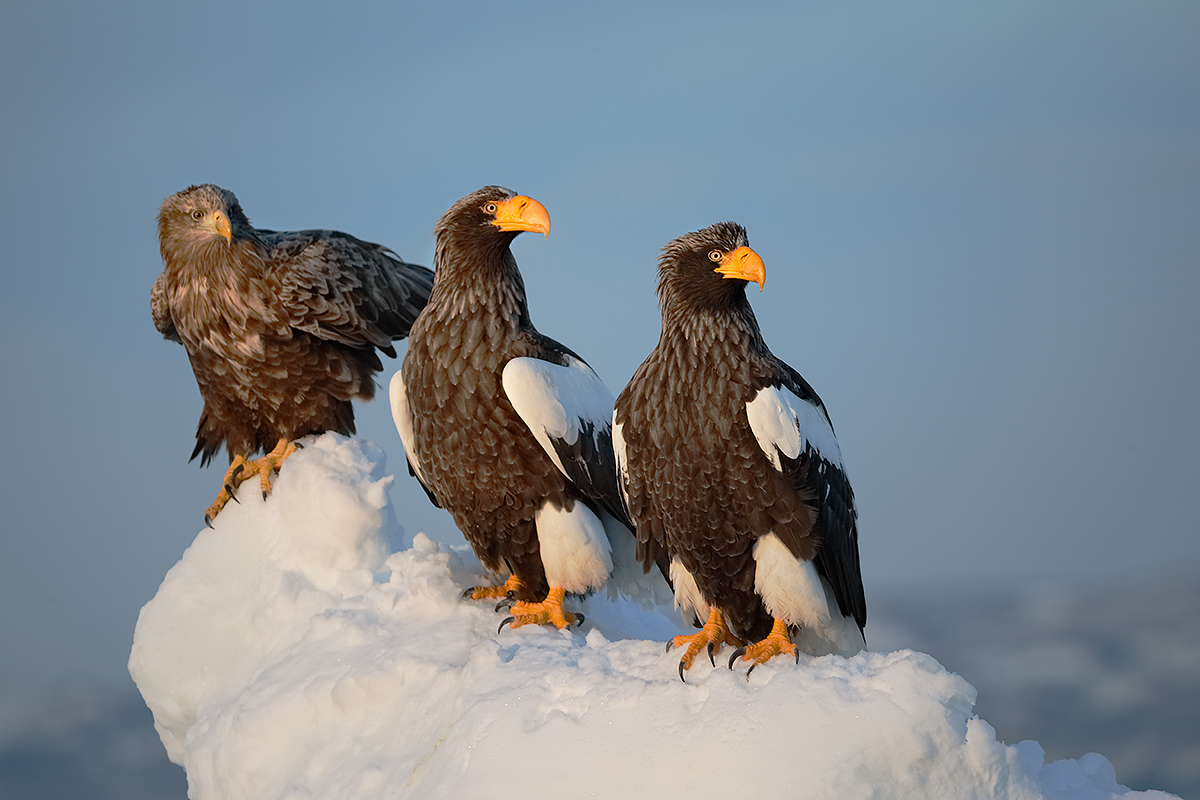
|
|
This trio of sea eagles, two Steller’s and one White-tailed, was photographed on the very early morning of February 21, 2014 at 6:36am on the Japan in Winter IPT with the Gitzo 3532 LS carbon fiber tripod, the Mongoose M3.6 head, the Canon EF 200-400mm f/4L IS USM Lens with Internal 1.4x Extender (at 388mm with the Internal TC in place) and the Canon EOS-1D X. ISO 1600 was somewhat of an error for this static image…. Evaluative metering +1 1/3 stops off the ice: 1/1000 sec. at f/5.6 in Manual mode. Color temperature: AWB.
Two sensors to the right of the central Sensor/AI Servo-Surround/Rear Focus AF on the upper breast of the right-hand bird active at the moment of exposure. Click here to see the latest version of the Rear Focus Tutorial. Click on the image to see a larger version.
Being able to quickly and accurately move the AF sensors around the array is a skill that all need to master. Learn how in one of our camera User’s Guides.
|
Jet Lag with a Vengeance…
Getting to distant lands rife with great birds in great settings like the sea eagle trio above is one of the big benefits of being a professional nature photographer. In addition to the airfare,however, there is often a big price to pay that comes with long international flights. Jet lag. Yesterday, I thought that I would be fine. I woke at 6:30am, took a short nap in the afternoon, and had lots of energy throughout the day. It was rather strange. Things got even stranger as the evening grew deeper. I turned off the laptop at about 11:30pm but still was feeling strong. So I watched some more of the Winter Olympics on TIVO and followed that up with a complete episode of a PBA (Professional Bowler’s Association) league event. I bowled a lot when I was a young teen. Don’t ask me what got into me….
I finally got into bed at 1:30am confident that I would sleep a good 7 hours at least. Wrong. I woke at 4:00am feeling wide awake. I tried to get back to sleep by concentrating on my breath as I usually do. That failed. So I flipped on the light and grabbed the book that I have been loving, Kazuo Ishiguro’s When We Were Orphans I read. And I read. And I read some more. Never once did the book hit me in the head. I read. And I read. And I read some more. Never once did the book hit me in the head.
140 pages later, at 6:00am, I finished the book. The type was small. I got up, had breakfast–it’s good to be eating properly again, answered various e-mails, and began work on this blog post at about 8:00am. It is now 9:35; with only 2 1/2 hours sleep, I am yawning and exhausted. When I finish this post at about ten I will take what I hope will be the day’s only short nap and then take a swim.
The Image Optimization
After converting the image in DPP the first thing that I did in Photoshop was a rather elaborate (for me) Curves Adjustment, pinning the curve in several spots, darkening the dark and darkening the blue sky while maintaining the tonality of the WHITEs. I further blackened the BLACKs (+2) and the MIDTONEs (+2) with my Selective Color Action. Then I duplicated the whole image, ran a 100% Linear Burn on that layer, and painted it in at 15% on the highlights as needed. I ran a 15/65/0 contrast mask on the bird’s heads and bills to sharpen them and then ran a second contrast mask using a Quick Mask on the head of the white-tailed as that bird was slightly beyond the depth-of-field. I cleaned up a few dust spots and ran Filter/Blur/Surface Blur at 2/4 on the whole image to clean up the noise. The whole thing took well less than 10 minutes.
Digital Basics
Are you tired of making your images look worse in Photoshop? Everything above plus tons more is detailed in my Digital Basics, an instructional PDF that is sent via e-mail. It includes my complete digital workflow, dozens of great Photoshop tips, the use of Contrast Masks, several different ways of expanding canvas, all of my time-saving Keyboard Shortcuts, Quick Masking, Layer Masking, and NIK Color Efex Pro basics, my killer image clean-up techniques, Digital Eye Doctor, creating time-saving actions, and lots more.
APTATS I & II
Learn the details of advanced Quick Masking techniques in APTATS I. Mention this blog post and apply a $5 discount with phone orders only. Learn advanced Layer Masking Techniques in APTATS II. Mention this blog post and apply a $5 discount with phone orders only. by the pair, APTATS I and APTATS II and we will be glad to apply at $15 discount with phone orders only.
The DPP RAW Conversion Guide
After seeing the accurate colors that I get from my DPP RAW conversions, Japan in Winter co-leader Paul McKenzie is switching to DPP conversions and Denise Ippolito is considering doing the same. Now that is amazing…. To learn why I use Canon’s Digital Photo Professional (DPP) to convert every image that I work on, click here.
The Streak
This post marks 97 straight days with a new blog post, a record by far that should be extended for at least another day or so, or not. Or more…. To show your appreciation for my efforts here, we ask that use our B&H and Amazon affiliate links for all of your B&H and Amazon purchases. Please check the availability of all photographic accessories in the BIRDS AS ART Online Store. We sell only what I use and depend on. We will not sell you junk. We know what you need to make creating great images easy and fun. And we are always glad to answer your gear questions via e-mail.
You can find the following items in the store: Gitzo tripods, Mongoose M3.6 and Wimberley heads, plates, low feet, and accessories, flash brackets, , Delkin e-film Pro Compact Flash Cards, LensCoat products, and our unique line-up of educational materials including ABP I & II, Digital Basics, Site and Set-up e-Guides, Canon and Nikon Camera Users and AF e-Guides, and MP-4 Photoshop video tutorials among others.
We would of course appreciate you using our B&H and Amazon affiliate links for all of your B&H and Amazon major gear, video, electronic, household, and personal purchases. For the photographic stuff mentioned in the paragraph above we would of course greatly appreciate your business. Here is a huge thank you to the many who have been using our links on a regular basis and visiting the BAA Online store as well.
This blog post took about 2 hours to prepare. Enjoy.
IPT Info
Many of our great trips are filling up. With 5 Canadians signing up for our 4-DAY Bosque IPT, that workshop is filling up quickly. See especially info on the South Florida, Holland, and Nickerson Beach IPTs. Two great leaders on most trips ensure that you will receive individual attention, have all of your questions answered, and learn a ton including how to think like a pro, see the situation, and get the right exposure every time. In addition you will have fun, and make lots of great images. Click here for IPT details and general information.
|

|
|
Images copyright 2012: Denise Ippolito & Arthur Morris. Card design by Denise Ippolito. Click on the image to enjoy a spectacular larger version.
|
Holland 2014 7 1/2-Day/8-Night: A Creative Adventure/BIRDS AS ART/Tulips & A Touch of Holland IPT. April 17-April 24, 2014: $4995 Limit: 12/Openings: 5
We still have room for 5 more flower photographers on this great trip.
Join Denise Ippolito, Flower Queen and the author of “Bloomin’ Ideas,” and Arthur Morris, Canon Explorer of Light Emeritus and one of the planet’s premier photographic educators for a great trip to Holland in mid-April 2014. Day 1 of the IPT will be April 17, 2014. We will have a short afternoon get-together and then our first photographic session at the justly-famed Keukenhof. Most days we will return to the hotel for lunch, image sharing and a break. On Day 8, April 24, we will enjoy both morning and afternoon photography sessions.
The primary subjects will be tulips and orchids at Keukenhof and the spectacularly amazing tulip, hyacinth, and daffodil bulb fields around Lisse. In addition we will spend one full day in Amsterdam. There will be optional visits the Van Gogh Museum in the morning and the Anne Frank House in the afternoon; there will be plenty of time for street photography as well. And some great food. On another day we will have a wonderful early dinner at Kinderdijk and then head out with our gear to photograph the windmills and possibly some birds for those who bring their longs lenses. We will spend an afternoon in the lovely Dutch town of Edam where we will do some street photography and enjoy a superb dinner. All lodging, ground transportation, entry fees, and meals (from dinner on Day 1 through dinner on Day 7) are included. For those who will be bringing a big lens we will likely have an optional bird photography afternoon or two.
Click here for additional info or to register.

|
|
Join me for the 2014 Tanzania Summer Safari!
|
2014 Tanzania Summer Safari, 14-day African Adventure/leave the US on August 9. Fly home on August 24: $12,999.
Co-leaders Todd Gustafson & Arthur Morris. The limit is 12. Three photographers/van; you get your own row of seats. Our trip is a bit more expensive than the average safari for good reason. It is the best. We have the best driver guides with a total of decades of experience. They have been trained over the years by Todd and by me to drive with photography in mind. We have the best and most knowledgeable leaders. We stay in the best lodges and camps. We hope that you will join us for what will be Todd’s 35th African safari, and my 8th.
If you are seriously interested please e-mail me; I will be glad to send you the illustrated PDF with the complete itinerary and deposit info.
What else makes this expedition unique?
•Pre-trip consultation and camera equipment advice
•Award-winning photographers as your guides
•A seamless itinerary visiting the right locations at the best time of year
•Hands-on photography instruction in the field
•Specially designed three roof-hatch photo safari vehicles
•Proprietary materials for preparation, including free copy of “A Photographer’s Guide to Photographing in East Africa.”
•Post-safari image critiques
All-inclusive (double-occupancy) except for your flights to and from Kilamajaro Airport, bar drinks, soda & water (except at the Intimate Tented Camp where everything is free for our entire stay), tips for drivers and camp staff, personal items, and trip insurance.

|
|
Breathe deeply, bite the bullet, and live life to its fullest; we all get only one ride on the merry-go-round… Join me on this great trip.
Click on the image to enjoy a larger version.
|
The Southern Ocean…
If you would like to explore the possibility of joining me on the Cheesemans’ Ecology Safaris Antarctica/The Extended Expedition Voyage< trip: Antarctic Peninsula, South Georgia and Falkland Islands: December 13, 2014 to January 10, 2015, click here for additional information and then shoot me an e-mail.
The DPP RAW Conversion Guide
To learn why I use Canon’s Digital Photo Professional (DPP) to convert every image that I work on, click here.
Support the BAA Blog. Support the BAA Bulletins: Shop B&H here!
We want and need to keep providing you with the latest free information, photography and Photoshop lessons, and all manner of related information. Show your appreciation by making your purchases immediately after clicking on any of our B&H or Amazon Affiliate links in this blog post. Remember, B&H ain’t just photography!


 


Amazon
Everyone buys something from Amazon, be it a big lens or deodorant. Support the blog by starting your search by clicking on the logo-link below. No purchase is too small to be appreciated; they all add up. Why make it a habit? Because I make it a habit of bringing you new images and information on an almost daily basis.
Typos
In all blog posts and Bulletins, feel free to e-mail or to leave a comment regarding any typos, wrong words, misspellings, omissions, or grammatical errors. Just be right. 🙂
March 5th, 2014 Home Safely
After a stop at Junior’s Fish Market and the vegetable stand in Lake Wales I made it home safely to Indian Lake Estates at 6:00pm on Tuesday evening after flying out of Tokyo at noon the same day, connecting in Dallas (DFW). and arriving at the gate in Orlando (MCO) at 2:00pm.
Jet Lag Update
I hardly slept at all on my flights, maybe 2 hours in all at most, that in drips and drabs. When I got home I was exhausted but did not want to go right to bed. Or take a nap. I figured that if I could stay up for a while that I might get right back on schedule…. So I answered some e-mails and spent some time on BPN issues. I climbed into bed at 9:30pm, read for a bit, and soon it was lights out for me. I awoke at 12:15am. I was wide awake. Very wide awake. I thought that I was toast. After all, my body thought that it was 2:15pm in Japan. I almost got up to work on this blog post but decided to try reading again for a while. After I dropped the book a few times I turned out the light and slept till 6:30am. Right now I am feeling great. Swim at 11.
Kazuo Ishiguro
I was lucky to find a used copy of Kazuo Ishiguro’s When We Were Orphans to read on the flight home. Only 1530 yen; that 14.9435 US dollars. From NY Times Books: A search for identity masquerading as a detective novel. I had never heard of the author until I picked up the book at the book shop in Narita Airort. Kazuo Ishiguro was born in Nagasaki in 1954 and moved to Great Britain at age 5. He is the author of 6 novels including including the international bestsellers The Remains of the Day to read on the flight home. Only 1530 yen; that 14.9435 US dollars. From NY Times Books: A search for identity masquerading as a detective novel. I had never heard of the author until I picked up the book at the book shop in Narita Airort. Kazuo Ishiguro was born in Nagasaki in 1954 and moved to Great Britain at age 5. He is the author of 6 novels including including the international bestsellers The Remains of the Day (winner of the Booker Prize) and Never Let Me Go (winner of the Booker Prize) and Never Let Me Go I need to read those two because this guy can write; even though I watched 3 movies on the plane I am already up to page 198…. I need to read those two because this guy can write; even though I watched 3 movies on the plane I am already up to page 198….
Click here for more books by this fine author. for more books by this fine author.
The Streak
This post marks 96 straight days with a new blog post, a record by far that should be extended for at least another day or so, or not. Or more…. To show your appreciation for my efforts here, we ask that use our B&H and Amazon affiliate links for all of your B&H and Amazon purchases. Please check the availability of all photographic accessories in the BIRDS AS ART Online Store. We sell only what I use and depend on. We will not sell you junk. We know what you need to make creating great images easy and fun. And we are always glad to answer your gear questions via e-mail.
You can find the following items in the store: Gitzo tripods, Mongoose M3.6 and Wimberley heads, plates, low feet, and accessories, flash brackets, , Delkin e-film Pro Compact Flash Cards, LensCoat products, and our unique line-up of educational materials including ABP I & II, Digital Basics, Site and Set-up e-Guides, Canon and Nikon Camera Users and AF e-Guides, and MP-4 Photoshop video tutorials among others.
We would of course appreciate you using our B&H and Amazon affiliate links for all of your B&H and Amazon major gear, video, electronic, household, and personal purchases. For the photographic stuff mentioned in the paragraph above we would of course greatly appreciate your business. Here is a huge thank you to the many who have been using our links on a regular basis and visiting the BAA Online store as well.
This blog post took roughly 3 1/2 hours to prepare. Enjoy and comment 🙂
Thanks a Huge Stack!
Thanks a stack to all who visit the blog regularly. February was a record month for the BAA B&H affiliate program. And dozens of folks are getting in the habit of using Amazon for both their minor household and entertainment purchases as well as for major purchases. Their kindness is greatly appreciated and it is great to see that the streak is paying dividends. Love you all. artie
|
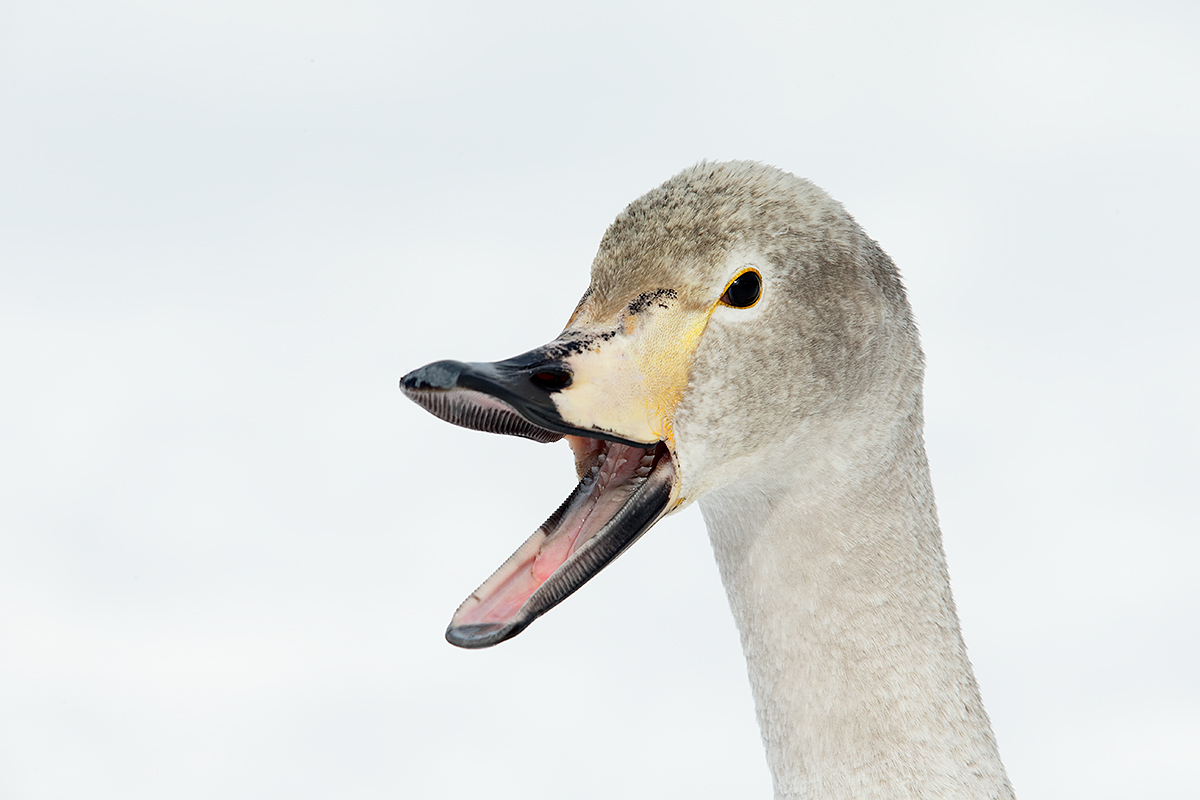
|
|
This image was created with the Gitzo 3532 LS carbon fiber tripod, the Mongoose M3.6 head, the Canon EF 600mm f/4L IS II USM lens, the Canon 2x EF Extender III (Teleconverter), and the Canon EOS-1D X Digital SLR camera. ISO 400. Evaluative metering +2 1/3 stops off the snow in very in soft sunlight: 1/320 sec. at f/13 in Manual mode. Color Temperature: 6,000K.
Central sensor (by necessity) Expand/AI Servo/Rear Focus on the center of the upper mandible as framed active at the moment of exposure. Click here if you missed the Rear Focus Tutorial. Be absolutely sure to click on the image to see a larger version.
Image #1: Immature With Bill Open
|
More From Our Great Swan Morning
We enjoyed three great sessions with the Whooper Swans. See Canon EF 24-70mm f/2.8L II USM Lens: Early Impressions for images from our sublime afternoon and 600 f/4 L IS II with 1.4X II TC and the 200-400 f/4L IS with Internal TC at Swan Lake for details of our wonderful morning at Lake Kussharo *say koo-SOR-row) on the way to Rausu (ROU-soo) for the sea eagles.
After the early morning flight and behavior action most of the huge swans laid down on the ice, tucked their heads into their back feathers, and went to sleep. At times, as shown in the image above, some of the birds would pick their heads up to talk to their neighbors. I followed my own advice from ABP II and elsewhere: when unexpected action occurs press the shutter button. I had been stopped down while photographing the sleeping birds (see the post here) and thought about trying to switch to a faster shutter speed for the image above but got lucky with the relatively slow shutter speed.
Contagious Yakking
With many groups of swans scattered about on the ice it was common that whenever one bird began to call and display that several of its neighbors would immediately chime in in similar fashion. Thus, when I made the image above the head of a second adult swan appeared in the frame.
Image Question
In the image above, do you like the 2nd bird in the frame? Would you remove it?
The Image Repair
To create the image above from Image #2 I followed the steps in an APTATS II tutorial to eliminate the 2nd bird. For this technique to work effectively, the background needs to be uniform as was the case here. The repair took about 40 seconds. If I would take the time to set up an action as described in the text I could easily cut that time in half; please don’t ask my why I have failed to do so for the past 3 years….
Questions on Your Preferences
Which do you like better, the image with the 2 birds in the frame or the image with the 2nd bird removed? Be sure to let us know why you made your choice.
Of the 3 images here, which is your favorite. Why?
Yakety Yak
Click here to listen to the Coaster’s original 1958 version of Yakety Yak (don’t talk back).
Digital Basics
Do you like the look of my posted images? Learn everything that I know about using Photoshop in Digital Basics, an instructional PDF that is sent via e-mail. It includes my complete digital workflow, dozens of great Photoshop tips, the use of Contrast Masks, several different ways of expanding canvas, all of my time-saving Keyboard Shortcuts, Quick Masking, Layer Masking, and NIK Color Efex Pro basics, my killer image clean-up techniques, Digital Eye Doctor, and lots more.
APTATS I & II
Learn the details of advanced Quick Masking techniques in APTATS I. Mention this blog post and apply a $5 discount with phone orders only. Learn advanced Layer Masking Techniques in APTATS II. Mention this blog post and apply a $5 discount with phone orders only. by the pair, APTATS I and APTATS II and we will be glad to apply at $15 discount with phone orders only.
The DPP RAW Conversion Guide
After seeing the accurate colors that I get from my DPP RAW conversions, Japan in Winter co-leader Paul McKenzie is switching to DPP conversions and Denise Ippolito is considering doing the same. Now that is amazing…. To learn why I use Canon’s Digital Photo Professional (DPP) to convert every image that I work on, click here.
|

|
|
If you’d like to learn from the two folks who created the images in the composite above do consider one of the trips below. Denise Ippolito’s images: Japanese leaf painting, skimmer in flight, curved Keukenhof paths with tulips, copulating terns, & pink dahlia. Artie’s images: Snow Geese snowstorm blur, crane landing silhouettes, Leopard with prey in tree, King Penguin, & vertical tulip.
|
A Creative Adventure/BIRDS AS ART Instructional Photo-Tours (IPTs)/Two great leaders: Arthur Morris & Denise Ippolito.
Arthur Morris/BIRDS AS ART www.BIRDSASART-blog.com for the latest images, info, & education
Denise Ippolito/A Creative Adventure www.deniseippolito.com: get yourself out of the box!
Denise’s e-books: Bloomin’ Ideas, A Guide to Filters & Effects, The Softer Side of Macro, & more. Free Monthly Creative MiniMag: www.deniseippolito.com/magazine
Nickerson Baby Beach-nesting Birds IPT, Long Island, NY: 3-Full Days/July 22-24, 2014: $1199.
Black Skimmers, Common Terns with chicks, American Oystercatcher & Piping Plover families; breeding behaviors including courtship feeding, display flight and combat, and copulations. Gulls and shorebirds.
UK Puffins IPT. Early July, 2014.
Details TBA. Please e-mail to be placed on the interested list.
Tanzania Serengeti Summer Safari: Leave US: August 9—return: August 24, 2014: $12,999.
Co-leaders: Arthur Morris & Todd Gustafson. Wildebeest/The Great Migration, cats, elephant, giraffe, zebra, birds & more. Please e-mail for brochure.
Swan Island Dahlia Farm IPT, Canby, OR, September 8-12, 2014: 5 FULL DAYS: $1699.
Leader: Denise Ippolito. 40 acres with 350+dazzling varieties of dahlias in a plethora of colors, shapes and sizes. Sharpen your technical skills and boost your creative juices. Daily assignments, image sharing, and Photoshop sessions.
Bosque del Apache 2014 A Creative Adventure/BIRDS AS ART “Creative Photography Instructional Photo-Tour.” (IPT). NOV 24-25, 2014. 2-FULL DAYS: $729.
Leaders: Denise Ippolito & Arthur Morris. Introductory Slide program: 7:00pm on Sunday 11/23. This IPT is perfect for folks who want to learn to think outside the box, to create new and different images. Learn to unleash your creative juices at the wondrous Bosque del Apache, NWR in San Antonio, NM.
Bosque del Apache 2014 BIRDS AS ART/A Creative Adventure Instructional Photo-Tour (IPT). NOV 29-DEC 3, 2014. Totaling 4 FULL-DAYS: $1449
Leaders: Arthur Morris and Denise Ippolito. Introductory Slide program: 7:00pm on Sunday 11/29. Tens of thousand of Snow Geese, 10,000 Sandhill Cranes, ducks, amazing sunrises, sunsets, and blast-offs. Live, eat, and breathe photography with two of the world’s premier photographic educators at one of their very favorite photography locations on the planet.
Antarctica/The Extended Expedition Voyage: Antarctic Peninsula, South Georgia and Falkland Islands: December 13, 2014 to January 10, 2015.
Please e-mail for details.
BAA offers a wide range of books, e-Guides, and educational materials and photographic accessories at the lowest prices around—25+ years of experience, and the best advice you can get. We will not sell you junk. Access the BAA Store here or call us at 1-863-692-0906.
Questions? Please e-mail us at birdsasart@verizon.net or photographybydenise221@gmail.com.
Support the BAA Blog. Support the BAA Bulletins: Shop B&H here!
We want and need to keep providing you with the latest free information, photography and Photoshop lessons, and all manner of related information. Show your appreciation by making your purchases immediately after clicking on any of our B&H or Amazon Affiliate links in this blog post. Remember, B&H ain’t just photography!


 


Amazon
Everyone buys something from Amazon, be it a big lens or deodorant. Support the blog by starting your search by clicking on the logo-link below. No purchase is too small to be appreciated; they all add up. Why make it a habit? Because I make it a habit of bringing you new images and information on an almost daily basis.
Typos
In all blog posts and Bulletins, feel free to e-mail or to leave a comment regarding any typos, wrong words, misspellings, omissions, or grammatical errors. Just be right. 🙂
IPT Info
Many of our great trips are filling up. See especially info on the Holland, Nickerson Beach, and Bosque IPTs. Two great leaders on most trips ensure that you will receive individual attention, have all of your questions answered, and learn a ton including how to think like a pro, see the situation, and get the right exposure every time. In addition you will have fun, and make lots of great images. Click here for IPT details and general information.
March 4th, 2014 The Streak Goes on Despite International Travel Day
I worked on this blog post on the train to Tokyo and again last night. I am putting the finishing touches on it just after 5am Japan time on Tuesday, March 4th. It is 3pm on Monday in Florida and New York. We head to Narita Airport via the hotel shuttle bus at 8:30 and make the long journey (DFW, MCO) home. My flight is at noon and I am scheduled to arrive in Orlando at 2:35pm the same day, roughly 2 1/2 hours after I left Japan! I am usually fine flying to distant locations whether going east or west but when I fly back home I usually spend several days at least in a jet-lag coma….
This post marks 95 straight days with a new blog post, a record by far that should be extended for at least another day or so, or not. Or more…. To show your appreciation for my efforts here, we ask that use our B&H and Amazon affiliate links for all of your B&H and Amazon purchases. Please check the availability of all photographic accessories in the BIRDS AS ART Online Store. We sell only what I use and depend on. We will not sell you junk. We know what you need to make creating great images easy and fun. And we are always glad to answer your gear questions via e-mail.
You can find the following items in the store: Gitzo tripods, Mongoose M3.6 and Wimberley heads, plates, low feet, and accessories, flash brackets, , Delkin e-film Pro Compact Flash Cards, LensCoat products, and our unique line-up of educational materials including ABP I & II, Digital Basics, Site and Set-up e-Guides, Canon and Nikon Camera Users and AF e-Guides, and MP-4 Photoshop video tutorials among others.
We would of course appreciate you using our B&H and Amazon affiliate links for all of your B&H and Amazon major gear, video, electronic, household, and personal purchases. For the photographic stuff mentioned in the paragraph above we would of course greatly appreciate your business. Here is a huge thank you to the many who have been using our links on a regular basis and visiting the BAA Online store as well.
Thanks a Huge Stack!
Thanks a stack to all who visit the blog regularly. February was a record month for the BAA B&H affiliate program. And dozens of folks are getting in the habit of using Amazon for both their minor household and entertainment purchases as well as for major purchases. Their kindness is greatly appreciated and it is great to see that the streak is paying dividends. Love you all. artie
The Faces of ???
As with humans, the faces of Snow Monkeys are extraordinarily expressive, perhaps more so…. It was great to spend two full days with them after a two-year hiatus. I took hundreds of images of their faces that first morning, most with the 200-400 with the internal TC engaged and an external 1.4X added to the mix. Many suffered from an extreme lack of depth-of-field. The two that I share here with that were made with that rig were among the best made that day. (On Day 2 at the monkey park I quit using the external 1.4X III TC.)
For one or two or all of the three images presented here (your pick) I ask the following:
a-what do you think the monkey was thinking and feeling at the moment the image was created?
b-what do you think it was doing at the time the image was made?
c-can you think of a great title for the image?
Again, feel free to comment on a single image, on two of the three photos, or on all of the images. Please be sure to specify the image you are referring to by number.
Exposure Questions
Why was the EC (exposure compensation) for the first image +1 2/3 stops while the EC for the second image was only +1 stop?
Why do you think that the third image was created at an exposure 1 2/3 stops darker than the first two images?
|
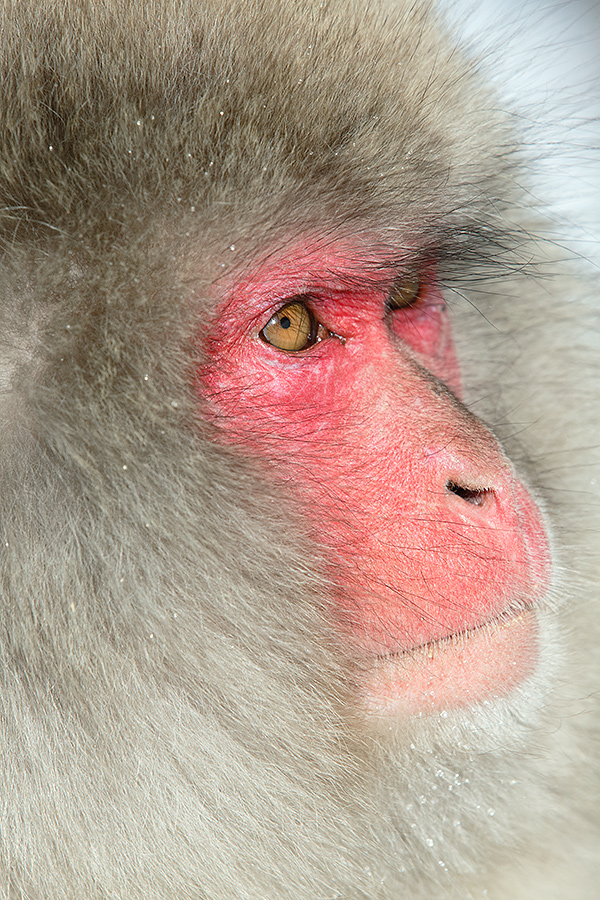
|
|
This image was created on the same day of the Japan in Winter IPT with the Canon EF 70-200mm f/2.8L IS II USM lens, the Canon Extender EF 1.4X III (hand held at 265mm), and the Canon EOS 5D Mark III DSLR. ISO 400. Evaluative metering +2/3 stop as framed: 1/400 sec. at f/11 in Av mode. Color Temperature: AWB.
One sensor up from the central Sensor/AI Servo-Expand/Rear Focus AF just below the monkey’s right eye active at the moment of exposure. Click here to see the latest version of the Rear Focus Tutorial. Click on the image to see a larger version.
|
|

|
|
Images copyright 2012: Denise Ippolito & Arthur Morris. Card design by Denise Ippolito. Click on the image to enjoy a spectacular larger version.
|
Holland 2014 7 1/2-Day/8-Night: A Creative Adventure/BIRDS AS ART/Tulips & A Touch of Holland IPT. April 17-April 24, 2014: $4995 Limit: 12/Openings: 5
We still have room for 5 more flower photographers on this great trip.
Join Denise Ippolito, Flower Queen and the author of “Bloomin’ Ideas,” and Arthur Morris, Canon Explorer of Light Emeritus and one of the planet’s premier photographic educators for a great trip to Holland in mid-April 2014. Day 1 of the IPT will be April 17, 2014. We will have a short afternoon get-together and then our first photographic session at the justly-famed Keukenhof. Most days we will return to the hotel for lunch, image sharing and a break. On Day 8, April 24, we will enjoy both morning and afternoon photography sessions.
The primary subjects will be tulips and orchids at Keukenhof and the spectacularly amazing tulip, hyacinth, and daffodil bulb fields around Lisse. In addition we will spend one full day in Amsterdam. There will be optional visits the Van Gogh Museum in the morning and the Anne Frank House in the afternoon; there will be plenty of time for street photography as well. And some great food. On another day we will have a wonderful early dinner at Kinderdijk and then head out with our gear to photograph the windmills and possibly some birds for those who bring their longs lenses. We will spend an afternoon in the lovely Dutch town of Edam where we will do some street photography and enjoy a superb dinner. All lodging, ground transportation, entry fees, and meals (from dinner on Day 1 through dinner on Day 7) are included. For those who will be bringing a big lens we will likely have an optional bird photography afternoon or two.
Click here for additional info or to register.

|
|
Join me for the 2014 Tanzania Summer Safari!
|
2014 Tanzania Summer Safari, 14-day African Adventure/leave the US on August 9. Fly home on August 24: $12,999.
Co-leaders Todd Gustafson & Arthur Morris. The limit is 12. Three photographers/van; you get your own row of seats. Our trip is a bit more expensive than the average safari for good reason. It is the best. We have the best driver guides with a total of decades of experience. They have been trained over the years by Todd and by me to drive with photography in mind. We have the best and most knowledgeable leaders. We stay in the best lodges and camps. We hope that you will join us for what will be Todd’s 35th African safari, and my 8th.
If you are seriously interested please e-mail me; I will be glad to send you the illustrated PDF with the complete itinerary and deposit info.
What else makes this expedition unique?
•Pre-trip consultation and camera equipment advice
•Award-winning photographers as your guides
•A seamless itinerary visiting the right locations at the best time of year
•Hands-on photography instruction in the field
•Specially designed three roof-hatch photo safari vehicles
•Proprietary materials for preparation, including free copy of “A Photographer’s Guide to Photographing in East Africa.”
•Post-safari image critiques
All-inclusive (double-occupancy) except for your flights to and from Kilamajaro Airport, bar drinks, soda & water (except at the Intimate Tented Camp where everything is free for our entire stay), tips for drivers and camp staff, personal items, and trip insurance.

|
|
Breathe deeply, bite the bullet, and live life to its fullest; we all get only one ride on the merry-go-round… Join me on this great trip.
Click on the image to enjoy a larger version.
|
The Southern Ocean…
If you would like to explore the possibility of joining me on the Cheesemans’ Ecology Safaris Antarctica/The Extended Expedition Voyage< trip: Antarctic Peninsula, South Georgia and Falkland Islands: December 13, 2014 to January 10, 2015, click here for additional information and then shoot me an e-mail.
The DPP RAW Conversion Guide
To learn why I use Canon’s Digital Photo Professional (DPP) to convert every image that I work on, click here.
Support the BAA Blog. Support the BAA Bulletins: Shop B&H here!
We want and need to keep providing you with the latest free information, photography and Photoshop lessons, and all manner of related information. Show your appreciation by making your purchases immediately after clicking on any of our B&H or Amazon Affiliate links in this blog post. Remember, B&H ain’t just photography!


 


Amazon
Everyone buys something from Amazon, be it a big lens or deodorant. Support the blog by starting your search by clicking on the logo-link below. No purchase is too small to be appreciated; they all add up. Why make it a habit? Because I make it a habit of bringing you new images and information on an almost daily basis.
Typos
In all blog posts and Bulletins, feel free to e-mail or to leave a comment regarding any typos, wrong words, misspellings, omissions, or grammatical errors. Just be right. 🙂
IPT Info
Many of our great trips are filling up. See especially info on the South Florida, Holland, and Nickerson Beach IPTs. Two great leaders on most trips ensure that you will receive individual attention, have all of your questions answered, and learn a ton including how to think like a pro, see the situation, and get the right exposure every time. In addition you will have fun, and make lots of great images. Click here for IPT details and general information.
March 3rd, 2014 The Streak Continues
As we will be spending much of tomorrow in transit on various buses, taxis, trains, and subways, I prepared this blog post after the dinner described below on Saturday, March 2, 2014. I am trying to prepare another post or two so that the streak is not jeopardized on my big travel day, Tuesday, March 4, 2014 when I fly out of Tokyo’s Narita airport around noon and get into Orlando two hours later on the same day. I should easily be home in time for a swim before having dinner with Jim.
March 3 Update!
Miracle of miracles, on our own, Denise and I made it from our hotel in Kyoto to Kyoto Station and got tickets for and boarded the Express Super Train to Tokyo Station. After 1 1/2 hours wandering around Tokyo Station we got some lunch and made our way to the platform for the Narita (say NAH-ree-TAH) Express only to find out that I needed to leave Denise with all the bags, head back up two huge elevators, find the ticket office, and find Denise. We boarded the 3:05 train and arrived at the Terminal 1 Narita Airport Station before 4pm. It was much easier getting around Narita Station than getting around the huge complex that is Tokyo Station. Having just missed the shuttle bus the kindly old taxi dispatcher called us a larger cab because our huge collection of bags could not fit in a normal taxi. By 5pm we were in our hotel room getting ready for our flight home tomorrow.
This post marks 94 straight days with a new blog post, a record by far that should be extended for at least another day or so, or not. Or more…. To show your appreciation for my efforts here, we ask that use our B&H and Amazon affiliate links for all of your B&H and Amazon purchases. Please check the availability of all photographic accessories in the BIRDS AS ART Online Store. We sell only what I use and depend on. We will not sell you junk. We know what you need to make creating great images easy and fun. And we are always glad to answer your gear questions via e-mail.
You can find the following items in the store: Gitzo tripods, Mongoose M3.6 and Wimberley heads, plates, low feet, and accessories, flash brackets, , Delkin e-film Pro Compact Flash Cards, LensCoat products, and our unique line-up of educational materials including ABP I & II, Digital Basics, Site and Set-up e-Guides, Canon and Nikon Camera Users and AF e-Guides, and MP-4 Photoshop video tutorials among others.
We would of course appreciate you using our B&H and Amazon affiliate links for all of your B&H and Amazon major gear, video, electronic, household, and personal purchases. For the photographic stuff mentioned in the paragraph above we would of course greatly appreciate your business. Here is a huge thank you to the many who have been using our links on a regular basis and visiting the BAA Online store as well.
Thanks a Huge Stack!
Thanks a stack to all who visit the blog regularly. February was a record month for the BAA B&H affiliate program. And dozens of folks are getting in the habit of using Amazon for both the minor household and entertainment purchases as well as for major purchases. Their kindness is greatly appreciated and it is great to see that the streak is paying dividends. Love you all. artie
The Creative MiniMag
The March Edition of Denise Ippolito’s Creative MiniMag is online and can be viewed here. How Denise ever managed to get it published with our rigorous schedule here in Japan is beyond me. All will enjoy Denise’s Bamboo Blur article and the great images in Nancy Bell’s More Fun Than a Barrel of Monkeys here. The monkeys are Bonnett Macaques from southern India. All will benefit by reading Dennis Bishop’s Color Harmony. I need to go back and study it when I have more time. There are additional fine pieces by Mary Stamper, Andrew McLachlan, Steve Ellis, and yours truly: Geese, Cranes, and Creativity at Bosque del Apache.
Bird Photographer’s.Net
If you have never visited Bird Photographer’s.Net, or if it has been a while since you dropped by, click here and you will be impressed with the new look of the front page. Peter Kes did a fabulous job with the re-design. BPN (honest critiques done gently) is a great place to improve your skills as a nature photographer — and, it ain’t just birds: next to the Avian forum, Wildlife, Landscapes, Macro and Flora and Out-of-the-Box are very popular forums. Do also check out the Eager-To-Learn forum, where wintered photographers will help you improve your photography skills. Click here to check out the various topic forums and find those that would be ideal for you. We will be featuring links to some great images and articles of interest in future blog posts. If you just visit the frontpage regularly, you will see the ‘Image of the week’ displayed on the left. One (best) image is selected each week out of each of the critique forums. On the right you will find a selection of threads that drew our attention in some way: a striking image or an interesting topic.
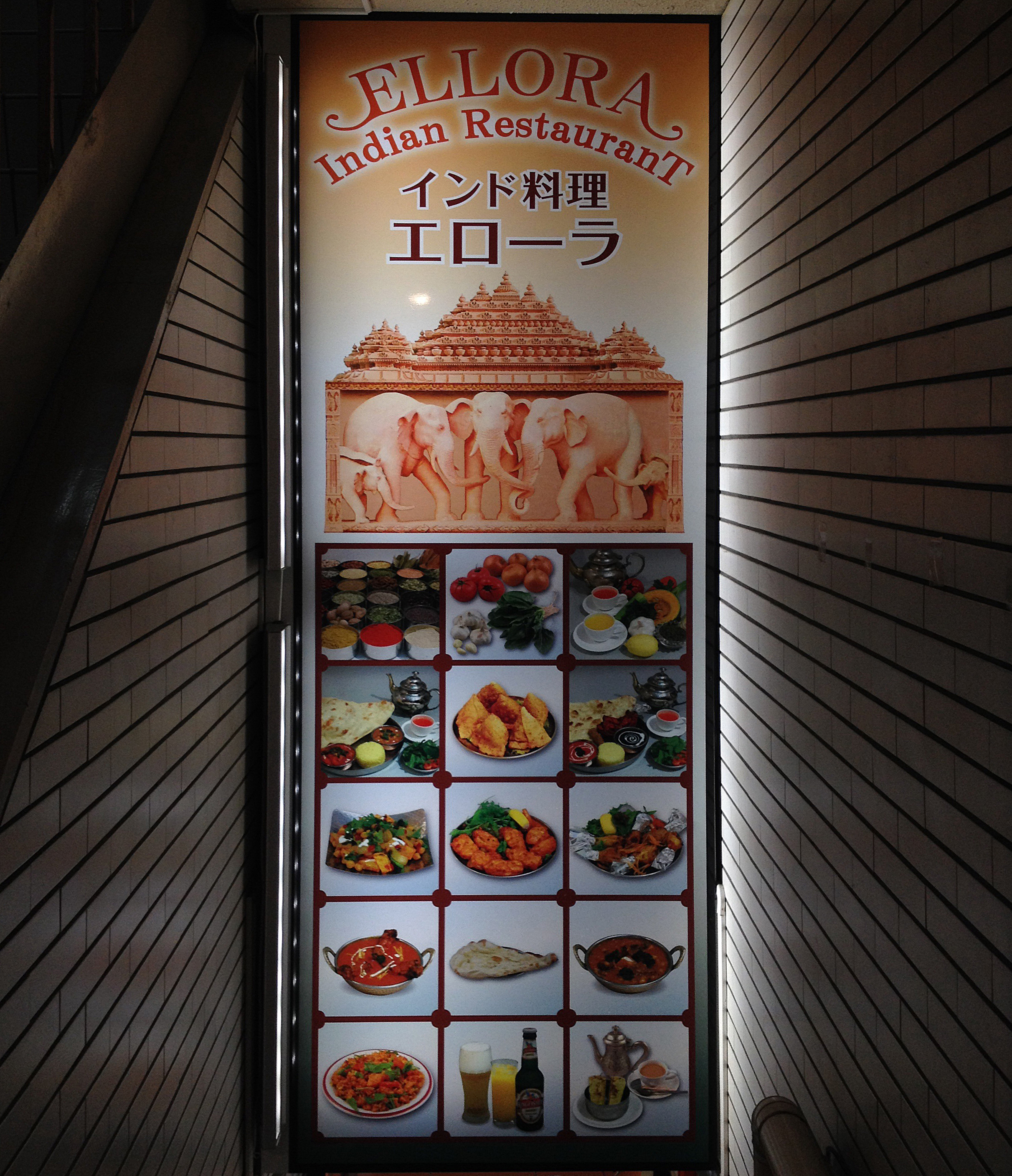
|
|
Ellora Indian Restaurant, Kyoto, Japan. Cell phone image courtesy of and copyright 2014: Patricia Lillich
|
Go Figure…
We enjoyed the food at our lodge in Hokkaido tremendously. Our guide’s wife, Shinobu, was a tremendous cook. She prepared a great variety of Japanese dishes for us each night for dinner. There was always fish or shrimp for Denise and lots of protein for me. We all relished the food. Dining out in Rausu was a bit challenging but we did fine. In our hotel near the Monkey Park in Jigokudani, Nagano we were served a sumptuous Japanese-style dinner each evening with many, many courses to choose from.
Once we got to Kyoto, however, things were a bit different. We found dining out to be a struggle. Especially at dinner. We found a variety of great looking restaurants on our cultural walks. When we tried to enter pretty much each of them we were told, “No reservation, no room.” When we’d finally find a place with real tables and chairs–the Japanese often eat at very low tables while seated on the floor, we found it difficult to get the menus translated and found much of the food to be lacking. Not too great either on the portion size or the taste. Denise suffered the most often choosing a seafood dish that seemed just right for her that would turn out to be borderline inedible.
On our last evening in Kyoto we decided to eat at the Italian Restaurant next to our hotel only to learn that it was closed for a wedding. After much debate the five of us–Pat and Alan Lillich and their younger daughter Meagan, we decided to try the Indian restaurant on the Teramachi Mall: the Ellora Indian Restaurant, 548-5 B1F Nakanocho, Shijoagaur, Terimachidori, Nakogyo,-KU, Kyoto. Denise was a bit iffy on the choice….
We started off by sharing an order of vegetable samosas that Denise had ordered. They are fried pastries with a savory filling, in this case potatoes and peas plus tons of great Indian spices. Everyone was blown away by the taste. I had a mutton meatball appetizer that was so good that I shared it with no one. Dish after dish came out of the kitchen: saffron chicken masala, malai kabobs, palak paneer (a spicy creamed spinach), chicken masala kabobs, and vegetable curry and Tandoori prawns for Denise. The Liliichs got two orders of garlic naan, a tender moist Indian bread. Each piece was giant so we all volunteered to help make it disappear. It was a very quiet meal….
Who’da thunk that you could find great Indian food in Kyoto, Japan?
Our saving grace after each meal including our last one in Kyoto, was a visit to Handelsvagen, a killer ice cream shop with lots of way- out flavors. Denise had Macadamia Caramel Coconut every night. I started with Maple Syrup Nut on the first two nights, strawberry on the third, and Sea Salt on the last two. Please do not ask me what a well-controlled diabetic is doing eating ice cream every night. All that I can say is that I cannot wait to get home, to get back in the pool, and back to eating healthy, balanced, low carb meals. Soon.
If…
If you’ve ever had a great ethnic meal in a totally unexpected location, please feel free to share your story with us by leaving a comment below.
|

|
|
If you’d like to learn from the two folks who created the images in the composite above do consider one of the trips below. Denise Ippolito’s images: Japanese leaf painting, skimmer in flight, curved Keukenhof paths with tulips, copulating terns, & pink dahlia. Artie’s images: Snow Geese snowstorm blur, crane landing silhouettes, Leopard with prey in tree, King Penguin, & vertical tulip.
|
A Creative Adventure/BIRDS AS ART Instructional Photo-Tours (IPTs)/Two great leaders: Arthur Morris & Denise Ippolito.
Arthur Morris/BIRDS AS ART www.BIRDSASART-blog.com for the latest images, info, & education
Denise Ippolito/A Creative Adventure www.deniseippolito.com: get yourself out of the box!
Denise’s e-books: Bloomin’ Ideas, A Guide to Filters & Effects, The Softer Side of Macro, & more. Free Monthly Creative MiniMag: www.deniseippolito.com/magazine
Nickerson Baby Beach-nesting Birds IPT, Long Island, NY: 3-Full Days/July 22-24, 2014: $1199.
Black Skimmers, Common Terns with chicks, American Oystercatcher & Piping Plover families; breeding behaviors including courtship feeding, display flight and combat, and copulations. Gulls and shorebirds.
UK Puffins IPT. Early July, 2014.
Details TBA. Please e-mail to be placed on the interested list.
Tanzania Serengeti Summer Safari: Leave US: August 9—return: August 24, 2014: $12,999.
Co-leaders: Arthur Morris & Todd Gustafson. Wildebeest/The Great Migration, cats, elephant, giraffe, zebra, birds & more. Please e-mail for brochure.
Swan Island Dahlia Farm IPT, Canby, OR, September 8-12, 2014: 5 FULL DAYS: $1699.
Leader: Denise Ippolito. 40 acres with 350+dazzling varieties of dahlias in a plethora of colors, shapes and sizes. Sharpen your technical skills and boost your creative juices. Daily assignments, image sharing, and Photoshop sessions.
Bosque del Apache 2014 A Creative Adventure/BIRDS AS ART “Creative Photography Instructional Photo-Tour.” (IPT). NOV 24-25, 2014. 2-FULL DAYS: $729.
Leaders: Denise Ippolito & Arthur Morris. Introductory Slide program: 7:00pm on Sunday 11/23. This IPT is perfect for folks who want to learn to think outside the box, to create new and different images. Learn to unleash your creative juices at the wondrous Bosque del Apache, NWR in San Antonio, NM.
Bosque del Apache 2014 BIRDS AS ART/A Creative Adventure Instructional Photo-Tour (IPT). NOV 29-DEC 3, 2014. Totaling 4 FULL-DAYS: $1449
Leaders: Arthur Morris and Denise Ippolito. Introductory Slide program: 7:00pm on Sunday 11/29. Tens of thousand of Snow Geese, 10,000 Sandhill Cranes, ducks, amazing sunrises, sunsets, and blast-offs. Live, eat, and breathe photography with two of the world’s premier photographic educators at one of their very favorite photography locations on the planet.
Antarctica/The Extended Expedition Voyage: Antarctic Peninsula, South Georgia and Falkland Islands: December 13, 2014 to January 10, 2015.
Please e-mail for details.
BAA offers a wide range of books, e-Guides, and educational materials and photographic accessories at the lowest prices around—25+ years of experience, and the best advice you can get. We will not sell you junk. Access the BAA Store here or call us at 1-863-692-0906.
Questions? Please e-mail us at birdsasart@verizon.net or photographybydenise221@gmail.com.
Support the BAA Blog. Support the BAA Bulletins: Shop B&H here!
We want and need to keep providing you with the latest free information, photography and Photoshop lessons, and all manner of related information. Show your appreciation by making your purchases immediately after clicking on any of our B&H or Amazon Affiliate links in this blog post. Remember, B&H ain’t just photography!


 


Amazon
Everyone buys something from Amazon, be it a big lens or deodorant. Support the blog by starting your search by clicking on the logo-link below. No purchase is too small to be appreciated; they all add up. Why make it a habit? Because I make it a habit of bringing you new images and information on an almost daily basis.
Typos
In all blog posts and Bulletins, feel free to e-mail or to leave a comment regarding any typos, wrong words, misspellings, omissions, or grammatical errors. Just be right. 🙂
IPT Info
Many of our great trips are filling up. See especially info on the Holland, Nickerson Beach, and Bosque IPTs. Two great leaders on most trips ensure that you will receive individual attention, have all of your questions answered, and learn a ton including how to think like a pro, see the situation, and get the right exposure every time. In addition you will have fun, and make lots of great images. Click here for IPT details and general information.
March 2nd, 2014 The Streak Continues
Today was a relaxing final one in Kyoto. We strolled the Nishiki Market before lunch–heck, we wound up skipping lunch–absorbing a final dose of Japanese culture. I am finishing up this post–it took about 6 hours in all with the image processing–at about 6:00pm Japan time on Saturday, March 2, 2014. That is 4:00am on the same day in Florida and in New York. Tomorrow Denise and I take the high speed train to Tokyo Station, the Narita Express to the Airport, and a shuttle bus to the hotel where we overnight for our Tuesday flights to our respective homes.
This post marks 93 straight days with a new blog post, a record by far that should be extended for at least another day or so, or not. Or more…. To show your appreciation for my efforts here, we ask that use our B&H and Amazon affiliate links for all of your B&H and Amazon purchases. Please check the availability of all photographic accessories in the BIRDS AS ART Online Store. We sell only what I use and depend on. We will not sell you junk. We know what you need to make creating great images easy and fun. And we are always glad to answer your gear questions via e-mail.
You can find the following items in the store: Gitzo tripods, Mongoose M3.6 and Wimberley heads, plates, low feet, and accessories, flash brackets, , Delkin e-film Pro Compact Flash Cards, LensCoat products, and our unique line-up of educational materials including ABP I & II, Digital Basics, Site and Set-up e-Guides, Canon and Nikon Camera Users and AF e-Guides, and MP-4 Photoshop video tutorials among others.
We would of course appreciate you using our B&H and Amazon affiliate links for all of your B&H and Amazon major gear, video, electronic, household, and personal purchases. For the photographic stuff mentioned in the paragraph above we would of course greatly appreciate your business. Here is a huge thank you to the many who have been using our links on a regular basis and visiting the BAA Online store as well.
Thanks a Huge Stack!
Thanks a stack to all who visit the blog regularly. February was a record month for the BAA B&H affiliate program. And dozens of folks are getting in the habit of using Amazon for both the minor household and entertainment purchases as well as for major purchases. Their kindness is greatly appreciated and it is great to see that the streak is paying dividends. Love you all. artie
The BIRDS AS ART 2nd International Bird Photography Competition
Thanks a stack to the many who entered. We have a ton of great images to get through. Judging should begin on or about March 10th. The process will be a lengthy one; we appreciate your patience.
Bamboo-zled
Denise and I and several of those who continued on to Kyoto with us spent our first three mornings at one of two bamboo forests. We were led to the traditional bamboo forest by Paul McKenzie who had photographed there before. We found the smaller tract of bamboo on the hillside above the Fushimi Inari Taisha Shrine on our own. The first two mornings Denise photographed exclusively with her trusty Canon EF 24-105mm f/4L IS USM .ens. I went with the tripod-mounted Canon EF 70-200mm f/2.8L IS II USM lens and the hand held Canon EF 24-70mm f/2.8L II USM lens. We used the same gear to photograph at the shrine; if you missed my images from there you can click on Tunnel Visions. On the last morning Denise brought along the old Canon 15mm fish eye now replaced by the Canon EF 8-15mm f/4L Fisheye USM lens. You can see some of Denise’s tunnel and bamboo images in her killer “Japan–Odds and Ends” blog post here.
I spent the better part of the first morning creating similar images at small apertures. I hated the leaf detail that showed through in the areas where the were no bamboo trunks. I used a variation of a technique taught to me by the aforementioned Denise ippolito: I ran a relatively large (vertical) Motion Blur on its own layer, added a Hide-All Mask, painted away the leaf detail, and lowered the opacity of the layer to about 75% to achieve the desired result that you see above. Thanks Lady D.
Digital Basics
Learn everything that I know about using Photoshop in Digital Basics, an instructional PDF that is sent via e-mail. It includes my complete digital workflow, dozens of great Photoshop tips, the use of Contrast Masks, several different ways of expanding canvas, all of my time-saving Keyboard Shortcuts, Quick Masking, Layer Masking, and NIK Color Efex Pro basics, my killer image clean-up techniques, Digital Eye Doctor, and lots more.
Learn the details of advanced Quick Masking techniques in APTATS I. Mention this blog post and apply a $5 discount with phone orders only. Learn advanced Layer Masking Techniques in APTATS II. Mention this blog post and apply a $5 discount with phone orders only. by the pair, APTATS I and APTATS II and we will be glad to apply at $15 discount with phone orders only.
The DPP RAW Conversion Guide
After seeing the accurate colors that I get from my DPP RAW conversions, Japan in Winter co-leader Paul McKenzie is switching to DPP conversions and Denise Ippolito is considering doing the same. Now that is amazing…. To learn why I use Canon’s Digital Photo Professional (DPP) to convert every image that I work on, click here.
Vertical Pan Blurs
With such strong and beautiful patterns and a variety of colors creating some vertical pan blurs was a great option. We urge folks to create dozens of similar blurs once they see a decent motfi; in most cases, one or two will leap off the monitor and scream, “This is the one!” Please understand that creating pleasing blurs is not luck. Almost all need to be carefully planned and executed and be accurately focused. Learn to create your own pleasing blurs of all types in A Guide to Pleasing Blurs by Denise Ippolito and yours truly.
I added just a small bit of angled vertical motion blur to this image to enhance it.
Wide Apertures the Answer…
After spending the better part of two mornings working at f/22 or so, I finally went to f/4 to blur the background bamboos rather than attempt to make everything sharp. That experiment was a great success and led to the creation of the images above and below.
Long, Slow, Exposures, Small Apertures, and Image Sharpness
To guarantee sharp images with the extremely slow shutter speeds used to create the images here I used a technique that I developed on the Holland Tulip trip last spring: 2-second self-timer with Live View for Mirror Lock. I was aware that I might need to turn off IS but with relatively short focal lengths (as compared to 600 and 840mm) that step was not necessary. It is a great technique that produces sharp images as long as you focus accurately and do not accidentally whack your tripod during the exposure. 🙂
Art Vivid In-Camera HD Tricks
1-You need to frame a bit wider than what you see in the viewfinder as the resulting 61-mb jpegs are cropped about 3-4%.
2-You need to use a lot more plus EC (exposure compensation) when creating Art Vivid HDR images than when creating Natural HDR images.
3-My latest, greatest Art Vivid tip: when working in low light, shade, and heavy cloud resist the urge to work at any White Balance other than AWB. By working in AWB the images will be less YELLOW and less funky than when working at the higher Kelvin temperatues.
Learn how to set your 5D III up for both in-camera HDRs and in-camera Multiple Exposures in my EOS-5D Mark III User’s Guide. Learn everything that I know about this great camera including coverage of its all-new AF system and all the Menu Items and Custom Functions that I use. You will not only learn what to set but will learn why I made my choices as they pertain to nature and wildlife photography.
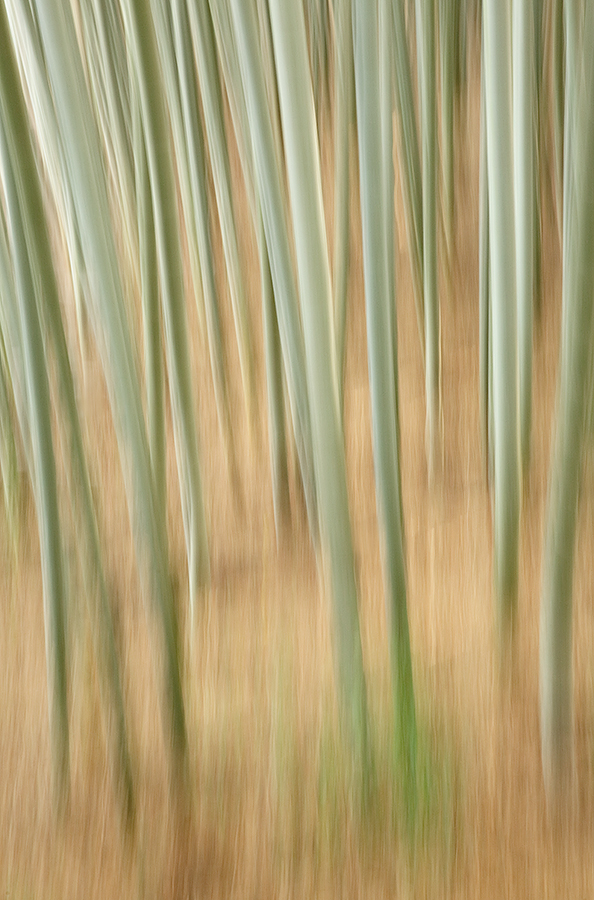
|
|
This vertical pan blur was created the hand held Canon EF 24-70mm f/2.8L II USM lens (at 61mm) and the Canon EOS 5D Mark III DSLR. ISO 800 (should have been a much lower ISO). Evaluative metering +1/3 stop as originally framed: 1/2 sec. at f/14 in Tv mode. Color temperature: 10,000K.
Central Sensor/AI Servo-Surround/Rear Focus AF on the middle of the bamboo in the middle, recompose, and then pan from down to up during the exposure. Click here to see the latest version of the Rear Focus Tutorial. Click on the image to see a larger version.
Image #5: Skewed Vertical Pan Blur
|
The Influence of Perspective Choice
While creating the image above I was standing on a relatively high shelf of land that left me about 15 feet above my subjects, a pleasing stand of bamboo. Having to point my wide angle lens down before zooming up during the slow exposure left the trees on each side of the frame pleasingly skewed outwards. Compare the results here with Image #2 where I was pretty much even with my subjects throughout the range of my panning motion.
|
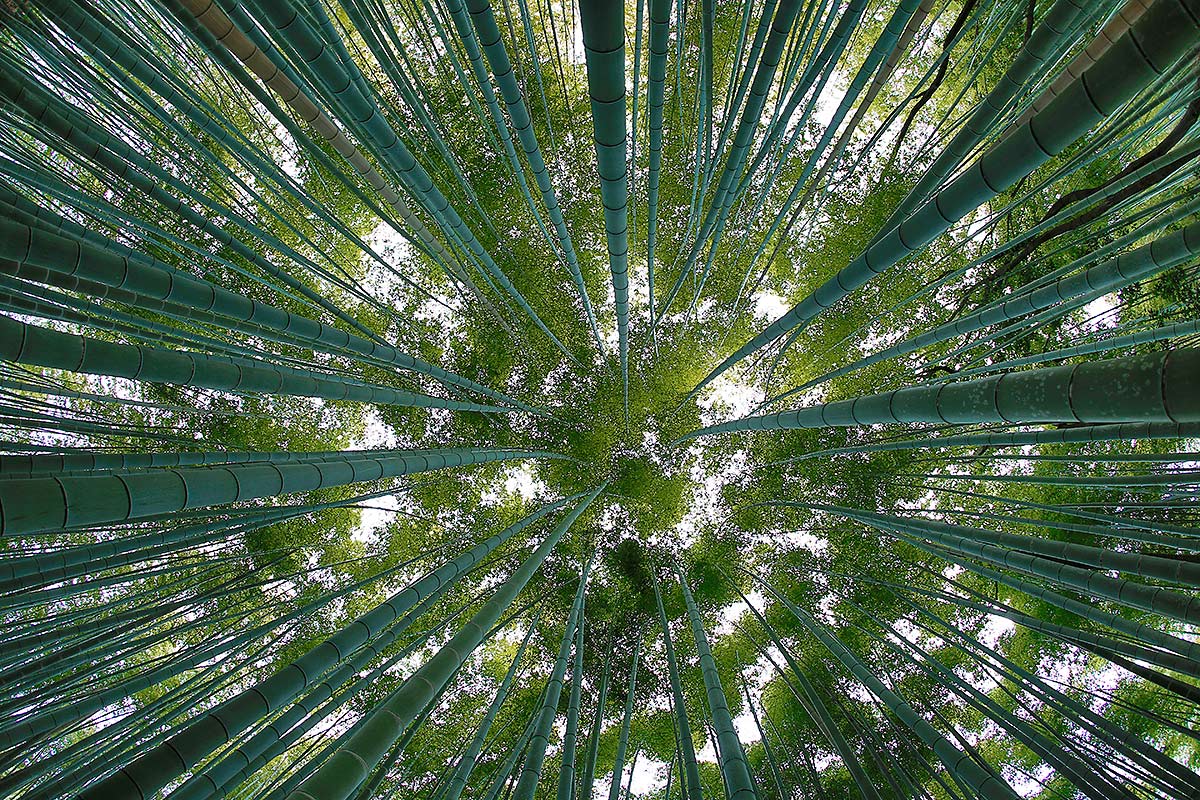
|
|
This in-camera Art VIvid HDR image was created in Kyoto, Japan with the Gitzo 3532 LS carbon fiber tripod, the Mongoose M3.6 head, and my Giottos MH 1302-655 Ballhead with a Wimberley P-5 plate attached to the bottom of my Canon EOS 5D Mark III DSLR. (I keep the Giotto’s tiny ballhead in my vest; it takes less than two minutes to mount the plate on the camera body, spin off the Mongoose M3.6, and replace it with the tiny head.) The lens was the old Canon 15mm fish eye now replaced by the Canon EF 8-15mm f/4L Fisheye USM lens. ISO 400. Evaluative metering +2/3 stop yielded a base exposure of 1/40 sec. at f/5.6 in Av mode (+/- 2 stops). Color temperature: AWB.
I focused one-third of the way up one of the bamboo trunks via contrast off the sensor using Live Mode AF in Live View (with Rear Focus/AI Servo AF).
Image #6: Fish Eye Straight Up
|
The Fish Eye Lens on a Tripod
I had never worked with the fish eye lens on a tripod before while pointing the lens straight up at the sky so I had a bit of finagling to do. I mounted the tiny ballhead, put the P-5 camera body plate on my 5D III, shortened the two two rear legs of the tripod and lengthened the forward-pointing leg a bit, I pulled the stem of the ballhead into the slot for vertical, got down on the ground flat on my back, positioned the tripod directly above me, and adjusted the tripod legs with the leg tabs pulled out so that the round tripod base or platform was relatively square to the world, that is, roughly parallel to the ground. Then I went to work creating images. I am not sure why but the image above was my favorite fish eye shot by a wide margin.
Your Favorite?
Please take a moment and let us know which of the six images above you like the best. Be sure to let us know why you made your choice.
|

|
|
Images copyright 2012: Denise Ippolito & Arthur Morris. Card design by Denise Ippolito. Click on the image to enjoy a spectacular larger version.
|
Holland 2014 7 1/2-Day/8-Night: A Creative Adventure/BIRDS AS ART/Tulips & A Touch of Holland IPT. April 17-April 24, 2014: $4995 Limit: 12/Openings: 5
We still have room for 5 more flower photographers on this great trip.
Join Denise Ippolito, Flower Queen and the author of “Bloomin’ Ideas,” and Arthur Morris, Canon Explorer of Light Emeritus and one of the planet’s premier photographic educators for a great trip to Holland in mid-April 2014. Day 1 of the IPT will be April 17, 2014. We will have a short afternoon get-together and then our first photographic session at the justly-famed Keukenhof. Most days we will return to the hotel for lunch, image sharing and a break. On Day 8, April 24, we will enjoy both morning and afternoon photography sessions.
The primary subjects will be tulips and orchids at Keukenhof and the spectacularly amazing tulip, hyacinth, and daffodil bulb fields around Lisse. In addition we will spend one full day in Amsterdam. There will be optional visits the Van Gogh Museum in the morning and the Anne Frank House in the afternoon; there will be plenty of time for street photography as well. And some great food. On another day we will have a wonderful early dinner at Kinderdijk and then head out with our gear to photograph the windmills and possibly some birds for those who bring their longs lenses. We will spend an afternoon in the lovely Dutch town of Edam where we will do some street photography and enjoy a superb dinner. All lodging, ground transportation, entry fees, and meals (from dinner on Day 1 through dinner on Day 7) are included. For those who will be bringing a big lens we will likely have an optional bird photography afternoon or two.
Click here for additional info or to register.

|
|
Join me for the 2014 Tanzania Summer Safari!
|
2014 Tanzania Summer Safari, 14-day African Adventure/leave the US on August 9. Fly home on August 24: $12,999.
Co-leaders Todd Gustafson & Arthur Morris. The limit is 12. Three photographers/van; you get your own row of seats. Our trip is a bit more expensive than the average safari for good reason. It is the best. We have the best driver guides with a total of decades of experience. They have been trained over the years by Todd and by me to drive with photography in mind. We have the best and most knowledgeable leaders. We stay in the best lodges and camps. We hope that you will join us for what will be Todd’s 35th African safari, and my 8th.
If you are seriously interested please e-mail me; I will be glad to send you the illustrated PDF with the complete itinerary and deposit info.
What else makes this expedition unique?
•Pre-trip consultation and camera equipment advice
•Award-winning photographers as your guides
•A seamless itinerary visiting the right locations at the best time of year
•Hands-on photography instruction in the field
•Specially designed three roof-hatch photo safari vehicles
•Proprietary materials for preparation, including free copy of “A Photographer’s Guide to Photographing in East Africa.”
•Post-safari image critiques
All-inclusive (double-occupancy) except for your flights to and from Kilamajaro Airport, bar drinks, soda & water (except at the Intimate Tented Camp where everything is free for our entire stay), tips for drivers and camp staff, personal items, and trip insurance.

|
|
Breathe deeply, bite the bullet, and live life to its fullest; we all get only one ride on the merry-go-round… Join me on this great trip.
Click on the image to enjoy a larger version.
|
The Southern Ocean…
If you would like to explore the possibility of joining me on the Cheesemans’ Ecology Safaris Antarctica/The Extended Expedition Voyage< trip: Antarctic Peninsula, South Georgia and Falkland Islands: December 13, 2014 to January 10, 2015, click here for additional information and then shoot me an e-mail.
The DPP RAW Conversion Guide
To learn why I use Canon’s Digital Photo Professional (DPP) to convert every image that I work on, click here.
Support the BAA Blog. Support the BAA Bulletins: Shop B&H here!
We want and need to keep providing you with the latest free information, photography and Photoshop lessons, and all manner of related information. Show your appreciation by making your purchases immediately after clicking on any of our B&H or Amazon Affiliate links in this blog post. Remember, B&H ain’t just photography!


 


Amazon
Everyone buys something from Amazon, be it a big lens or deodorant. Support the blog by starting your search by clicking on the logo-link below. No purchase is too small to be appreciated; they all add up. Why make it a habit? Because I make it a habit of bringing you new images and information on an almost daily basis.
Typos
In all blog posts and Bulletins, feel free to e-mail or to leave a comment regarding any typos, wrong words, misspellings, omissions, or grammatical errors. Just be right. 🙂
IPT Info
Many of our great trips are filling up. See especially info on the South Florida, Holland, and Nickerson Beach IPTs. Two great leaders on most trips ensure that you will receive individual attention, have all of your questions answered, and learn a ton including how to think like a pro, see the situation, and get the right exposure every time. In addition you will have fun, and make lots of great images. Click here for IPT details and general information.
March 1st, 2014 The Streak Continues
Things are winding down here in Japan. Five of us again spent the early morning at the at the Bamboo Forest in Kyoto, Japan and then grabbed a cab to Kitano Tenman-gū, a Shinto shrine in Kamigyō-ku, Kyoto, Surprisingly, the plum blossom trees, though not yet in full bloom, were sporting lots of flowers. Paul McKenzie who was with us this morning flies back to Hong Kong tonight from Osaka. And Zorica and Srdjan head home tomorrow. Denise and I head to Tokyo on Monday and catch our flights back to the states on Tuesday (here in Japan). And Alan and Pat head home the following day.
I am finishing up this post at 6:00pm Japan time on Saturday, March 1 (OMG, it’s March already!), 2014. That is 4:00am on the same day in Florida and in New York. If you missed the Jumping Monkeys” blog post the other day, be sure to click here to see the many thoughtful comments on the state of nature photography today.
This post marks 92 straight days with a new educational blog post, a record by far that should be extended for at least another day or so, or not. Or more…. To show your appreciation for my efforts here, we ask that use our B&H and Amazon affiliate links for all of your B&H and Amazon purchases. Please check the availability of all photographic accessories in the BIRDS AS ART Online Store. We sell only what I use and depend on. We will not sell you junk. We know what you need to make creating great images easy and fun. And we are always glad to answer your gear questions via e-mail.
You can find the following items in the store: Gitzo tripods, Mongoose M3.6 and Wimberley heads, plates, low feet, and accessories, flash brackets, , Delkin e-film Pro Compact Flash Cards, LensCoat products, and our unique line-up of educational materials including ABP I & II, Digital Basics, Site and Set-up e-Guides, Canon and Nikon Camera Users and AF e-Guides, and MP-4 Photoshop video tutorials among others.
We would of course appreciate you using our B&H and Amazon affiliate links for all of your B&H and Amazon major gear, video, electronic, household, and personal purchases. For the photographic stuff mentioned in the paragraph above we would of course greatly appreciate your business. Here is a huge thank you to the many who have been using our links on a regular basis and visiting the BAA Online store as well.
Thanks a Huge Stack!
Thanks a stack to all who visit the blog regularly. February was a record month for the BAA B&H affiliate program. And dozens of folks are getting in the habit of using Amazon for both the minor household and entertainment purchases as well as for major purchases. Their kindness is greatly appreciated and it is great to see that the streak is paying dividends. Love you all. artie
The General Premise
The general premise in bird and wildlife photography is that a good look at the eye or the eyes of the subject is pretty much a necessity. This premise always guides me. I have written “When we view an image, we always start by making eye contact.” And I have always advised: “Focus on the eye; get the eye sharp and the heck with the rest.”
Your Call
With the aforementioned general premise in mind, which–after being sure to view both images at the larger size–do you think is the stronger image? Be sure to let us know the reasons for your choice.
|

|
|
If you’d like to learn from the two folks who created the images in the composite above do consider one of the trips below. Denise Ippolito’s images: Japanese leaf painting, skimmer in flight, curved Keukenhof paths with tulips, copulating terns, & pink dahlia. Artie’s images: Snow Geese snowstorm blur, crane landing silhouettes, Leopard with prey in tree, King Penguin, & vertical tulip.
|
A Creative Adventure/BIRDS AS ART Instructional Photo-Tours (IPTs)/Two great leaders: Arthur Morris & Denise Ippolito.
Arthur Morris/BIRDS AS ART www.BIRDSASART-blog.com for the latest images, info, & education
Denise Ippolito/A Creative Adventure www.deniseippolito.com: get yourself out of the box!
Denise’s e-books: Bloomin’ Ideas, A Guide to Filters & Effects, The Softer Side of Macro, & more. Free Monthly Creative MiniMag: www.deniseippolito.com/magazine
Nickerson Baby Beach-nesting Birds IPT, Long Island, NY: 3-Full Days/July 22-24, 2014: $1199.
Black Skimmers, Common Terns with chicks, American Oystercatcher & Piping Plover families; breeding behaviors including courtship feeding, display flight and combat, and copulations. Gulls and shorebirds.
UK Puffins IPT. Early July, 2014.
Details TBA. Please e-mail to be placed on the interested list.
Tanzania Serengeti Summer Safari: Leave US: August 9—return: August 24, 2014: $12,999.
Co-leaders: Arthur Morris & Todd Gustafson. Wildebeest/The Great Migration, cats, elephant, giraffe, zebra, birds & more. Please e-mail for brochure.
Swan Island Dahlia Farm IPT, Canby, OR, September 8-12, 2014: 5 FULL DAYS: $1699.
Leader: Denise Ippolito. 40 acres with 350+dazzling varieties of dahlias in a plethora of colors, shapes and sizes. Sharpen your technical skills and boost your creative juices. Daily assignments, image sharing, and Photoshop sessions.
Bosque del Apache 2014 A Creative Adventure/BIRDS AS ART “Creative Photography Instructional Photo-Tour.” (IPT). NOV 24-25, 2014. 2-FULL DAYS: $729.
Leaders: Denise Ippolito & Arthur Morris. Introductory Slide program: 7:00pm on Sunday 11/23. This IPT is perfect for folks who want to learn to think outside the box, to create new and different images. Learn to unleash your creative juices at the wondrous Bosque del Apache, NWR in San Antonio, NM.
Bosque del Apache 2014 BIRDS AS ART/A Creative Adventure Instructional Photo-Tour (IPT). NOV 29-DEC 3, 2014. Totaling 4 FULL-DAYS: $1449
Leaders: Arthur Morris and Denise Ippolito. Introductory Slide program: 7:00pm on Sunday 11/29. Tens of thousand of Snow Geese, 10,000 Sandhill Cranes, ducks, amazing sunrises, sunsets, and blast-offs. Live, eat, and breathe photography with two of the world’s premier photographic educators at one of their very favorite photography locations on the planet.
Antarctica/The Extended Expedition Voyage: Antarctic Peninsula, South Georgia and Falkland Islands: December 13, 2014 to January 10, 2015.
Please e-mail for details.
BAA offers a wide range of books, e-Guides, and educational materials and photographic accessories at the lowest prices around—25+ years of experience, and the best advice you can get. We will not sell you junk. Access the BAA Store here or call us at 1-863-692-0906.
Questions? Please e-mail us at birdsasart@verizon.net or photographybydenise221@gmail.com.
Support the BAA Blog. Support the BAA Bulletins: Shop B&H here!
We want and need to keep providing you with the latest free information, photography and Photoshop lessons, and all manner of related information. Show your appreciation by making your purchases immediately after clicking on any of our B&H or Amazon Affiliate links in this blog post. Remember, B&H ain’t just photography!


 


Amazon
Everyone buys something from Amazon, be it a big lens or deodorant. Support the blog by starting your search by clicking on the logo-link below. No purchase is too small to be appreciated; they all add up. Why make it a habit? Because I make it a habit of bringing you new images and information on an almost daily basis.
Typos
In all blog posts and Bulletins, feel free to e-mail or to leave a comment regarding any typos, wrong words, misspellings, omissions, or grammatical errors. Just be right. 🙂
IPT Info
Many of our great trips are filling up. See especially info on the Holland, Nickerson Beach, and Bosque IPTs. Two great leaders on most trips ensure that you will receive individual attention, have all of your questions answered, and learn a ton including how to think like a pro, see the situation, and get the right exposure every time. In addition you will have fun, and make lots of great images. Click here for IPT details and general information.
February 28th, 2014 The Streak Continues
Five of us spent a great morning at the Bamboo Forest in Kyoto, Japan testing our creative abilities. I will be sharing some of my images soon. I am finishing up this post at 6:00pm Japan time on Friday, February 28, 2014. That is 4:00am on the same day in Florida and in New York. If you missed the Jumping Monkeys” blog post the other day, be sure to click here to see the many thoughtful comments on the state of nature photography today.
This post marks 91 straight days with a new blog post, a record by far that should be extended for at least another day or so, or not. Or more…. To show your appreciation for my efforts here, we ask that use our B&H and Amazon affiliate links for all of your B&H and Amazon purchases. Please check the availability of all photographic accessories in the BIRDS AS ART Online Store. We sell only what I use and depend on. We will not sell you junk. We know what you need to make creating great images easy and fun. And we are always glad to answer your gear questions via e-mail.
You can find the following items in the store: Gitzo tripods, Mongoose M3.6 and Wimberley heads, plates, low feet, and accessories, flash brackets, , Delkin e-film Pro Compact Flash Cards, LensCoat products, and our unique line-up of educational materials including ABP I & II, Digital Basics, Site and Set-up e-Guides, Canon and Nikon Camera Users and AF e-Guides, and MP-4 Photoshop video tutorials among others.
We would of course appreciate you using our B&H and Amazon affiliate links for all of your B&H and Amazon major gear, video, electronic, household, and personal purchases. For the photographic stuff mentioned in the paragraph above we would of course greatly appreciate your business. Here is a huge thank you to the many who have been using our links on a regular basis and visiting the BAA Online store as well.

|
|
See my pal Todd Gustafson on Nat Geo Wild on TV this Friday evening. See the details below.
|
Todd Gustafson on Nat Geo Wild
See Todd on Nat Geo TV this Friday at 9pm Eastern (8pm Central); he’ll be featured as an on-screen and in-the-field expert on National Geographic Television for the second time in Nat Geo Wild’s “World’s Weirdest: Animal Apocalypse.” The show airs on February 28th. The episode will have footage of Todd in the field and natural history action footage and stills from the Gustafson Photo Safari archives. International documentary maker Ross Zuchowski did the interview footage with Todd where they talk about the Great Migration and the Mara River Crossings. It will be an informative and entertaining segment so be sure not to miss it or to set your VCRs or Tivos.
I am co-leading the 2014 Tanzania Summer Safari with Todd. Scroll down to see details on this great expedition.
Tunnel Visions
Yesterday in Japan, on Thursday, February 28, five of us visited the Fushimi Inari Taisha Shrine in Kyoto, Japan with an assortment of lenses and other photo gear. Paul McKenzie briefed us with some expert advice and then we all went to work. The big photographic attractions were the two tunnels constructed of orange poles about 5-6 inches in diameter with a wooden roof made of planks of the same colors. In all, there were more than a zillion good pictures to be made; no worries, we counted.
The Color Work
Getting the color of the image files to match what I thought was correct was a bear. I used everything in my arsenal including Color Temperature adjustments during the RAW conversion in DPP, Selective Color, Hue Saturation, Levels, Color Balance, and various color balancing techniques (including Average Blur Color Balancing) in CS-6.
For the original captures, it was necessary to clip the RED channel fairly significantly in order to prevent the images from being overall too dark. This is a common occurrence when photographing sunrises and sunsets.
Digital Basics
Learn everything that I know about balancing the colors in an image and correcting color casts in my Digital Basics File. Digital Basics is an instructional PDF that is sent via e-mail. It includes my complete digital workflow, dozens of great Photoshop tips, the use of Contrast Masks, several different ways of expanding canvas, all of my time-saving Keyboard Shortcuts, Quick Masking, Layer Masking, and NIK Color Efex Pro basics, my killer image clean-up techniques, Digital Eye Doctor, and lots more.
Learn the details of advanced Quick Masking techniques in APTATS I. Mention this blog post and apply a $5 discount with phone orders only. Learn advanced Layer Masking Techniques in APTATS II. Mention this blog post and apply a $5 discount with phone orders only. by the pair, APTATS I and APTATS II and we will be glad to apply at $15 discount with phone orders only.
The DPP RAW Conversion Guide
After seeing the accurate colors that I get from my DPP RAW conversions, Japan in Winter co-leader Paul McKenzie is switching to DPP conversions and Denise Ippolito is considering doing the same. Now that is amazing…. To learn why I use Canon’s Digital Photo Professional (DPP) to convert every image that I work on, click here.
f/2.8
Note that for the image above I chose the widest available aperture after carefully choosing my perspective and my focal length so that the text on the 2nd piling would pop while the rest would go soft.
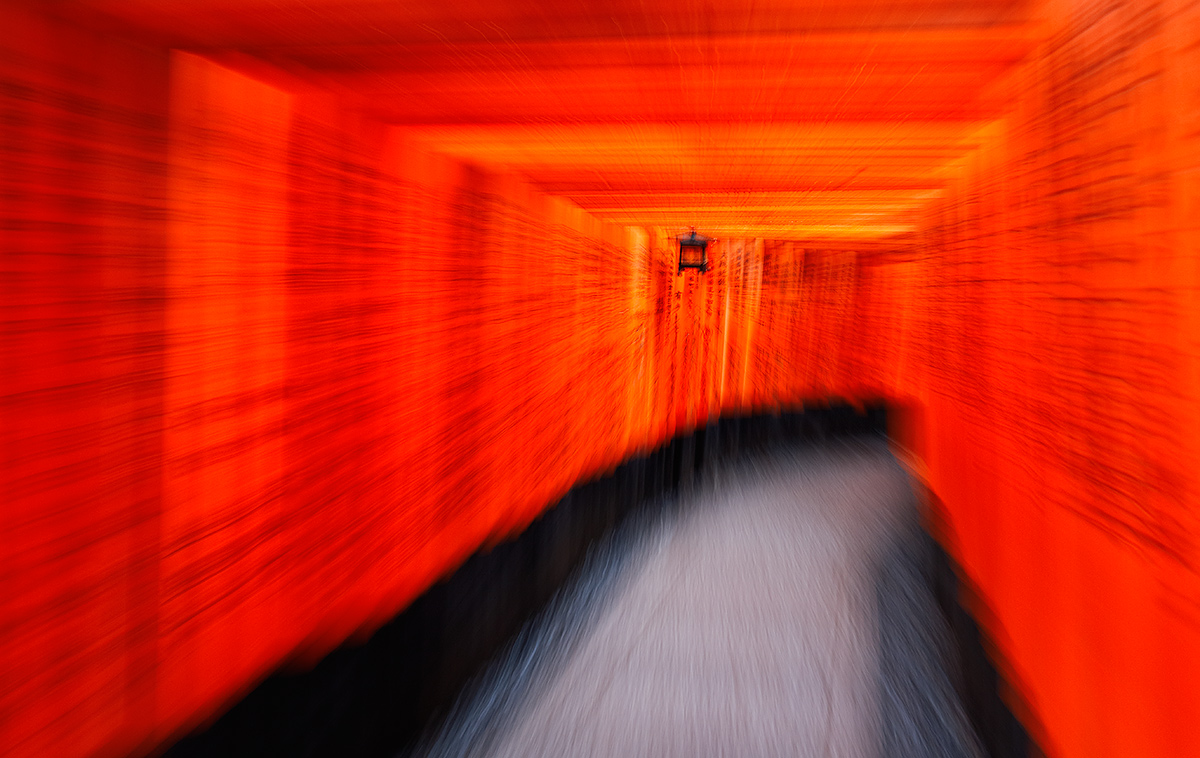
|
|
This zoom blur was created at the Fushimi Inari Taisha Shrine, Kyoto, Japan with the hand held Canon EF 24-70mm f/2.8L II USM Lens and the Canon EOS 5D Mark III DSLR. ISO 400. Evaluative metering +1 stop as originally framed: 1/2 sec. at f/8 in Tv mode. Color temperature: 10,000K.
Central Sensor/AI Servo-Surround/Rear Focus AF on the lantern, recompose, and zoom from tight to wide during the exposure. Click here to see the latest version of the Rear Focus Tutorial. Click on the image to see a larger version.
Image #4
|
Zoom Blurs
I love to create zoom blurs in the field by going to Tv mode, setting the correct EC (Exposure Compensation), choosing a slow shutter speed, usually from 1/5 to 1 full second, and then zooming from long to short. You can create zoom blurs either hand held as this one was or while working on a tripod. I tried a few zoom blurs after seeing some on the back of Denise Ippolito’s EOS-5D Mark III.
Pleasing blurs are not lucky accidents. All need to be accurately focused. Learn to create your own pleasing blurs of all types in A Guide to Pleasing Blurs by Denise Ippolito and yours truly.
The Glow
From the very first image I was captivated by the glow of the light coming through the roof slats. I made many dozens of images; most suffered from a lack of d-o-f….
Long, Slow, Exposures, Small Apertures, and Image Sharpness
To guarantee sharp images with the extremely slow shutter speeds I used a technique that I developed on the Holland Tulip trip: 2-second self-timer with Live View for Mirror Lock. I was aware that I might need to turn off IS but with relatively short focal lengths (as compared to 600 and 840mm) that step was not necessary.
Your Favorite?
Please take a moment and let us know which of the five images above is the best. And do let us know why you made your choice.
|

|
|
Images copyright 2012: Denise Ippolito & Arthur Morris. Card design by Denise Ippolito. Click on the image to enjoy a spectacular larger version.
|
Holland 2014 7 1/2-Day/8-Night: A Creative Adventure/BIRDS AS ART/Tulips & A Touch of Holland IPT. April 17-April 24, 2014: $4995 Limit: 12/Openings: 5
We still have room for 5 more flower photographers on this great trip.
Join Denise Ippolito, Flower Queen and the author of “Bloomin’ Ideas,” and Arthur Morris, Canon Explorer of Light Emeritus and one of the planet’s premier photographic educators for a great trip to Holland in mid-April 2014. Day 1 of the IPT will be April 17, 2014. We will have a short afternoon get-together and then our first photographic session at the justly-famed Keukenhof. Most days we will return to the hotel for lunch, image sharing and a break. On Day 8, April 24, we will enjoy both morning and afternoon photography sessions.
The primary subjects will be tulips and orchids at Keukenhof and the spectacularly amazing tulip, hyacinth, and daffodil bulb fields around Lisse. In addition we will spend one full day in Amsterdam. There will be optional visits the Van Gogh Museum in the morning and the Anne Frank House in the afternoon; there will be plenty of time for street photography as well. And some great food. On another day we will have a wonderful early dinner at Kinderdijk and then head out with our gear to photograph the windmills and possibly some birds for those who bring their longs lenses. We will spend an afternoon in the lovely Dutch town of Edam where we will do some street photography and enjoy a superb dinner. All lodging, ground transportation, entry fees, and meals (from dinner on Day 1 through dinner on Day 7) are included. For those who will be bringing a big lens we will likely have an optional bird photography afternoon or two.
Click here for additional info or to register.

|
|
Join me for the 2014 Tanzania Summer Safari!
|
2014 Tanzania Summer Safari, 14-day African Adventure/leave the US on August 9. Fly home on August 24: $12,999.
Co-leaders Todd Gustafson & Arthur Morris. The limit is 12. Three photographers/van; you get your own row of seats. Our trip is a bit more expensive than the average safari for good reason. It is the best. We have the best driver guides with a total of decades of experience. They have been trained over the years by Todd and by me to drive with photography in mind. We have the best and most knowledgeable leaders. We stay in the best lodges and camps. We hope that you will join us for what will be Todd’s 35th African safari, and my 8th.
If you are seriously interested please e-mail me; I will be glad to send you the illustrated PDF with the complete itinerary and deposit info.
What else makes this expedition unique?
•Pre-trip consultation and camera equipment advice
•Award-winning photographers as your guides
•A seamless itinerary visiting the right locations at the best time of year
•Hands-on photography instruction in the field
•Specially designed three roof-hatch photo safari vehicles
•Proprietary materials for preparation, including free copy of “A Photographer’s Guide to Photographing in East Africa.”
•Post-safari image critiques
All-inclusive (double-occupancy) except for your flights to and from Kilamajaro Airport, bar drinks, soda & water (except at the Intimate Tented Camp where everything is free for our entire stay), tips for drivers and camp staff, personal items, and trip insurance.

|
|
Breathe deeply, bite the bullet, and live life to its fullest; we all get only one ride on the merry-go-round… Join me on this great trip.
Click on the image to enjoy a larger version.
|
The Southern Ocean…
If you would like to explore the possibility of joining me on the Cheesemans’ Ecology Safaris Antarctica/The Extended Expedition Voyage< trip: Antarctic Peninsula, South Georgia and Falkland Islands: December 13, 2014 to January 10, 2015, click here for additional information and then shoot me an e-mail.
The DPP RAW Conversion Guide
To learn why I use Canon’s Digital Photo Professional (DPP) to convert every image that I work on, click here.
Support the BAA Blog. Support the BAA Bulletins: Shop B&H here!
We want and need to keep providing you with the latest free information, photography and Photoshop lessons, and all manner of related information. Show your appreciation by making your purchases immediately after clicking on any of our B&H or Amazon Affiliate links in this blog post. Remember, B&H ain’t just photography!


 


Amazon
Everyone buys something from Amazon, be it a big lens or deodorant. Support the blog by starting your search by clicking on the logo-link below. No purchase is too small to be appreciated; they all add up. Why make it a habit? Because I make it a habit of bringing you new images and information on an almost daily basis.
Typos
In all blog posts and Bulletins, feel free to e-mail or to leave a comment regarding any typos, wrong words, misspellings, omissions, or grammatical errors. Just be right. 🙂
IPT Info
Many of our great trips are filling up. See especially info on the South Florida, Holland, and Nickerson Beach IPTs. Two great leaders on most trips ensure that you will receive individual attention, have all of your questions answered, and learn a ton including how to think like a pro, see the situation, and get the right exposure every time. In addition you will have fun, and make lots of great images. Click here for IPT details and general information.
February 27th, 2014 The Streak Continues
Five of us spent a great morning at the Fushimi Inari Taisha Shrine in Kyoto, Japan photographing the patterns of the orange posts in the tunnels. I will be sharing some of those images soon. Tomorrow we head for the bamboo forest. I began working on this post at 5:00pm Japan time on Thursday, February 27, 2014. That is 3:00am on the same day in Florida or in New York.
If you missed yesterday’s blog post, be sure to click here to see the many thoughtful comments on the state of nature photography today.
This post marks 90 straight days with a new blog post, a record by far that should be extended for at least another day or so, or not. Or more…. To show your appreciation for my efforts here, we ask that use our B&H and Amazon affiliate links for all of your B&H and Amazon purchases. Please check the availability of all photographic accessories in the BIRDS AS ART Online Store. We sell only what I use and depend on. We will not sell you junk. We know what you need to make creating great images easy and fun. And we are always glad to answer your gear questions via e-mail.
You can find the following items in the store: Gitzo tripods, Mongoose M3.6 and Wimberley heads, plates, low feet, and accessories, flash brackets, , Delkin e-film Pro Compact Flash Cards, LensCoat products, and our unique line-up of educational materials including ABP I & II, Digital Basics, Site and Set-up e-Guides, Canon and Nikon Camera Users and AF e-Guides, and MP-4 Photoshop video tutorials among others.
We would of course appreciate you using our B&H and Amazon affiliate links for all of your B&H and Amazon major gear, video, electronic, household, and personal purchases. For the photographic stuff mentioned in the paragraph above we would of course greatly appreciate your business. Here is a huge thank you to the many who have been using our links on a regular basis and visiting the BAA Online store as well.
A Barrel Full of Monkey Photos
Denise Ippolito’s last blog post featured ten of her very favorite Snow Monkey images. If you click here to see them you will likely be amazed.
The Last of Its Kind?
An e-mail from Ted Cheeseman
Dear Friends,
I said in a previous e-mail that our 2014-2015 Falklands/South Georgia/Antarctic Peninsula voyage may be the last of it’s kind. It is true that some will read this and say we’re crying wolf again, as we were in the habit of believing we would not have gone on this long. But it’s a mighty good question: what is the future of our great Falklands/South Georgia/Antarctica expedition that we’ve been so fortunate to share with so many of you? We will go this December-January, 2014/2015. We will not go in 2015-2016. Beyond that:
(1) The forthcoming ‘Mandatory Polar Code’ will be adopted by the International Maritime Organization – IMO has been working on this for a *long* time, a direct outgrowth of the sinking of the Explorer in 2007, and strengthened by the Costa Concordia sinking in the Mediterranean. We don’t know what it will do but it may remove some ships and may limit how independently we can operate. Potential outcome: less freedom, higher costs.
(2) Cost and time: 26 days on the ship is expensive. You all know how wonderfully full value our expeditions are, and I *love* that you appreciate it. But it’s getting harder for us to fill this voyage. If we successfully fill it this year, we’ll *want* to do our great in-depth expedition in future years. If we don’t sail full, well, it’s kind of a killer to work so hard for years, take on that much risk, and lose money to boot!
(3) Other commitments. I am intending to step away and complete a PHD on Humpback Whales. We’ve been working to build the capacity of Cheesemans’ Ecology Safaris to carry on with the same passion and dedication – to wit Hugh Rose’s magnificently adept job as Expedition Leader this January, but we’re a small company yet. This is just part of the equation, adding to the balance of decisions if the expedition becomes harder and riskier to mount (and let me tell you, signing that ship contract sure does make one think seriously about the future!)
So share the love and join us now!!!
Warm regards to all, Ted

|
|
Breathe deeply, bite the bullet, and live life to its fullest; we all get only one ride on the merry-go-round… Join me on this great trip.
Click on the image to enjoy a larger version.
|
The Southern Ocean…
I’ve been blessed. I’ve made three trips to the Southern Ocean, two extended trips that visited the Falklands, South Georgia, and the Antarctic Peninsula, and one to the Falklands and South Georgia. Each was a truly amazing experience. With three trips under my belt, I have a pretty good idea about how to make great images at each of the iconic landings. And I would love the chance to share my knowledge with you.
And I know from personal experience that if you are a photographer who is going to invest in Southern Ocean voyage that you will want to put your money on Cheesemans’. No other tour company goes so far out of their way to ensure making every possible safe landing. And no other tour company will have you spending more time on land. Here, from the” Way to Go CES! (Cheeseman’s Ecology Safaris)” blog post here, is one of my favorite Cheesemans’ stories:
The landing at Bailey Head, Antarctica, was especially rewarding to me as I had been sitting in a zodiac 100 yards off shore on my 2007 trip when the zodiac in front of mine swamped and the captain of the ship called off the landing…. Early that day it looked as if my weather Karma might not be working. Ted’s “Good morning shipmates” was followed by the news that we would not be able to land at Bailey Head that morning as the swell was too big. The beach there is sloped tremendously and the sea strives to pull the zodiacs back into the ocean before folks have gotten off with their gear. Tom Murphy had said to me several days before, “We will get you on the beach at Bailey Head.” Ted concluded his morning greetings by saying, “We are sending out a scout team to see if landing is possible.”
After breakfast I was thrilled to hear Ted’s voice again on the PA, “We will be landing at 8am.” Afterwards folks noted that it was the calmest landing ever at this amazingly beautiful spot. My good weather Karma (courtesy of late-wife Elaine) had come through one last time. Along with St. Andrews Bay, it was one of my two favorite super-great once-in-a-lifetime days of the trip. And we even got to enjoy three additional hours at Hannah Point, Antarctica before calling it a wrap and heading for the feared Drake Passage. All thanks to Cheesemans’ Ecology Safaris.
Why Sign Up Through BIRDS AS ART?
If you have been thinking and dreaming of finally visiting South Georgia and Antarctica, this is the trip for you. Quit dreaming and act now. Though I will not be an official leader on this trip, those who have traveled with me know that I cannot help but teach. I will make pre-trip gear recommendations. I will hold informal pre-landing briefings. In the same vein, everyone will receive a free copy of our Antarctica Site Guide once they are paid in full (August 15, 2014). I will be available on the ship to review your images,, answer questions, and conduct informal over-the shoulder Photoshop sessions. And best of all everyone who signs up under the auspices of BAA are invited to tag along with me on the landings where I will be glad to offer invaluable in-the-field advice. And the same goes for the ship-board birds in flight and marine mammal photography opportunities.
Do join us. To learn how to be part of the BAA group please e-mail me with the words Antarctica/Extended Expedition BAA Info Please cut and pasted into the Subject line.
The Cheesemans’ Ecology Safaris Antarctica/The Extended Expedition Voyage
Antarctic Peninsula, South Georgia and Falkland Islands: December 13, 2014 to January 10, 2015
From the CES website:
Join us on a voyage of discovery to an awe-inspiring world devoted to nature, wildlife, science, and peace. This expedition will have you completely captivated, from the stunning vistas of Tierra del Fuego to the busy penguin rookeries of the Falklands, from the dramatic landscapes of South Georgia to the ice-covered terrain of the Antarctic. Board the comfortable, safe and newly upgraded Ortelius for an expedition offering an unparalleled 17 landing days in the Southern Ocean. Our voyage includes three days in the Falklands with a huge diversity of species, six days at South Georgia Island, the all but undiscovered rugged land of towering mountains and thriving colonies of penguins, seals, and albatross, one day at the South Orkneys with nesting Snow Petrels, and seven days along the Antarctic Peninsula, the wonderland of ice and inconceivably vibrant polar wildlife. During days at sea, our naturalists on the ship’s bridge and stern share sightings of whales and seabirds, including many of the world’s species of albatross. Maximum time both on shore and Zodiac cruising will be available for photography, wildlife experiences, and exploring the landscapes of the great Southern Ocean. Our priority is assuring the most in-depth wildlife experience in the Antarctic, an experience made possible by our excellent itinerary and committed expedition staff.
I can personally attest to the accuracy of everything above. 🙂
Additional Links
Learn about the global ocean here.
Antarctic Inspiration from Paul Mckenzie here.
Way to Go CES! (Cheeseman’s Ecology Safaris) here.
Or simply type any of the following words or phrases in the little white search box on the top right of this page, hit Search, and follow the links: penguin; Antarctica; South Georgia; Falklands. Have fun.
The Pull is Too Strong…
The pull is too strong. I need to go back. And I am. Do join me for an unparalleled wildlife and scenic photography experience. Please e-mail for additional information.
|

|
|
If you’d like to learn from the two folks who created the images in the composite above do consider one of the trips below. Denise Ippolito’s images: Japanese leaf painting, skimmer in flight, curved Keukenhof paths with tulips, copulating terns, & pink dahlia. Artie’s images: Snow Geese snowstorm blur, crane landing silhouettes, Leopard with prey in tree, King Penguin, & vertical tulip.
|
A Creative Adventure/BIRDS AS ART Instructional Photo-Tours (IPTs)/Two great leaders: Arthur Morris & Denise Ippolito.
Arthur Morris/BIRDS AS ART www.BIRDSASART-blog.com for the latest images, info, & education
Denise Ippolito/A Creative Adventure www.deniseippolito.com: get yourself out of the box!
Denise’s e-books: Bloomin’ Ideas, A Guide to Filters & Effects, The Softer Side of Macro, & more. Free Monthly Creative MiniMag: www.deniseippolito.com/magazine
Nickerson Baby Beach-nesting Birds IPT, Long Island, NY: 3-Full Days/July 22-24, 2014: $1199.
Black Skimmers, Common Terns with chicks, American Oystercatcher & Piping Plover families; breeding behaviors including courtship feeding, display flight and combat, and copulations. Gulls and shorebirds.
UK Puffins IPT. Early July, 2014.
Details TBA. Please e-mail to be placed on the interested list.
Tanzania Serengeti Summer Safari: Leave US: August 9—return: August 24, 2014: $12,999.
Co-leaders: Arthur Morris & Todd Gustafson. Wildebeest/The Great Migration, cats, elephant, giraffe, zebra, birds & more. Please e-mail for brochure.
Swan Island Dahlia Farm IPT, Canby, OR, September 8-12, 2014: 5 FULL DAYS: $1699.
Leader: Denise Ippolito. 40 acres with 350+dazzling varieties of dahlias in a plethora of colors, shapes and sizes. Sharpen your technical skills and boost your creative juices. Daily assignments, image sharing, and Photoshop sessions.
Bosque del Apache 2014 A Creative Adventure/BIRDS AS ART “Creative Photography Instructional Photo-Tour.” (IPT). NOV 24-25, 2014. 2-FULL DAYS: $729.
Leaders: Denise Ippolito & Arthur Morris. Introductory Slide program: 7:00pm on Sunday 11/23. This IPT is perfect for folks who want to learn to think outside the box, to create new and different images. Learn to unleash your creative juices at the wondrous Bosque del Apache, NWR in San Antonio, NM.
Bosque del Apache 2014 BIRDS AS ART/A Creative Adventure Instructional Photo-Tour (IPT). NOV 29-DEC 3, 2014. Totaling 4 FULL-DAYS: $1449
Leaders: Arthur Morris and Denise Ippolito. Introductory Slide program: 7:00pm on Sunday 11/29. Tens of thousand of Snow Geese, 10,000 Sandhill Cranes, ducks, amazing sunrises, sunsets, and blast-offs. Live, eat, and breathe photography with two of the world’s premier photographic educators at one of their very favorite photography locations on the planet.
Antarctica/The Extended Expedition Voyage: Antarctic Peninsula, South Georgia and Falkland Islands: December 13, 2014 to January 10, 2015.
Please e-mail for details.
BAA offers a wide range of books, e-Guides, and educational materials and photographic accessories at the lowest prices around—25+ years of experience, and the best advice you can get. We will not sell you junk. Access the BAA Store here or call us at 1-863-692-0906.
Questions? Please e-mail us at birdsasart@verizon.net or photographybydenise221@gmail.com.
Support the BAA Blog. Support the BAA Bulletins: Shop B&H here!
We want and need to keep providing you with the latest free information, photography and Photoshop lessons, and all manner of related information. Show your appreciation by making your purchases immediately after clicking on any of our B&H or Amazon Affiliate links in this blog post. Remember, B&H ain’t just photography!


 


Amazon
Everyone buys something from Amazon, be it a big lens or deodorant. Support the blog by starting your search by clicking on the logo-link below. No purchase is too small to be appreciated; they all add up. Why make it a habit? Because I make it a habit of bringing you new images and information on an almost daily basis.
Typos
In all blog posts and Bulletins, feel free to e-mail or to leave a comment regarding any typos, wrong words, misspellings, omissions, or grammatical errors. Just be right. 🙂
IPT Info
Many of our great trips are filling up. See especially info on the Holland, Nickerson Beach, and Bosque IPTs. Two great leaders on most trips ensure that you will receive individual attention, have all of your questions answered, and learn a ton including how to think like a pro, see the situation, and get the right exposure every time. In addition you will have fun, and make lots of great images. Click here for IPT details and general information.
February 26th, 2014 The Streak Goes On…
Seven of the IPT leaders and participants (along with Pat and Alan Lillich’s daughter Meagan) are on the train to Kyoto for a few days of travel and nature photography and for the seven of us, some much needed rest. I am finishing this post at 6:45pm Japan time on Wednesday, February 26, 2014. That is 4:45am on the same day in Florida or in New York. We will likely get to the Best Western Kyoto at about 9pm tonight.
This post marks 89 straight days with a new educational blog post, a record by far that should be extended for at least another day or so, or not. Or more…. To show your appreciation for my efforts here, we ask that use our B&H and Amazon affiliate links for all of your B&H and Amazon purchases. Please check the availability of all photographic accessories in the BIRDS AS ART Online Store. We sell only what I use and depend on. We will not sell you junk. We know what you need to make creating great images easy and fun. And we are always glad to answer your gear questions via e-mail.
You can find the following items in the store: Gitzo tripods, Mongoose M3.6 and Wimberley heads, plates, low feet, and accessories, flash brackets, , Delkin e-film Pro Compact Flash Cards, LensCoat products, and our unique line-up of educational materials including ABP I & II, Digital Basics, Site and Set-up e-Guides, Canon and Nikon Camera Users and AF e-Guides, and MP-4 Photoshop video tutorials among others.
We would of course appreciate you using our B&H and Amazon affiliate links for all of your B&H and Amazon major gear, video, electronic, household, and personal purchases. For the photographic stuff mentioned in the paragraph above we would of course greatly appreciate your business. Here is a huge thank you to the many who have been using our links on a regular basis and visiting the BAA Online store as well.
Enjoy.
Jumping Monkeys; There’s More to it Than Meets the Eye…
We pretty much wrapped things up on February 25, with our second full day at the Snow Monkey Park. Both Denise and I enjoyed meeting fellow professionals Ben Cranke and Wim van den Heever of South Africa who were also co-leading a photography safari. They kindly invited our group to join their group for an afternoon jumping monkeys photography session.
After they had their group positioned up front with short lenses we chose our spots. Folks with longer lenses like Zorica, Denise, and me stayed well back while the others took peripheral positions. The regular monkey feeder began his rounds with large numbers of Snow Monkeys following him up the hill. Then he walked down the hill towards us on the other side of the river and continued feeding. The idea was to concentrate the monkeys on the far side of the small stream and then feed them on our side of the stream and have them jump across the rocks. At about 3:40pm the final phase of the operation began while Wim and Ben’s Japanese guide sat on the board that the animals usually use to cross to prevent them from doing so.
Results were sporadic at first. A few monkeys jumped across to the desired spot where a bit of food had been placed. It was difficult to get in tune with the rhythm of the jumping monkeys and framing the images was even more difficult. Then they simply quit for ten minutes. Then along came what looked like the head maintenance guy in his green coveralls. He shooed most of the monkeys to the opposite side of the stream and then began to toss small bits of special food to the perfect spot on our side of the river. The monkeys responded quite well. When he quit tossing the special tidbits, the action slowed to less than a trickle. After ten minutes without a single jump I decided to fold up my tripod and pack my gear. Immediately four monkeys took flight and shutters fired. I headed back to a much worse spot than I had had.
After five more minutes with no action, I decided once again to leave. I walked up to the spot where Ben and Wim were seated and asked each for a business card. Within seconds a stream of about 10 monkeys came jumping across the stream. Totally defeated I stood by with no camera and no lens as everyone fired away nonstop. Talk about bad timing….
I was, however, happy with the image above.
Truth in Nature Photography
Thirty-five years ago when I first began noticing great nature photography images, it was only natural to assume that each and every image was in fact an image that was created in a totally natural situation. Today, those boundaries are tremendously blurred. Songbirds are fed and enticed to perch on branches selected for their character and beauty. In many areas the taped calls of songbirds are often used to attract a variety or species into photographic range. Cabella’s Owls are mounted atop Radio Shack antenna poles to draw in migrating raptors. Herons, egrets, pelicans and eagles are baited with fish. Snowy and Great Grey Owls and other raptors are routinely baited with live pet store mice. Prey items are killed with a shot gun and hung in a tree to attract raptors. In Finland and other locations, carcasses are placed in front of photography blinds to attract bears, Golden Eagles, and other raptors.
And let’s not forget outdoor studio lighting, camera traps, and remote triggers.
Don’t get me wrong; I am simply playing Devil’s Advocate here. Heck, at the Jigokudani Yaenkoen Snow Monkey Park the animals are called in with a whistle, fed several times a day, bathe in a man-made onsen (naturally heated pool), and can even be coaxed into jumping across a small river…
Feel free to let us know your thoughts on the current state of nature photography.
Note: as many of you know, I have used several of the techniques described above to help me make better images. I always make sure to let folks know the situation.
|

|
|
Images copyright 2012: Denise Ippolito & Arthur Morris. Card design by Denise Ippolito. Click on the image to enjoy a spectacular larger version.
|
Holland 2014 7 1/2-Day/8-Night: A Creative Adventure/BIRDS AS ART/Tulips & A Touch of Holland IPT. April 17-April 24, 2014: $4995 Limit: 12/Openings: 5
We still have room for 5 more flower photographers on this great trip.
Join Denise Ippolito, Flower Queen and the author of “Bloomin’ Ideas,” and Arthur Morris, Canon Explorer of Light Emeritus and one of the planet’s premier photographic educators for a great trip to Holland in mid-April 2014. Day 1 of the IPT will be April 17, 2014. We will have a short afternoon get-together and then our first photographic session at the justly-famed Keukenhof. Most days we will return to the hotel for lunch, image sharing and a break. On Day 8, April 24, we will enjoy both morning and afternoon photography sessions.
The primary subjects will be tulips and orchids at Keukenhof and the spectacularly amazing tulip, hyacinth, and daffodil bulb fields around Lisse. In addition we will spend one full day in Amsterdam. There will be optional visits the Van Gogh Museum in the morning and the Anne Frank House in the afternoon; there will be plenty of time for street photography as well. And some great food. On another day we will have a wonderful early dinner at Kinderdijk and then head out with our gear to photograph the windmills and possibly some birds for those who bring their longs lenses. We will spend an afternoon in the lovely Dutch town of Edam where we will do some street photography and enjoy a superb dinner. All lodging, ground transportation, entry fees, and meals (from dinner on Day 1 through dinner on Day 7) are included. For those who will be bringing a big lens we will likely have an optional bird photography afternoon or two.
Click here for additional info or to register.

|
|
Join me for the 2014 Tanzania Summer Safari!
|
2014 Tanzania Summer Safari, 14-day African Adventure/leave the US on August 9. Fly home on August 24: $12,999.
Co-leaders Todd Gustafson & Arthur Morris. The limit is 12. Three photographers/van; you get your own row of seats. Our trip is a bit more expensive than the average safari for good reason. It is the best. We have the best driver guides with a total of decades of experience. They have been trained over the years by Todd and by me to drive with photography in mind. We have the best and most knowledgeable leaders. We stay in the best lodges and camps. We hope that you will join us for what will be Todd’s 35th African safari, and my 8th.
If you are seriously interested please e-mail me; I will be glad to send you the illustrated PDF with the complete itinerary and deposit info.
What else makes this expedition unique?
•Pre-trip consultation and camera equipment advice
•Award-winning photographers as your guides
•A seamless itinerary visiting the right locations at the best time of year
•Hands-on photography instruction in the field
•Specially designed three roof-hatch photo safari vehicles
•Proprietary materials for preparation, including free copy of “A Photographer’s Guide to Photographing in East Africa.”
•Post-safari image critiques
All-inclusive (double-occupancy) except for your flights to and from Kilamajaro Airport, bar drinks, soda & water (except at the Intimate Tented Camp where everything is free for our entire stay), tips for drivers and camp staff, personal items, and trip insurance.

|
|
Breathe deeply, bite the bullet, and live life to its fullest; we all get only one ride on the merry-go-round… Join me on this great trip.
Click on the image to enjoy a larger version.
|
The Southern Ocean…
If you would like to explore the possibility of joining me on the Cheesemans’ Ecology Safaris Antarctica/The Extended Expedition Voyage< trip: Antarctic Peninsula, South Georgia and Falkland Islands: December 13, 2014 to January 10, 2015, click here for additional information and then shoot me an e-mail.
The DPP RAW Conversion Guide
To learn why I use Canon’s Digital Photo Professional (DPP) to convert every image that I work on, click here.
Support the BAA Blog. Support the BAA Bulletins: Shop B&H here!
We want and need to keep providing you with the latest free information, photography and Photoshop lessons, and all manner of related information. Show your appreciation by making your purchases immediately after clicking on any of our B&H or Amazon Affiliate links in this blog post. Remember, B&H ain’t just photography!


 


Amazon
Everyone buys something from Amazon, be it a big lens or deodorant. Support the blog by starting your search by clicking on the logo-link below. No purchase is too small to be appreciated; they all add up. Why make it a habit? Because I make it a habit of bringing you new images and information on an almost daily basis.
Typos
In all blog posts and Bulletins, feel free to e-mail or to leave a comment regarding any typos, wrong words, misspellings, omissions, or grammatical errors. Just be right. 🙂
IPT Info
Many of our great trips are filling up. See especially info on the South Florida, Holland, and Nickerson Beach IPTs. Two great leaders on most trips ensure that you will receive individual attention, have all of your questions answered, and learn a ton including how to think like a pro, see the situation, and get the right exposure every time. In addition you will have fun, and make lots of great images. Click here for IPT details and general information.
February 25th, 2014 The Streak Goes On…
We killed again today at the Snow Monkey Park…. I am finishing this post at 8:45pm Japan time on Monday February 25, 2104. That is 6:45am on the same day in Florida or in New York. I will be asleep well before 9pm :).
This post marks 88 straight days with a new educational blog post, a record by far that should be extended for at least another day or so, or not. Or more…. To show your appreciation for my efforts here, we ask that use our B&H and Amazon affiliate links for all of your B&H and Amazon purchases. Please check the availability of all photographic accessories in the BIRDS AS ART Online Store. We sell only what I use and depend on. We will not sell you junk. We know what you need to make creating great images easy and fun. And we are always glad to answer your gear questions via e-mail.
You can find the following items in the store: Gitzo tripods, Mongoose M3.6 and Wimberley heads, plates, low feet, and accessories, flash brackets, , Delkin e-film Pro Compact Flash Cards, LensCoat products, and our unique line-up of educational materials including ABP I & II, Digital Basics, Site and Set-up e-Guides, Canon and Nikon Camera Users and AF e-Guides, and MP-4 Photoshop video tutorials among others.
We would of course appreciate you using our B&H and Amazon affiliate links for all of your B&H and Amazon major gear, video, electronic, household, and personal purchases. For the photographic stuff mentioned in the paragraph above we would of course greatly appreciate your business. Here is a huge thank you to the many who have been using our links on a regular basis and visiting the BAA Online store as well.
Enjoy.
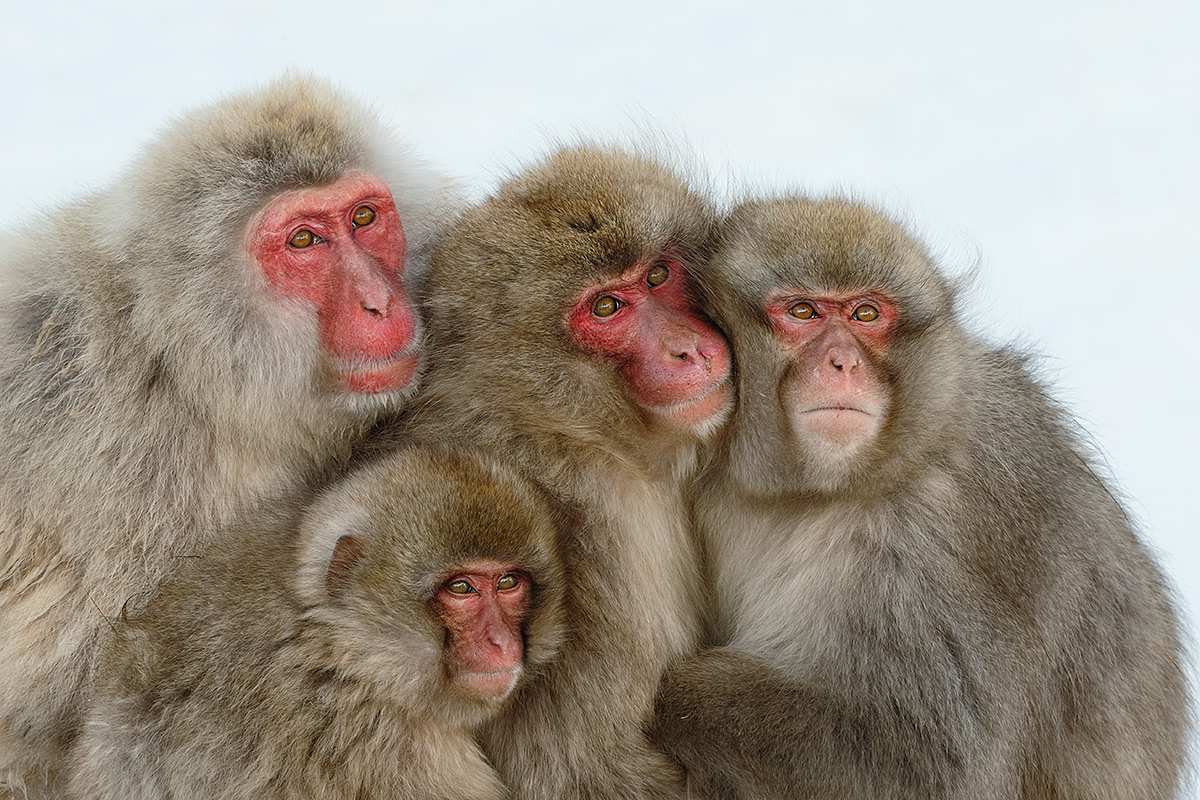
|
|
This image of a Snow Monkey family huddled together was created on the February 25, 2014 at 12:26pm on the Japan in Winter IPT with the tripod-mounted Canon EF 200-400mm f/4L IS USM Lens with Internal 1.4x Extender (with the internal extender in place at 345mm) and the Canon EOS-1D X. ISO 800. Evaluative metering +3 1/3 stops off the snow: 1/125 sec. at f/14 in Manual mode. Color temperature 7,000K.
Central Sensor/AI Servo-Surround/Rear Focus AF on the lowest monkey’s eyes and re-compose. Click here to see the latest version of the Rear Focus Tutorial. Click on the image to see a larger version.
|
One Better?
Two years ago I created the image below. I liked it from the moment I saw it on the back of the camera. It made it to the final round of BBC Wildlife Photographer of the Year Competition judging.
On our first day at the Snow Monkey Park folks were asking, “When do we get that big pile of monkeys?
Just before lunch today there were three monkeys huddled together on the edge of the onsen (hot springs pool). They were facing into the pool. The problem was that there were about 8 photographers behind them piled in tight. So there was no shot from the other side of the pool. The three monkeys posed and posed. The gathered photographers were taking images of their backs with wide angle lenses. The three monkeys posed and posed and posed. Finally I could not take it any longer. I called out, “The shot is from this side of the pool. All that you are getting are the same close-up face images that you have been getting all morning. If you folks would move over here we could all do well.” Nobody listened at first. Then a tall gent from South Africa backed me up. One by one everyone joined us on the side of the pool with the monkeys facing the photographers. But by this time two or three of them were sleeping.
I was patient. I know that the potential for a great image was there. I waited and waited. Some folks gave up and moved on. Then a fourth monkey joined the pile. And they all slept. Then, two monkeys got into a fight on the hill behind us. The four monkeys woke up and posed perfectly. Everyone who stayed wound up thanking me 🙂
Please let me know which image you think is the stronger one, the new image above or the older image below? And to let me know why.
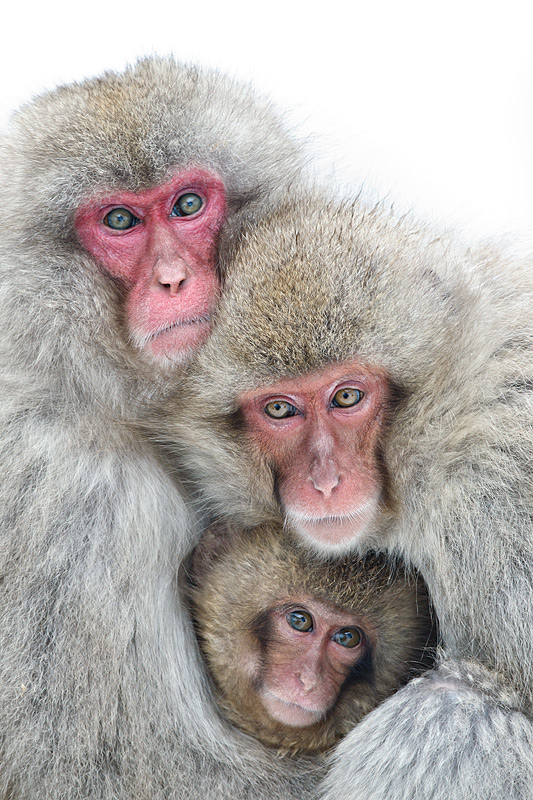
|
|
The original Snow Monkey Family Trio. Click on the image to see a larger version.
|
The DPP RAW Conversion Guide
To learn why I use Canon’s Digital Photo Professional (DPP) to convert every image that I work on, click here.
Support the BAA Blog. Support the BAA Bulletins: Shop B&H here!
We want and need to keep providing you with the latest free information, photography and Photoshop lessons, and all manner of related information. Show your appreciation by making your purchases immediately after clicking on any of our B&H or Amazon Affiliate links in this blog post. Remember, B&H ain’t just photography!


 


Amazon
Everyone buys something from Amazon, be it a big lens or deodorant. Support the blog by starting your search by clicking on the logo-link below. No purchase is too small to be appreciated; they all add up. Why make it a habit? Because I make it a habit of bringing you new images and information on an almost daily basis.
Typos
In all blog posts and Bulletins, feel free to e-mail or to leave a comment regarding any typos, wrong words, misspellings, omissions, or grammatical errors. Just be right. 🙂
IPT Info
Many of our great trips are filling up. See especially info on the South Florida, Holland, and Nickerson Beach IPTs. Two great leaders on most trips ensure that you will receive individual attention, have all of your questions answered, and learn a ton including how to think like a pro, see the situation, and get the right exposure every time. In addition you will have fun, and make lots of great images. Click here for IPT details and general information.
February 24th, 2014 The Streak Goes On…
At the risk of sounding like a broken record we killed today at the Snow Monkey Park…. I am finishing this post at 7:26pm Japan time on Monday February 24, 2104. That is 5:26am on the same day in Florida or in New York. I will be asleep well before 8pm :).
This post marks 87 straight days with a new educational blog post, a record by far that should be extended for at least another day or so, or not. Or more…. To show your appreciation for my efforts here, we ask that use our B&H and Amazon affiliate links for all of your B&H and Amazon purchases. Please check the availability of all photographic accessories in the BIRDS AS ART Online Store. We sell only what I use and depend on. We will not sell you junk. We know what you need to make creating great images easy and fun. And we are always glad to answer your gear questions via e-mail.
You can find the following items in the store: Gitzo tripods, Mongoose M3.6 and Wimberley heads, plates, low feet, and accessories, flash brackets, , Delkin e-film Pro Compact Flash Cards, LensCoat products, and our unique line-up of educational materials including ABP I & II, Digital Basics, Site and Set-up e-Guides, Canon and Nikon Camera Users and AF e-Guides, and MP-4 Photoshop video tutorials among others.
We would of course appreciate you using our B&H and Amazon affiliate links for all of your B&H and Amazon major gear, video, electronic, household, and personal purchases. For the photographic stuff mentioned in the paragraph above we would of course greatly appreciate your business. Here is a huge thank you to the many who have been using our links on a regular basis and visiting the BAA Online store as well.
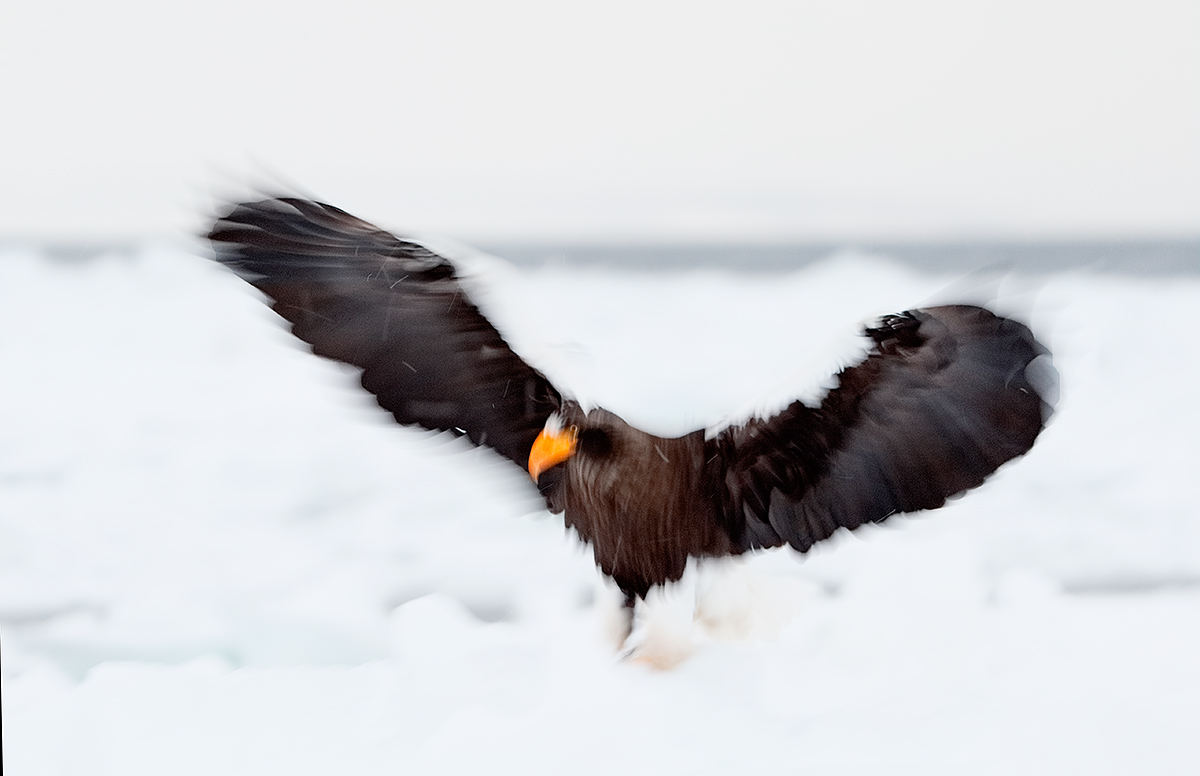
|
|
This Steller’s Sea Eagle blur was created on the morning of February 22, 2014 at 6:04:02am on the Japan in Winter IPT with the Gitzo 3532 LS carbon fiber tripod, the Mongoose M3.6 head, the Canon EF 200-400mm f/4L IS USM Lens with Internal 1.4x Extender (tripod-mounted at 350mm) and the Canon EOS-1D X. ISO Safety Shift yielded ISO 1600. Evaluative metering +2 1/3 stops as framed in Tv mode: 1/30 sec. at f/6.3. Color temperature 10,000K.
Central Sensor/AI Servo-Surround/Rear Focus AF just caught the top of the bird’s head and was active at the moment of exposure. Click here to see the latest version of the Rear Focus Tutorial. Click on the image to see a larger version.
Image #1: Landing Steller’s Sea Eagle Blur
|
Pre-Dawn Blurs in the Dark
I teach this technique at Bosque and use it often as well: Set Auto ISO or ISO Safety Shift. Set Tv mode. Choose a slow shutter speed somewhere between 1/8 and 1/60 sec. For the image above I went with 1/30 sec. Set the needed Exposure Compensation (EC). Frame the image and pan with the bird while acquiring focus and push the button to make an image or three. Flapping is way better then gliding when you are trying to create pleasing blurs.
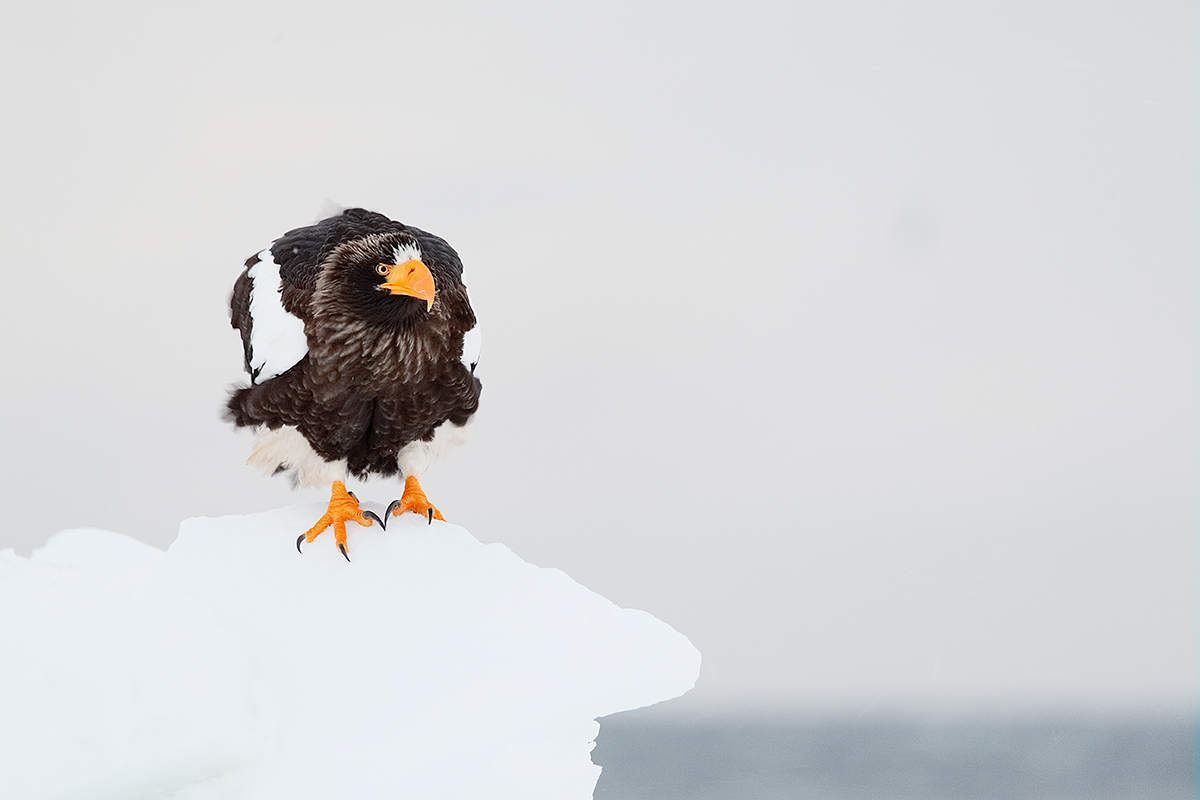
|
|
This sharp image of a Steller’s Sea Eagle on an icy perch was created on the morning of February 22, 2014 at 6:04:47am on the Japan in Winter IPT with the Gitzo 3532 LS carbon fiber tripod, the Mongoose M3.6 head, the Canon EF 200-400mm f/4L IS USM Lens with Internal 1.4x Extender (with the internal TC in place at 560mm) and the Canon EOS-1D X. ISO Safety Shift yielded ISO 2500. Evaluative metering +2 stops as framed in Tv mode: 1/60 sec. at f/6.3. Color temperature 10,000K.
Three sensors to the left of the Central Sensor/AI Servo-Surround/Rear Focus AF on the bird’s breast was active at the moment of exposure. Click here to see the latest version of the Rear Focus Tutorial. Click on the image to see a larger version.
Image #2: Steller’s Sea on Icy Perch
|
Want Sharp?
If you want to try to create sharp images of perched birds in the low light of pre-dawn simply raise the shutter speed to something that you are comfortable with, focus, and fire away. To create the image above I engaged the internal TC, raised the shutter speed from 1/30 to 1/60 sec., and was good to go. Note that the second image was created exactly 45 seconds after the first image.
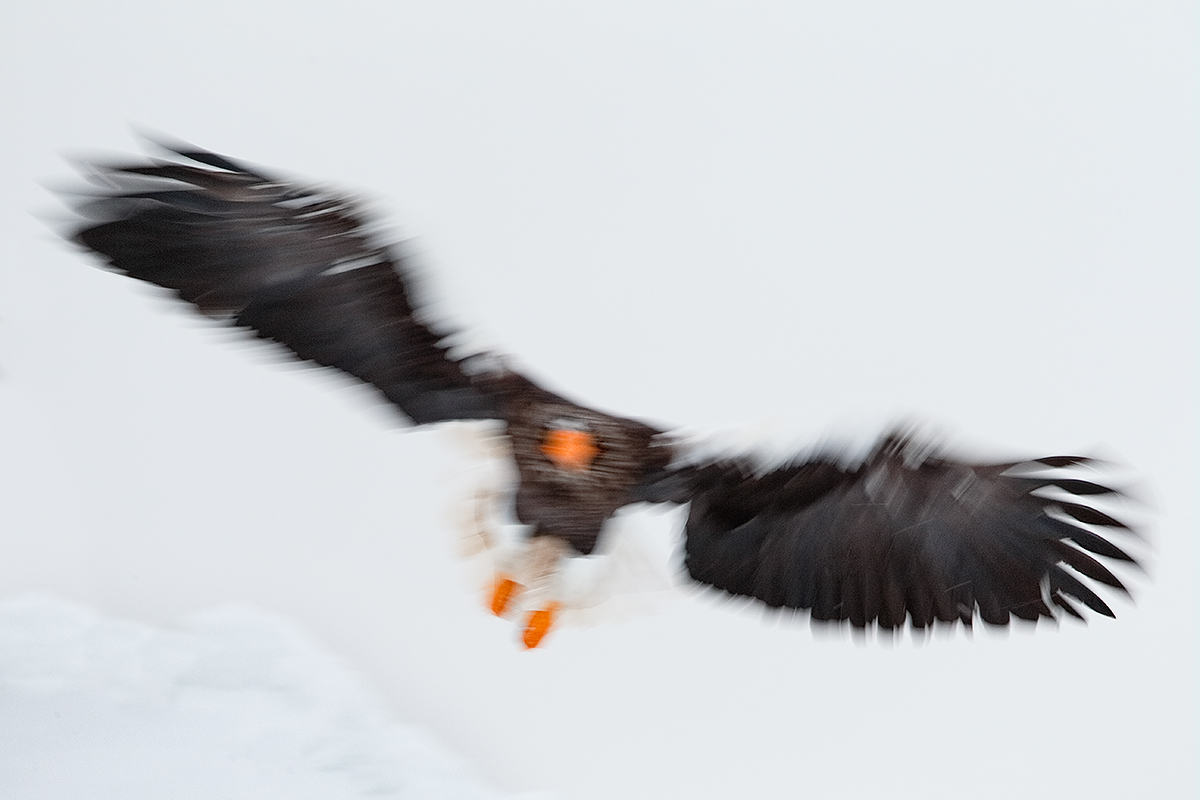
|
|
This image of a Steller’s Sea Eagle braking in flight was created on the morning of February 22, 2014 at 6:05:01am on the Japan in Winter IPT with the Gitzo 3532 LS carbon fiber tripod, the Mongoose M3.6 head, the Canon EF 200-400mm f/4L IS USM Lens with Internal 1.4x Extender (with the internal TC in place at 560mm) and the Canon EOS-1D X. ISO Safety Shift yielded ISO 1600. Evaluative metering +2 stops as framed in Tv mode: 1/60 sec. at f/5.6. Color temperature 10,000K.
Central Sensor/AI Servo-Surround/Rear Focus AF just caught the top of the bird’s head and was active at the moment of exposure. Click here to see the latest version of the Rear Focus Tutorial. Click on the image to see a larger version.
Image #3: Steller’s Sea Braking in Flight Blur
|
1/60 sec. Works Both Ways
With perched birds folks with good sharpness techniques should be able to make sharp images at 1/60 sec. With birds in flight at fairly close range the same shutter speed can be used to create pleasing blurs. It’s a best of both worlds situation.
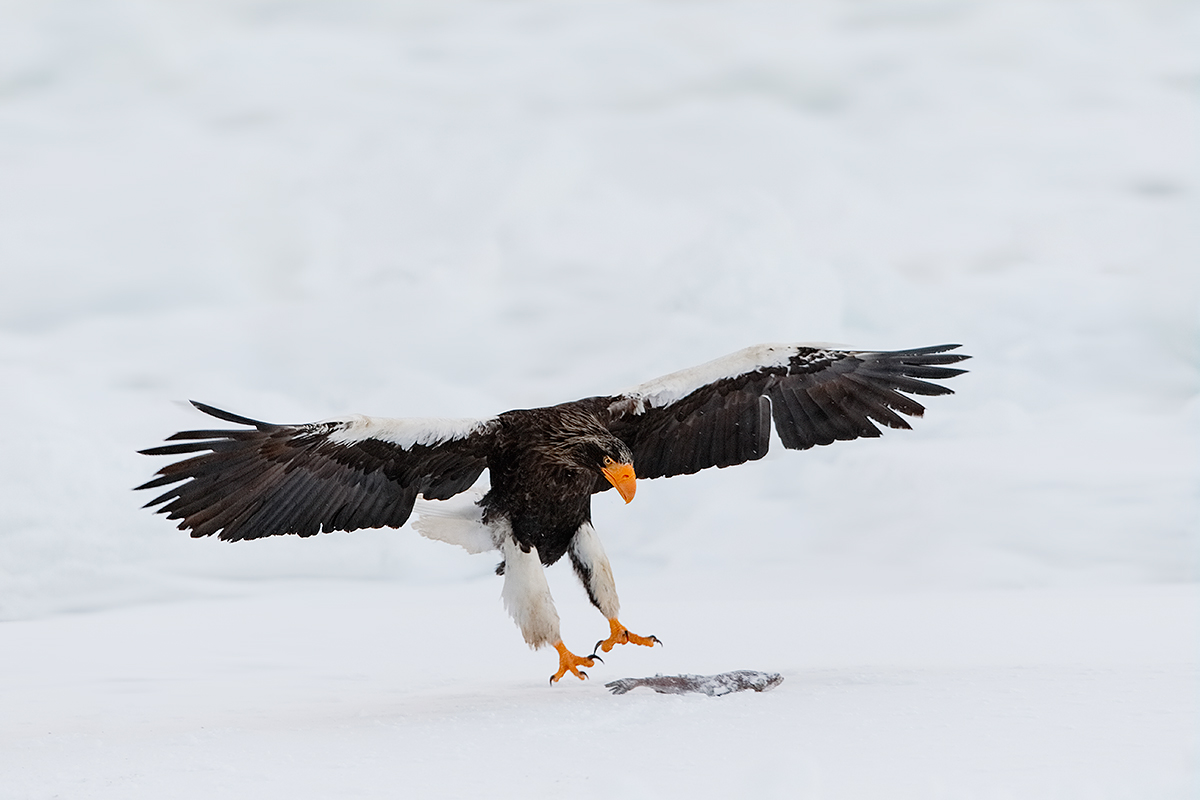
|
|
This Steller’s Sea Eagle image was created on the morning of February 21, 2014 at 6:33am on the Japan in Winter IPT with the Canon EF 200-400mm f/4L IS USM Lens with Internal 1.4x Extender (hand held with the internal extender in place at 473mm) and the Canon EOS-1D X. ISO 1600. Evaluative metering +2 stops off the ice: 1/500 sec. at f/5.6 in Manual mode. Color Temperature: 9,000K.
Central Sensor/AI Servo-Surround/Rear Focus AF just caught the top of the bird’s head and was active at the moment of exposure. Click here to see the latest version of the Rear Focus Tutorial. Click on the image to see a larger version.
Image #4: Striking Steller’s Sea Eagle
|
Getting the Blue Out
Even at 10,000 Kelvin all of the pre-dawn images had strong blue casts. I came up with a great way to lose the blue cast and get perfect whites with a single click. When converting in Canon’s Digital Photo Professional I simple clicked on Click White Balance and then clicked on the snow. Voila. Nothing could be simpler. With the four images here no other color corrections were necessary.
Your Favorite?
Please take a moment to leave a comment and let us know which of the 4 images above is your favorite, and do let us know why.
The DPP RAW Conversion Guide
To learn why I use Canon’s Digital Photo Professional (DPP) to convert every image that I work on, click here.
Support the BAA Blog. Support the BAA Bulletins: Shop B&H here!
We want and need to keep providing you with the latest free information, photography and Photoshop lessons, and all manner of related information. Show your appreciation by making your purchases immediately after clicking on any of our B&H or Amazon Affiliate links in this blog post. Remember, B&H ain’t just photography!


 


Amazon
Everyone buys something from Amazon, be it a big lens or deodorant. Support the blog by starting your search by clicking on the logo-link below. No purchase is too small to be appreciated; they all add up. Why make it a habit? Because I make it a habit of bringing you new images and information on an almost daily basis.
Typos
In all blog posts and Bulletins, feel free to e-mail or to leave a comment regarding any typos, wrong words, misspellings, omissions, or grammatical errors. Just be right. 🙂
IPT Info
Many of our great trips are filling up. See especially info on the South Florida, Holland, and Nickerson Beach IPTs. Two great leaders on most trips ensure that you will receive individual attention, have all of your questions answered, and learn a ton including how to think like a pro, see the situation, and get the right exposure every time. In addition you will have fun, and make lots of great images. Click here for IPT details and general information.
February 23rd, 2014 The Streak Goes On…
I am nearly finished with this post as we sit in the Hokkaido Airport on Sunday morning getting ready for our flight to Tokyo and the bus ride to our Nagano hotel near the snow monkey park. Our Hokkaido stay was beyond wonderful. Our guide, Makoto, was masterful, his staff, amazingly helpful. And the food at the lodge was delicious, plentiful, and Japanese.
This post marks 86 straight days with a new educational blog post, a record by far that should be extended for at least another day or so, or not. Or more…. To show your appreciation for my efforts here, we ask that use our B&H and Amazon affiliate links for all of your B&H and Amazon purchases. Please check the availability of all photographic accessories in the BIRDS AS ART Online Store. We sell only what I use and depend on. We will not sell you junk. We know what you need to make creating great images easy and fun. And we are always glad to answer your gear questions via e-mail.
You can find the following items in the store: Gitzo tripods, Mongoose M3.6 and Wimberley heads, plates, low feet, and accessories, flash brackets, , Delkin e-film Pro Compact Flash Cards, LensCoat products, and our unique line-up of educational materials including ABP I & II, Digital Basics, Site and Set-up e-Guides, Canon and Nikon Camera Users and AF e-Guides, and MP-4 Photoshop video tutorials among others.
We would of course appreciate you using our B&H and Amazon affiliate links for all of your B&H and Amazon major gear, video, electronic, household, and personal purchases. For the photographic stuff mentioned in the paragraph above we would of course greatly appreciate your business. Here is a huge thank you to the many who have been using our links on a regular basis and visiting the BAA Online store as well.
I am finishing up this blog post at 9:18pm on Sunday February 23, 2014 (in Japan) thanks to the kindness of Denise Ippolito. The AC adapter for my workhorse laptop died this afternoon and Denise bravely allowed me to try her brick to charge my machine even though the voltages were slightly different. I shall remain indebted to her 🙂
|
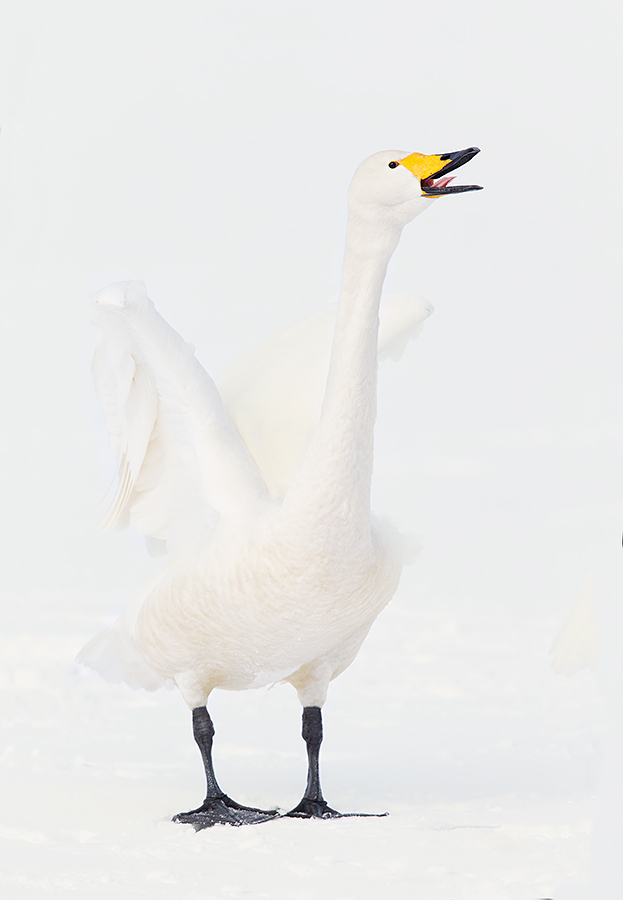
|
|
This displaying Whooper Swan was photographed at 9:04am on February 20, 2014 on our great swan morning at Lake Kussharo on the Japan in Winter IPT with the Gitzo 3532 LS carbon fiber tripod, the Mongoose M3.6 head, the Canon EF 600mm f/4L IS II USM lens, the Canon 1.4x EF Extender III (Teleconverter), and the Canon EOS-1D X. ISO 400. Evaluative metering +1 2/3 stops off the snow: 1/1000 sec. at f/5.6 in Manual mode. Color temperature: 6000K.
61-Point/AI Servo Rear Focus AF chose three sensors that fell on the front of the bird’s neck nicely on the plane of the bird’s face and was of course active at the moment of exposure. Click here to see the latest version of the Rear Focus Tutorial. Click on the image to see a larger version.
Image #1: Displaying Whooper Swan Vertical
|
Isolation at 840mm
The 600mm f/4L IS with the 1.4X III TC on a full frame body allows the photographer to isolate the subject. By choosing the right perspective the 840mm focal length (approximately 16.8X magnification) enables the photographer to come up with clean backgrounds free of distracting elements that often would include other birds.
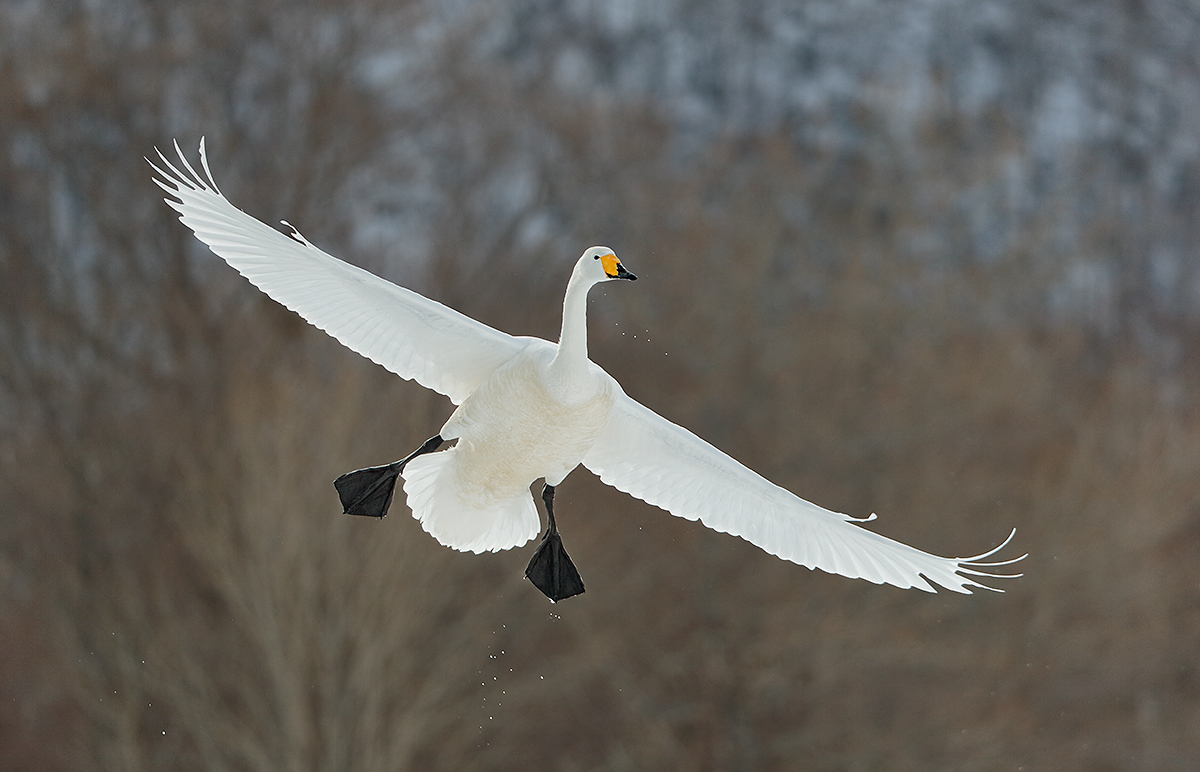
|
|
This incoming Whooper Swan image was created at 8:11am on February 20, 2014 on our great swan morning at Lake Kussharo on the Japan in Winter IPT with the Gitzo 3532 LS carbon fiber tripod, the Mongoose M3.6 head, the Canon EF 600mm f/4L IS II USM lens, the Canon 1.4x EF Extender III (Teleconverter), and the Canon EOS-1D X. ISO 800. Evaluative metering +1 2/3 stops off the snow: 1/2000 sec. at f/5.6 in Manual mode. Color temperature: 7000K.
Central sensor/AI Servo/Surround Rear Focus AF on the bird’s left breast was active at the moment of exposure. Note that the point of focus was nicely on the same plane as the bird’s face. Click here to see the latest version of the Rear Focus Tutorial. Click on the image to see a larger version.
Image #2: Incoming Whooper Swan
|
Flight at 840mm
A comment on the blog the other day asked “Is it true that AI Servo AF flight sequences made with a super-telephoto lens and a 1.4X TC would always include several out-of-focus images?” I replied that such assertions were ridiculous. With all of my big lenses and the 1.4X III TC virtually all images in a flight sequence are sharp on the bird’s eye. When many folks get one or more unsharp images in a flight sequence they are quick to blame the camera, the lens, the teleconverter, or all three. I look in the mirror and assume operator error. Most times I can put my finger on the reason that an image is not sharp. The most common one (often overlooked) is that the active AF sensor was on an area with little or no contrast. AF needs contrast to be able to see and to be able to track the moving subject. The next most common reason is pure operator error; the photographer was late in framing the image and acquiring focus; the shutter button was depressed before the AF system began to track the subject.
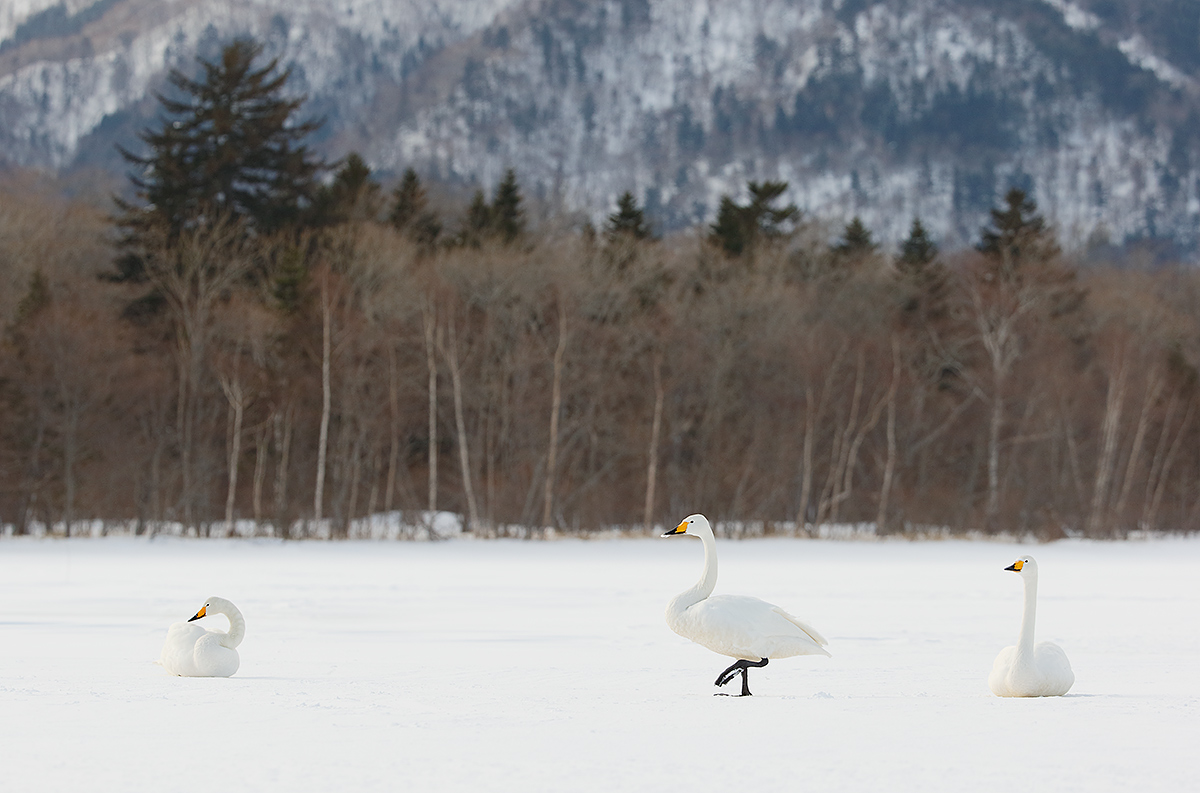
|
|
These Whooper Swans were photographed on the morning of February 20, 2014 at 7:55am on the Japan in Winter IPT with the Canon EF 200-400mm f/4L IS USM Lens with Internal 1.4x Extender (hand held at 200mm) and the Canon EOS-1D X. ISO 800. Evaluative metering +2 stops off the snow worked out to +1/3 stop as framed: 1/1250 sec. at f/5.6 in Manual mode. Color temperature: 7000K.
Central Sensor/AI Servo-Surround/Rear Focus AF on the head of the bird in the middle and re-compose slightly while panning slowly. Click here to see the latest version of the Rear Focus Tutorial. Click on the image to see a larger version.
Image #3: Whooper Swans on Frozen Lake
|
The Good and the Bad
What are the pleasing elements in the image above? What do you like about it? What is the biggest negative?
Note again the great versatility of the 200-400; dis-engaging the internal TC and zooming out allowed me to quickly get to 200mm and create the image that I wanted that included the swans and the distant woods. Learn more about the versatility of the 200-400 here.
|
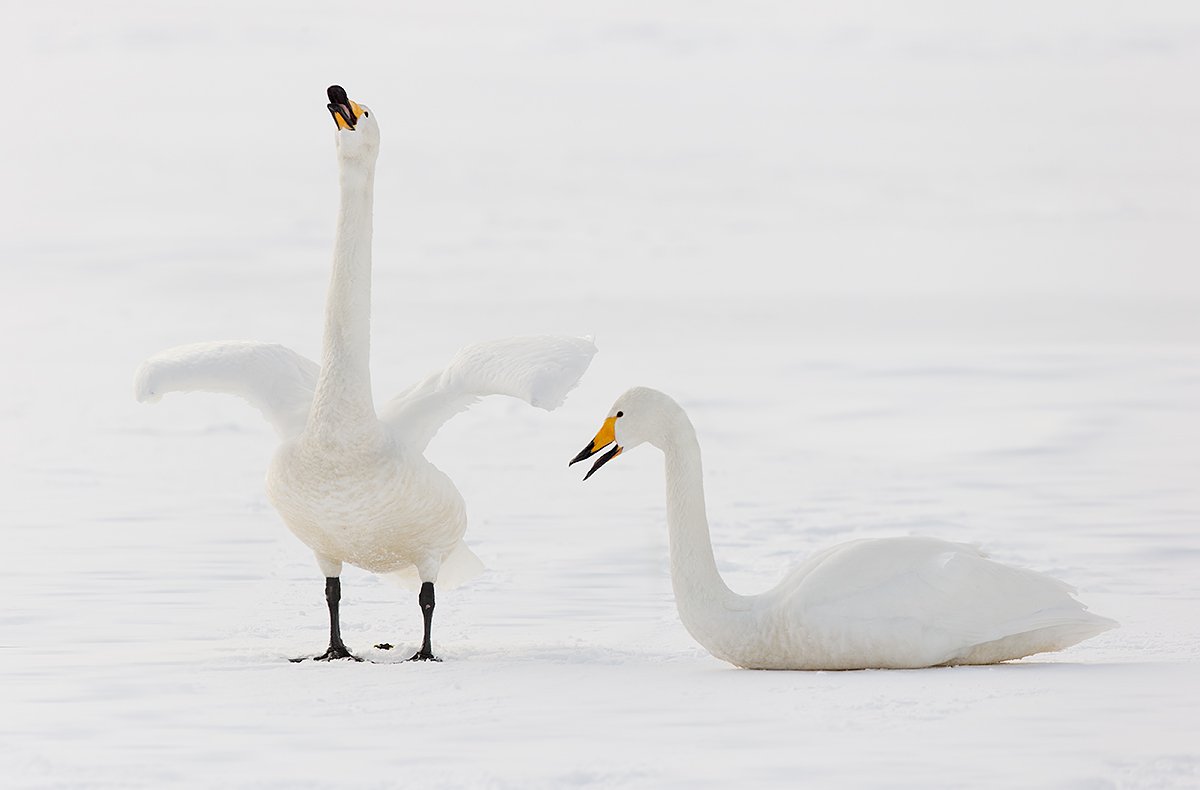
|
|
This pair of Whooper Swans was photographed on the morning of February 20, 2014 at 8:21am on the Japan in Winter IPT with the Canon EF 200-400mm f/4L IS USM Lens with Internal 1.4x Extender (hand held at 400mm) and the Canon EOS-1D X. ISO 800. Evaluative metering +1 2/3 stops off the ice: 1/800 sec. at f/6.3 in Manual mode. Color temperature: 7000K.
Central Sensor/AI Servo-Surround/Rear Focus AF on the eye of the right hand bird and re-compose slightly. Click here to see the latest version of the Rear Focus Tutorial. Click on the image to see a larger version.
Image #4: Pair of Whooper Swans/Male Calling
|
Action City
On our first morning at Lake Kussharo we enjoyed swans and mist and steam. On our follow-up visit we enjoyed virtually non-stop action for three hours with incoming flight and displaying birds. After that many of the birds went to sleep and I went to work with the 600 and the 2X III TC. I will share those images with you here at some point.
Your Favorite?
Please take a moment to leave a comment and let us know which of the 4 images above is your favorite, and do let us know why.
Advanced Composition and Image Design
Learn to create more pleasing images by studying the section on Advanced Composition and Image Design in The Art of Bird Photography II (ABP II: 916 pages/900+ images on CD only.)

|
|
Images copyright 2012: Denise Ippolito & Arthur Morris. Card design by Denise Ippolito. Click on the image to enjoy a spectacular larger version.
|
Holland 2014 7 1/2-Day/8-Night: A Creative Adventure/BIRDS AS ART/Tulips & A Touch of Holland IPT. April 17-April 24, 2014: $4995 Limit: 12/Openings: 5
We still have room for 5 more flower photographers on this great trip.
Join Denise Ippolito, Flower Queen and the author of “Bloomin’ Ideas,” and Arthur Morris, Canon Explorer of Light Emeritus and one of the planet’s premier photographic educators for a great trip to Holland in mid-April 2014. Day 1 of the IPT will be April 17, 2014. We will have a short afternoon get-together and then our first photographic session at the justly-famed Keukenhof. Most days we will return to the hotel for lunch, image sharing and a break. On Day 8, April 24, we will enjoy both morning and afternoon photography sessions.
The primary subjects will be tulips and orchids at Keukenhof and the spectacularly amazing tulip, hyacinth, and daffodil bulb fields around Lisse. In addition we will spend one full day in Amsterdam. There will be optional visits the Van Gogh Museum in the morning and the Anne Frank House in the afternoon; there will be plenty of time for street photography as well. And some great food. On another day we will have a wonderful early dinner at Kinderdijk and then head out with our gear to photograph the windmills and possibly some birds for those who bring their longs lenses. We will spend an afternoon in the lovely Dutch town of Edam where we will do some street photography and enjoy a superb dinner. All lodging, ground transportation, entry fees, and meals (from dinner on Day 1 through dinner on Day 7) are included. For those who will be bringing a big lens we will likely have an optional bird photography afternoon or two.
Click here for additional info or to register.

|
|
Join me for the 2014 Tanzania Summer Safari!
|
2014 Tanzania Summer Safari, 14-day African Adventure/leave the US on August 9. Fly home on August 24: $12,999.
Co-leaders Todd Gustafson & Arthur Morris. The limit is 12. Three photographers/van; you get your own row of seats. Our trip is a bit more expensive than the average safari for good reason. It is the best. We have the best driver guides with a total of decades of experience. They have been trained over the years by Todd and by me to drive with photography in mind. We have the best and most knowledgeable leaders. We stay in the best lodges and camps. We hope that you will join us for what will be Todd’s 35th African safari, and my 8th.
If you are seriously interested please e-mail me; I will be glad to send you the illustrated PDF with the complete itinerary and deposit info.
What else makes this expedition unique?
•Pre-trip consultation and camera equipment advice
•Award-winning photographers as your guides
•A seamless itinerary visiting the right locations at the best time of year
•Hands-on photography instruction in the field
•Specially designed three roof-hatch photo safari vehicles
•Proprietary materials for preparation, including free copy of “A Photographer’s Guide to Photographing in East Africa.”
•Post-safari image critiques
All-inclusive (double-occupancy) except for your flights to and from Kilamajaro Airport, bar drinks, soda & water (except at the Intimate Tented Camp where everything is free for our entire stay), tips for drivers and camp staff, personal items, and trip insurance.

|
|
Breathe deeply, bite the bullet, and live life to its fullest; we all get only one ride on the merry-go-round… Join me on this great trip.
Click on the image to enjoy a larger version.
|
The Southern Ocean…
If you would like to explore the possibility of joining me on the Cheesemans’ Ecology Safaris Antarctica/The Extended Expedition Voyage< trip: Antarctic Peninsula, South Georgia and Falkland Islands: December 13, 2014 to January 10, 2015, click here for additional information and then shoot me an e-mail.
The DPP RAW Conversion Guide
To learn why I use Canon’s Digital Photo Professional (DPP) to convert every image that I work on, click here.
Support the BAA Blog. Support the BAA Bulletins: Shop B&H here!
We want and need to keep providing you with the latest free information, photography and Photoshop lessons, and all manner of related information. Show your appreciation by making your purchases immediately after clicking on any of our B&H or Amazon Affiliate links in this blog post. Remember, B&H ain’t just photography!


 


Amazon
Everyone buys something from Amazon, be it a big lens or deodorant. Support the blog by starting your search by clicking on the logo-link below. No purchase is too small to be appreciated; they all add up. Why make it a habit? Because I make it a habit of bringing you new images and information on an almost daily basis.
Typos
In all blog posts and Bulletins, feel free to e-mail or to leave a comment regarding any typos, wrong words, misspellings, omissions, or grammatical errors. Just be right. 🙂
IPT Info
Many of our great trips are filling up. See especially info on the South Florida, Holland, and Nickerson Beach IPTs. Two great leaders on most trips ensure that you will receive individual attention, have all of your questions answered, and learn a ton including how to think like a pro, see the situation, and get the right exposure every time. In addition you will have fun, and make lots of great images. Click here for IPT details and general information.
February 22nd, 2014 The Streak Goes On…
I am working on this blog post again at 5:05am on Saturday February 22 here in Japan. It is 3:05pm in Florida on February 21.
This post marks 85 straight days with a new educational blog post, a record by far that should be extended for at least another day or so, or not. Or more…. It appears that our lodge has great internet. To show your appreciation for my efforts here, we ask that use our B&H and Amazon affiliate links for all of your B&H and Amazon purchases. Please check the availability of all photographic accessories in the BIRDS AS ART Online Store. We sell only what I use and depend on. We will not sell you junk. We know what you need to make creating great images easy and fun. And we are always glad to answer your gear questions via e-mail.
You can find the following items in the store: Gitzo tripods, Mongoose M3.6 and Wimberley heads, plates, low feet, and accessories, flash brackets, , Delkin e-film Pro Compact Flash Cards, LensCoat products, and our unique line-up of educational materials including ABP I & II, Digital Basics, Site and Set-up e-Guides, Canon and Nikon Camera Users and AF e-Guides, and MP-4 Photoshop video tutorials among others.
We would of course appreciate you using our B&H and Amazon affiliate links for all of your B&H and Amazon major gear, video, electronic, household, and personal purchases. For the photographic stuff mentioned in the paragraph above we would of course greatly appreciate your business. Here is a huge thank you to the many who have been using our links on a regular basis and visiting the BAA Online store as well.
I am finishing up this blog post at 4:22pm Japan time on Saturday February 22–2:22am on the same day in Florida. We enjoyed a 3rd great eagle boat trip this morning and then drove back to our lodge. Tomorrow we fly back to Tokyo for the Snow Monkey segment of this great trip. Today’s blog post took more than 3 hours to prepare.
|
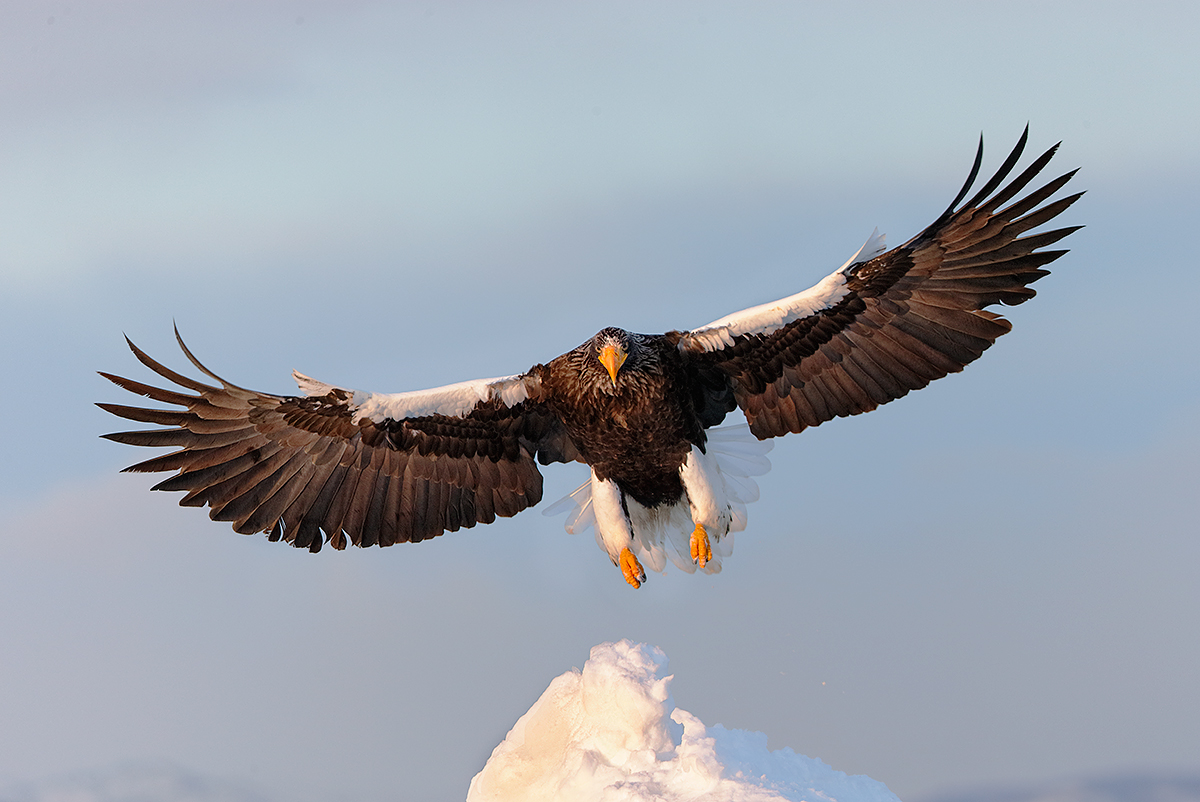
|
|
This image of a landing Steller’s Sea Eagle was created on the morning of February 21, 2014 at 6:35am on the Japan in Winter IPT with the Canon EF 200-400mm f/4L IS USM Lens with Internal 1.4x Extender (hand held with the internal extender in place at 325mm) and the Canon EOS-1D X. ISO 1600. Evaluative metering +2 stops off the ice: 1/800 sec. at f/5.6 in Manual mode. AWB.
Central Sensor/AI Servo-Surround/Rear Focus AF on the bird’s breast right below the head was active at the moment of exposure. Click here to see the latest version of the Rear Focus Tutorial. Click on the image to see a larger version.
Image #1: Landing Stellar’s Sea Eagle
|
Malcolm Mackenzie Can Die a Happy Man
Things were not looking good for our Rausu sea eagle trips…. First, there was no sea ice. No ice equals no eagles. Next, we were delayed for 1 1/2 days due to a huge snow storm up north with 15 foot drifts; all roads to Rausu were closed. Finally we made it to Rausu on the late afternoon of February 20, but the sea ice reports were sketchy at best.
Malcolm Mackenzie was worried. His main reason for making the Japan trip was to see and photograph the Steller’s Sea Eagles. I was anything but confident but had a sneaking suspicion that we might luck out. The group was on the boat and we were underway at 6am on the 21st. By 6:30am the mate was feeding the birds and the skies were filled with Steller’s and White-tailed Sea Eagles, Slaty-backed, Glaucous-winged, and Glaucous Gulls of all ages, and Large-billed Crows. The light was gorgeous and the wind was perfect.
My 11th sea eagle trip turned out to be the best ever. Everyone was thrilled and Malcolm–who filled a 128gb card–was ecstatic.
Image Question
Considering that the image above was created at 325mm why did I have the internal 1.4X TC in place?
The Astounding Versatility of the Canon EF 200-400 with Internal 1.4X Extender on the Sea Eagle Boat
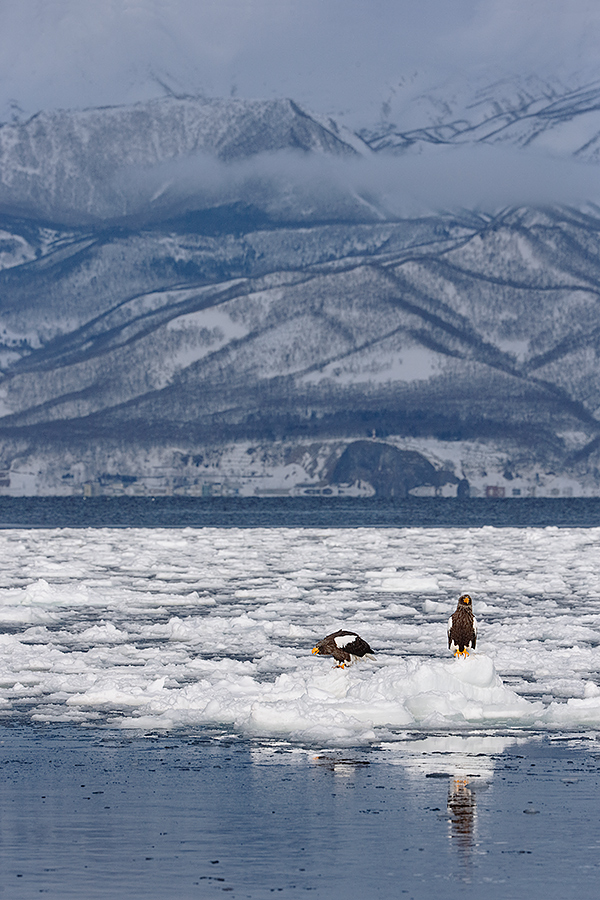
|
|
This wide image of two Steller’s Sea Eagles on the pack ice was also created on the morning of February 21, 2014 at 7:27am on the Japan in Winter IPT with the Canon EF 200-400mm f/4L IS USM Lens with Internal 1.4x Extender (hand held at 239mm) and the Canon EOS-1D X. ISO 1600. Evaluative metering +1 1/3 stops as framed: 1/2000 sec. at f/7.1 in Manual mode was a bit dark. AWB.
Central Sensor/AI Servo-Surround/Rear Focus AF on the right hand bird and re-compose. Click here to see the latest version of the Rear Focus Tutorial. Click on the image to see a larger version.
Image #2: Sea eagles and Rausu
|
The Astounding Versatility of the Canon EF 200-400 with Internal 1.4X Extender on the Sea Eagle Boat
It is hard to believe that the three images here were created with the same lens. As noted here previously the versatility of the Canon 200-400 is both incredible and–if image quality is considered, unmatched. And with the addition of an external 1.4X III TC–s the image immediately below–the focal length range can be extended to 784mm with both TCs in place.
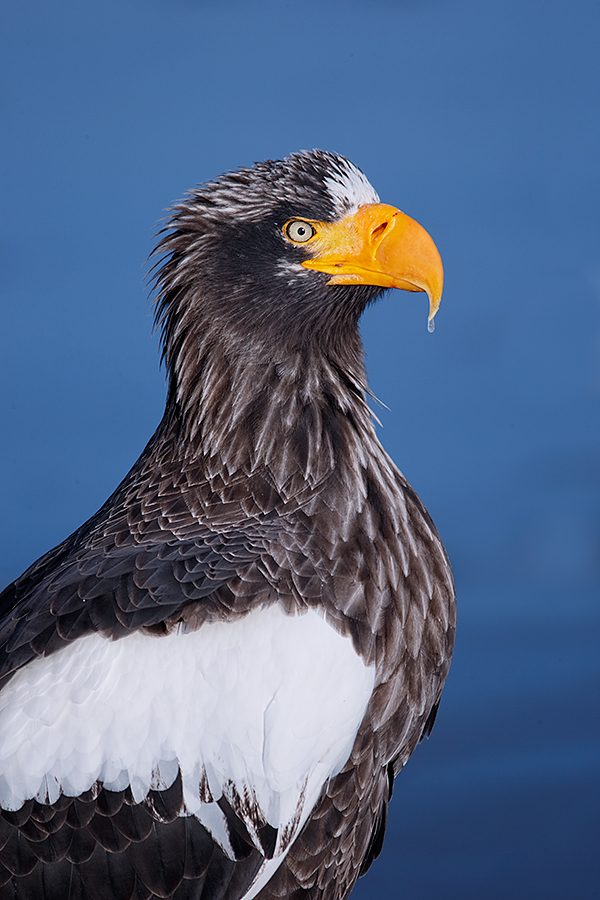
|
|
This vertical front-end portrait of a Steller’s Sea Eagle was created on the morning of February 21, 2014 at 7:22am on the Japan in Winter IPT with the Canon EF 200-400mm f/4L IS USM Lens with Internal 1.4x Extender, an external Canon Extender EF 1.4X III (hand held at the maximum 784mm) and the Canon EOS-1D X. ISO 1600. Evaluative metering +1/3 stop as framed: 1/800 sec. at f/8 in Manual. AWB.
Central Sensor/AI Servo-Surround/Rear Focus AF on the bird’s neck was active at the moment of exposure. Click here to see the latest version of the Rear Focus Tutorial. Click on the image to see a larger version.
Image #3: Steller’s Sea Eagle Vertical Front End Portrait
|
Your Favorite?
Please take a moment to leave a comment and let us know which of the 3 images above is your favorite, and do let us know why.
Age?
Can anyone age the bird in the image above based on plumage?
Advanced Composition and Image Design
Learn to create more pleasing images by studying the section on Advanced Composition and Image Design in The Art of Bird Photography II (ABP II: 916 pages/900+ images on CD only.)
|

|
|
Images copyright 2012: Denise Ippolito & Arthur Morris. Card design by Denise Ippolito. Click on the image to enjoy a spectacular larger version.
|
Holland 2014 7 1/2-Day/8-Night: A Creative Adventure/BIRDS AS ART/Tulips & A Touch of Holland IPT. April 17-April 24, 2014: $4995 Limit: 12/Openings: 5
We still have room for 5 more flower photographers on this great trip.
Join Denise Ippolito, Flower Queen and the author of “Bloomin’ Ideas,” and Arthur Morris, Canon Explorer of Light Emeritus and one of the planet’s premier photographic educators for a great trip to Holland in mid-April 2014. Day 1 of the IPT will be April 17, 2014. We will have a short afternoon get-together and then our first photographic session at the justly-famed Keukenhof. Most days we will return to the hotel for lunch, image sharing and a break. On Day 8, April 24, we will enjoy both morning and afternoon photography sessions.
The primary subjects will be tulips and orchids at Keukenhof and the spectacularly amazing tulip, hyacinth, and daffodil bulb fields around Lisse. In addition we will spend one full day in Amsterdam. There will be optional visits the Van Gogh Museum in the morning and the Anne Frank House in the afternoon; there will be plenty of time for street photography as well. And some great food. On another day we will have a wonderful early dinner at Kinderdijk and then head out with our gear to photograph the windmills and possibly some birds for those who bring their longs lenses. We will spend an afternoon in the lovely Dutch town of Edam where we will do some street photography and enjoy a superb dinner. All lodging, ground transportation, entry fees, and meals (from dinner on Day 1 through dinner on Day 7) are included. For those who will be bringing a big lens we will likely have an optional bird photography afternoon or two.
Click here for additional info or to register.

|
|
Join me for the 2014 Tanzania Summer Safari!
|
2014 Tanzania Summer Safari, 14-day African Adventure/leave the US on August 9. Fly home on August 24: $12,999.
Co-leaders Todd Gustafson & Arthur Morris. The limit is 12. Three photographers/van; you get your own row of seats. Our trip is a bit more expensive than the average safari for good reason. It is the best. We have the best driver guides with a total of decades of experience. They have been trained over the years by Todd and by me to drive with photography in mind. We have the best and most knowledgeable leaders. We stay in the best lodges and camps. We hope that you will join us for what will be Todd’s 35th African safari, and my 8th.
If you are seriously interested please e-mail me; I will be glad to send you the illustrated PDF with the complete itinerary and deposit info.
What else makes this expedition unique?
•Pre-trip consultation and camera equipment advice
•Award-winning photographers as your guides
•A seamless itinerary visiting the right locations at the best time of year
•Hands-on photography instruction in the field
•Specially designed three roof-hatch photo safari vehicles
•Proprietary materials for preparation, including free copy of “A Photographer’s Guide to Photographing in East Africa.”
•Post-safari image critiques
All-inclusive (double-occupancy) except for your flights to and from Kilamajaro Airport, bar drinks, soda & water (except at the Intimate Tented Camp where everything is free for our entire stay), tips for drivers and camp staff, personal items, and trip insurance.

|
|
Breathe deeply, bite the bullet, and live life to its fullest; we all get only one ride on the merry-go-round… Join me on this great trip.
Click on the image to enjoy a larger version.
|
The Southern Ocean…
If you would like to explore the possibility of joining me on the Cheesemans’ Ecology Safaris Antarctica/The Extended Expedition Voyage< trip: Antarctic Peninsula, South Georgia and Falkland Islands: December 13, 2014 to January 10, 2015, click here for additional information and then shoot me an e-mail.
The DPP RAW Conversion Guide
To learn why I use Canon’s Digital Photo Professional (DPP) to convert every image that I work on, click here.
Support the BAA Blog. Support the BAA Bulletins: Shop B&H here!
We want and need to keep providing you with the latest free information, photography and Photoshop lessons, and all manner of related information. Show your appreciation by making your purchases immediately after clicking on any of our B&H or Amazon Affiliate links in this blog post. Remember, B&H ain’t just photography!


 


Amazon
Everyone buys something from Amazon, be it a big lens or deodorant. Support the blog by starting your search by clicking on the logo-link below. No purchase is too small to be appreciated; they all add up. Why make it a habit? Because I make it a habit of bringing you new images and information on an almost daily basis.
Typos
In all blog posts and Bulletins, feel free to e-mail or to leave a comment regarding any typos, wrong words, misspellings, omissions, or grammatical errors. Just be right. 🙂
IPT Info
Many of our great trips are filling up. See especially info on the South Florida, Holland, and Nickerson Beach IPTs. Two great leaders on most trips ensure that you will receive individual attention, have all of your questions answered, and learn a ton including how to think like a pro, see the situation, and get the right exposure every time. In addition you will have fun, and make lots of great images. Click here for IPT details and general information.
February 21st, 2014 And The Insane Streak Goes On
I wrote this post midday on Thursday in Japan on the way from Lake Kussharo to Rausu where we–especially Malcolm MacKenzie–are hoping to get out on the boat to photograph the Steller’s and White-tailed Sea Eagles… The road to Rausu opened this morning. Now we just need some sea ice within range…. We had an absolutely amazing morning with the swans with tons of flight and displaying action and wide angle & 1200mm chances as well. Oh, and I forgot fish eye opps. And every focal length in between.
This post marks 84 straight days with a new educational blog post, a record by far that should be extended for at least another day or so, or not. Or more…. It appears that our lodge has great internet. To show your appreciation for my efforts here, we ask that use our B&H and Amazon affiliate links for all of your B&H and Amazon purchases. Please check the availability of all photographic accessories in the BIRDS AS ART Online Store. We sell only what I use and depend on. We will not sell you junk. We know what you need to make creating great images easy and fun. And we are always glad to answer your gear questions via e-mail.
You can find the following items in the store: Gitzo tripods, Mongoose M3.6 and Wimberley heads, plates, low feet, and accessories, flash brackets, , Delkin e-film Pro Compact Flash Cards, LensCoat products, and our unique line-up of educational materials including ABP I & II, Digital Basics, Site and Set-up e-Guides, Canon and Nikon Camera Users and AF e-Guides, and MP-4 Photoshop video tutorials among others.
We would of course appreciate you using our B&H and Amazon affiliate links for all of your B&H and Amazon major gear, video, electronic, household, and personal purchases. For the photographic stuff mentioned in the paragraph above we would of course greatly appreciate your business. Here is a huge thank you to the many who have been using our links on a regular basis and visiting the BAA Online store as well.
Today’s blog post took 2 hours to prepare. Enjoy. Update from 6pm Japan time on February 21: after much trepidation we absolutely killed, killed, killed on our morning and afternoon eagle boat trips. More tomorrow.
Lying Down on the Job
We were all hot to photograph a crane lying down on the snow resting. We had a few near misses where a bird would lie down only to be surrounded by other cranes or stand back up almost immediately. On our last afternoon at the Itoh sanctuary I made a few frames of the bird above but was less than thrilled that the crane did not give me a decent head angle and that there were a pair of out-of-focus crane legs in the upper right corner. Then I decided to get low.
|

|
|
This, the same resting Red-crowned Crane, was photographed with the hand held Canon EF 600mm f/4L IS II USM lens, the Canon 1.4x EF Extender III (Teleconverter), and the Canon EOS-1D X. The rig was supported by the lowest fence rail. ISO 800. Evaluative metering +1 2/3 stops off the snow: 1/1000 sec. at f/5.6 in Manual mode. Color temperature: 7000K.
Central sensor/AI Servo/Surround Rear Focus AF on the bird’s eye and re-compose. Click here to see the latest version of the Rear Focus Tutorial. Click on the image to see a larger version.
|
Getting Low
I took the 600 off the tripod, got down in the snow, and supported the lens on the lowest fence rail. I created the image above and quickly thereafter, the image below, and felt immediately that I had gotten too low as there was not quite enough snow between the top of the bird’s head and the distant woods.

|
|
This, again the same resting Red-crowned Crane, was photographed with the hand held Canon EF 600mm f/4L IS II USM lens, the Canon 1.4x EF Extender III (Teleconverter), and the Canon EOS-1D X. The rig was supported by the lowest fence rail. ISO 800. Evaluative metering +1 2/3 stops off the snow: 1/1000 sec. at f/5.6 in Manual mode. Color temperature: 7000K.
Central sensor/AI Servo/Surround Rear Focus AF on the bird’s eye and re-compose. Click here to see the latest version of the Rear Focus Tutorial. Click on the image to see a larger version.
|
When Supporting the Lens
In situations like the one above where you are supporting a big lens–in this case on a fence rail, it is important not to rest the focusing ring on the support else focus will likely be thrown off when you re-compose. The same goes when working on a bean bag. And that is true whether you are using Rear Focus or One-Shot AF. If you can work in AI Servo AF and keep AF active at the moment of exposure your images will likely be sharp.
Soon after I made the image above the resting crane was surrounded by other cranes. Nature called so I headed to the rest room.
The Blue Color Casts
As I knew that the image below would be my favorite, I did not do any final color corrections to the three images above. Folks with a discerning eye for color will note the small but definite BLUE cast in each of the images above. With the image above I ran an Average Blur Color Balance adjustment layer at 80% and followed that up by reducing the BLUE saturation 100%. The brightest WHITEs on the snow came in at R= 209m G=210, B=210, just about perfect.
You can learn do do an Average Blur Color Balance (and to create a matching action as well) in my Digital Basics File. as detailed in my Digital Basics File, an instructional PDF that is sent via e-mail. Digital Basics includes my complete digital workflow, dozens of great Photoshop tips, the use of Contrast Masks, several different ways of expanding canvas, all of my time-saving Keyboard Shortcuts, Quick Masking, Layer Masking, and NIK Color Efex Pro basics, my killer image clean-up techniques, Digital Eye Doctor, and lots more.
Learn the details of advanced Quick Masking techniques in APTATS I. Mention this blog post and apply a $5 discount with phone orders only. Learn advanced Layer Masking Techniques in APTATS II. Mention this blog post and apply a $5 discount with phone orders only. by the pair, APTATS I and APTATS II and we will be glad to apply at $15 discount with phone orders only.
The DPP RAW Conversion Guide
Big News
After seeing the accurate colors that I get from my DPP RAW conversions Japan in Winter co-leader Paul McKenzie is switching to DPP conversions and Denise Ippolito is considering doing the same. Now that is amazing…. To learn why I use Canon’s Digital Photo Professional (DPP) to convert every image that I work on, click here.
|

|
|
This, again the same resting Red-crowned Crane, was photographed with the hand held Canon EF 600mm f/4L IS II USM lens, the Canon 1.4x EF Extender III (Teleconverter), and the Canon EOS-1D X. The rig was supported by the middle fence rail. ISO 800. Evaluative metering +1 2/3 stops off the snow: 1/1250 sec. at f/5.6 in Manual mode. Color temperature: 7000K.
Central sensor/AI Servo/Surround Rear Focus AF on the bird’s eye and re-compose. Click here to see the latest version of the Rear Focus Tutorial. Click on the image to see a larger version.
|
The Middle Rail
When I returned from the john I was surprised to see the crane still lying on the ground and was thrilled to see that it was now in the clear and giving up a nice parallel head angle. Instead of resting the lens on the bottom rail I went off the middle rail. This yielded the desired all snow background. After just a few images the crane stood, walked up the gentle slope to the crane departure area, and took flight.
In Retrospect
In retrospect I decided that while I loved the final image, that the photo with the woods in the background held a different appeal. As noted above, I needed to get a bit higher to put some space between the top of the crane’s head and the tree-line. Live and learn.
|

|
|
Images copyright 2012: Denise Ippolito & Arthur Morris. Card design by Denise Ippolito. Click on the image to enjoy a spectacular larger version.
|
Holland 2014 7 1/2-Day/8-Night: A Creative Adventure/BIRDS AS ART/Tulips & A Touch of Holland IPT. April 17-April 24, 2014: $4995 Limit: 12/Openings: 5
We still have room for 5 more flower photographers on this great trip.
Join Denise Ippolito, Flower Queen and the author of “Bloomin’ Ideas,” and Arthur Morris, Canon Explorer of Light Emeritus and one of the planet’s premier photographic educators for a great trip to Holland in mid-April 2014. Day 1 of the IPT will be April 17, 2014. We will have a short afternoon get-together and then our first photographic session at the justly-famed Keukenhof. Most days we will return to the hotel for lunch, image sharing and a break. On Day 8, April 24, we will enjoy both morning and afternoon photography sessions.
The primary subjects will be tulips and orchids at Keukenhof and the spectacularly amazing tulip, hyacinth, and daffodil bulb fields around Lisse. In addition we will spend one full day in Amsterdam. There will be optional visits the Van Gogh Museum in the morning and the Anne Frank House in the afternoon; there will be plenty of time for street photography as well. And some great food. On another day we will have a wonderful early dinner at Kinderdijk and then head out with our gear to photograph the windmills and possibly some birds for those who bring their longs lenses. We will spend an afternoon in the lovely Dutch town of Edam where we will do some street photography and enjoy a superb dinner. All lodging, ground transportation, entry fees, and meals (from dinner on Day 1 through dinner on Day 7) are included. For those who will be bringing a big lens we will likely have an optional bird photography afternoon or two.
Click here for additional info or to register.

|
|
Join me for the 2014 Tanzania Summer Safari!
|
2014 Tanzania Summer Safari, 14-day African Adventure/leave the US on August 9. Fly home on August 24: $12,999.
Co-leaders Todd Gustafson & Arthur Morris. The limit is 12. Three photographers/van; you get your own row of seats. Our trip is a bit more expensive than the average safari for good reason. It is the best. We have the best driver guides with a total of decades of experience. They have been trained over the years by Todd and by me to drive with photography in mind. We have the best and most knowledgeable leaders. We stay in the best lodges and camps. We hope that you will join us for what will be Todd’s 35th African safari, and my 8th.
If you are seriously interested please e-mail me; I will be glad to send you the illustrated PDF with the complete itinerary and deposit info.
What else makes this expedition unique?
•Pre-trip consultation and camera equipment advice
•Award-winning photographers as your guides
•A seamless itinerary visiting the right locations at the best time of year
•Hands-on photography instruction in the field
•Specially designed three roof-hatch photo safari vehicles
•Proprietary materials for preparation, including free copy of “A Photographer’s Guide to Photographing in East Africa.”
•Post-safari image critiques
All-inclusive (double-occupancy) except for your flights to and from Kilamajaro Airport, bar drinks, soda & water (except at the Intimate Tented Camp where everything is free for our entire stay), tips for drivers and camp staff, personal items, and trip insurance.

|
|
Breathe deeply, bite the bullet, and live life to its fullest; we all get only one ride on the merry-go-round… Join me on this great trip.
Click on the image to enjoy a larger version.
|
The Southern Ocean…
If you would like to explore the possibility of joining me on the Cheesemans’ Ecology Safaris Antarctica/The Extended Expedition Voyage< trip: Antarctic Peninsula, South Georgia and Falkland Islands: December 13, 2014 to January 10, 2015, click here for additional information and then shoot me an e-mail.
The DPP RAW Conversion Guide
To learn why I use Canon’s Digital Photo Professional (DPP) to convert every image that I work on, click here.
Support the BAA Blog. Support the BAA Bulletins: Shop B&H here!
We want and need to keep providing you with the latest free information, photography and Photoshop lessons, and all manner of related information. Show your appreciation by making your purchases immediately after clicking on any of our B&H or Amazon Affiliate links in this blog post. Remember, B&H ain’t just photography!


 


Amazon
Everyone buys something from Amazon, be it a big lens or deodorant. Support the blog by starting your search by clicking on the logo-link below. No purchase is too small to be appreciated; they all add up. Why make it a habit? Because I make it a habit of bringing you new images and information on an almost daily basis.
Typos
In all blog posts and Bulletins, feel free to e-mail or to leave a comment regarding any typos, wrong words, misspellings, omissions, or grammatical errors. Just be right. 🙂
IPT Info
Many of our great trips are filling up. See especially info on the South Florida, Holland, and Nickerson Beach IPTs. Two great leaders on most trips ensure that you will receive individual attention, have all of your questions answered, and learn a ton including how to think like a pro, see the situation, and get the right exposure every time. In addition you will have fun, and make lots of great images. Click here for IPT details and general information.
|
|

